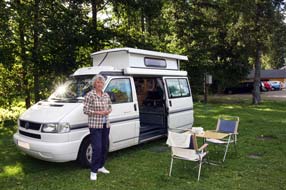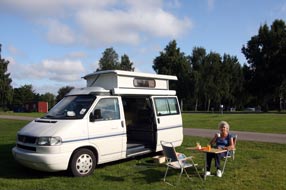|
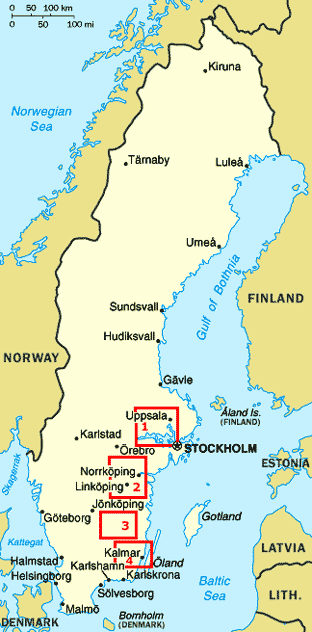 CAMPING
IN SWEDEN 2013 - Sala silver mines, Ånundshög archaeological remains near Västerås, Norrköping, Linköping,
the locks of the Göta Canal, Vadstena, Eksjö, and the Glasriket glassworks of Småland: CAMPING
IN SWEDEN 2013 - Sala silver mines, Ånundshög archaeological remains near Västerås, Norrköping, Linköping,
the locks of the Göta Canal, Vadstena, Eksjö, and the Glasriket glassworks of Småland:
Ängelsberg Bruk 18th~19th century
estate-based iron-works: leaving Uppsala, we headed west on Route 72
towards Sala, and continued beyond on the minor Route 256 to find the preserved
remains of the Ängelsberg Bruk ironworks and blast
furnace. The pleasant lane wound through farming countryside where harvesting of
the golden-ripe cereal crops was taking place. As at Pershyttan and the rest of
the Bergslagen region (see
log of our visit), small scale iron ore mining and smelting had been carried
out by peasant-farmers supplementing their agricultural living since medieval
times. The introduction of the waterwheel to power pumps and furnace bellows
enabled more extensive mining and development of smelting technology at sites
like Ängelsberg where the 3 components necessary for iron smelting coincided -
local iron ore, water supply for power, and plentiful timber for charcoal
production. During the 16~17th centuries, Swedish government policy was to
encourage estate-owning noblemen
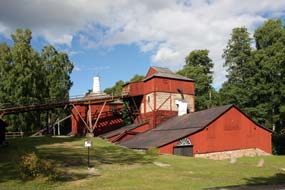 to invest their wealth in iron works,
which is what happened at here Ängelsberg. In 1680 the local land-owner developed the Ängelsberg
Bruk (estate iron works and forge) to produce pig- and wrought iron. Typical of
estate iron-works, which across Bergslagen contributed to Sweden's 17~18th
century economic prosperity, Ängelsberg increased in its technological
development and scale of production during the 19th century with charcoal-fired
blast furnace driven by increasingly powerful blowers. But competition from UK and German steel production
made smaller estate-based iron production uneconomical, and Ängelsberg
iron-works was fired for the last time in 1919. The Ängelsberg earth and timber
insulated blast furnace with its high furnace stack equipped with water-wheel
driven heated air blower, ore-crusher and ore roasting kiln have been conserved
(Photo 1 - Ängelsberg Bruk 18th~19th century blast furnace) set amid the landscaped estate and now have UNESCO World Heritage
status. Today the estate with its trimly manicured lawns and neat chocolate-box
red-painted wooden buildings was a peaceful setting; what would this scene have
looked like at the height of its industrial production? to invest their wealth in iron works,
which is what happened at here Ängelsberg. In 1680 the local land-owner developed the Ängelsberg
Bruk (estate iron works and forge) to produce pig- and wrought iron. Typical of
estate iron-works, which across Bergslagen contributed to Sweden's 17~18th
century economic prosperity, Ängelsberg increased in its technological
development and scale of production during the 19th century with charcoal-fired
blast furnace driven by increasingly powerful blowers. But competition from UK and German steel production
made smaller estate-based iron production uneconomical, and Ängelsberg
iron-works was fired for the last time in 1919. The Ängelsberg earth and timber
insulated blast furnace with its high furnace stack equipped with water-wheel
driven heated air blower, ore-crusher and ore roasting kiln have been conserved
(Photo 1 - Ängelsberg Bruk 18th~19th century blast furnace) set amid the landscaped estate and now have UNESCO World Heritage
status. Today the estate with its trimly manicured lawns and neat chocolate-box
red-painted wooden buildings was a peaceful setting; what would this scene have
looked like at the height of its industrial production?
|
Click on 4 highlighted areas of map for
details of
Sala, Vadstena, Norrköping and Småland |
 |
Sala Silver Mine: we returned
to Sala passing several other villages whose names included the -bruk suffix
indicating their iron-smelting heritage, and booked in at the Sala STF Vandrahem-Camping
set among lakeside woods just outside the little town. The lawned area behind
the hostel had 10 peaceful camping spaces shaded by tall trees; we still could
not get used to seeing deciduous trees and were missing the pines and spruce of
the north. Our reason for coming to Sala was to visit the Sala Silvergruva
(Silver Mine). Small scale peasant mining for silver and lead had begun in this
area of Bergslagen in Medieval times, but by the 16th century the Danish state
had taken over mining of silver on a huge scale benefitting from the resultant
revenue. The earliest exploitation had been open cast but as technology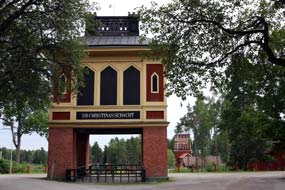 improved
with water-powered pumps and hoists, deeper mining developed. A small township
grew up south of the mines housing miners and their families, with
over 1000 living there at its height. By Gustav Vasa's reign (1523~60) with Sweden now
independent of Danish domination, the output from Sala's silver mine was a
mainstay of the new state's economy with the result that the mine was described
as the 'Treasury of Sweden'. But as shafts and galleries were dug deeper,
serious cave-ins threatened this
vital economic resource. German mining experts were brought in during the later
16th century; new shafts were dug and more systematically planned and surveyed
galleries developed. An entire surface system of canals and ponds was created to
drive water-wheels to power pumps and hoists for extracting the ore which was
transported 2 kms north for refining, crushing and smelting to retrieve the
minute quantities of silver from the galena mineral. Subsidence of the older
workings made them unusable and the old mining village unsafe for habitation,
and a new town developed where the modern town of Sala now stands just to the
north of the mine. improved
with water-powered pumps and hoists, deeper mining developed. A small township
grew up south of the mines housing miners and their families, with
over 1000 living there at its height. By Gustav Vasa's reign (1523~60) with Sweden now
independent of Danish domination, the output from Sala's silver mine was a
mainstay of the new state's economy with the result that the mine was described
as the 'Treasury of Sweden'. But as shafts and galleries were dug deeper,
serious cave-ins threatened this
vital economic resource. German mining experts were brought in during the later
16th century; new shafts were dug and more systematically planned and surveyed
galleries developed. An entire surface system of canals and ponds was created to
drive water-wheels to power pumps and hoists for extracting the ore which was
transported 2 kms north for refining, crushing and smelting to retrieve the
minute quantities of silver from the galena mineral. Subsidence of the older
workings made them unusable and the old mining village unsafe for habitation,
and a new town developed where the modern town of Sala now stands just to the
north of the mine.
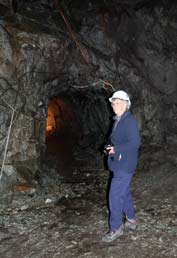 During the 17th century, the State's revenue
from Sala Silver Mine's output financed Gustav II Adolfus' foreign wars, with
shafts cut deeper and galleries spreading sideways into the veins of ore
deposits; the silver mine financed the construction of the ill-fated royal
warship Vasa. Improved technology for pumping and winching in the 18~19th
centuries enabled even deeper shafts to be driven, initially down to 60m, then
155m and the deepest working level at 318m, each of the shafts named after royal
beneficiaries of the mine's income - Queen Christina's Shaft, Gustav II's Shaft
and Carl XI's Shaft. Until the 19th century, fire-setting was the only means of
advancing shafts and galleries, with wood fired overnight against the workings
to break the rock; smoke was cleared by ventilation shafts and miners worked
with picks to extract the ore, advancing the face just 10cms a day. It was
desperately gruelling work in a hazardous environment with rock-falls frequent,
dust a major cause of lung disease, and only wood torches for lighting. The
Swedish State gained its silver revenue at vast human cost. Only in the mid-19th
century did black powder and later Nobel's dynamite become a reliable explosive,
enabling greater advance in the driving of galleries; steam powered and later
electrically operated pumps enabled even deeper shafts. The main mine ceased in 1908
but extraction of silver and lead continued until 1962 when all mining activity
at Sala ended. The deeper working levels below 155m have now flooded, but
tourist visits now take place down to the 60m and 155m levels which are
maintained. During the 17th century, the State's revenue
from Sala Silver Mine's output financed Gustav II Adolfus' foreign wars, with
shafts cut deeper and galleries spreading sideways into the veins of ore
deposits; the silver mine financed the construction of the ill-fated royal
warship Vasa. Improved technology for pumping and winching in the 18~19th
centuries enabled even deeper shafts to be driven, initially down to 60m, then
155m and the deepest working level at 318m, each of the shafts named after royal
beneficiaries of the mine's income - Queen Christina's Shaft, Gustav II's Shaft
and Carl XI's Shaft. Until the 19th century, fire-setting was the only means of
advancing shafts and galleries, with wood fired overnight against the workings
to break the rock; smoke was cleared by ventilation shafts and miners worked
with picks to extract the ore, advancing the face just 10cms a day. It was
desperately gruelling work in a hazardous environment with rock-falls frequent,
dust a major cause of lung disease, and only wood torches for lighting. The
Swedish State gained its silver revenue at vast human cost. Only in the mid-19th
century did black powder and later Nobel's dynamite become a reliable explosive,
enabling greater advance in the driving of galleries; steam powered and later
electrically operated pumps enabled even deeper shafts. The main mine ceased in 1908
but extraction of silver and lead continued until 1962 when all mining activity
at Sala ended. The deeper working levels below 155m have now flooded, but
tourist visits now take place down to the 60m and 155m levels which are
maintained.
Our visit to Sala Silver Mine: the Silver Mine's web site gave the
impression of mine visits being over-commercialised and superficial with as
sanitised an environment as Falun copper mine, but we decided to investigate
and approached the mine complex amid the peculiar landscape of mining towers and
spoil heaps
(Photo 2 - Queen Christina Shaft winding-house at Sala Silver Mine). Visits were expensive, even down to the 60m former working level
being 160kr each, but we booked our places, kitted up fully for the 5°C
underground temperature, donned hard-hats and waited for the guide. It was clear
from the start however that our reservations had been misplaced: the guide began
his factual commentary alternately in English and Swedish and allowed time for
questions,
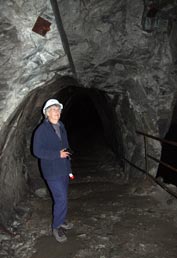 showing us a sectional plan of the centuries old mine workings and
detailing their history. Throughout the mine's history access to the deeper
reaches had been by a series of wooden ladders. We started underground however
down a series of steep, winding stone steps to a gallery where the guide gave us
further technical details of working methods. He led us to a fenced portal
opening into the vast Christina Shaft 20m in diameter and dropping fully to the
deepest working level. Looking upwards glimpses of daylight could be seen, but
downwards into the fearsome depths endlessly to the now flooded lower levels
nothing but darkness with perhaps just a hint of water. This had been the mine's
principal working shaft at the height of its late 19th century working. In what
seemed like a 3-dimensional maze of tunnels and galleries, we descended metal
rungs to a lower level where the guide issued torches for the next stage of descent into
partial darkness via a narrow and open spiral ladder. showing us a sectional plan of the centuries old mine workings and
detailing their history. Throughout the mine's history access to the deeper
reaches had been by a series of wooden ladders. We started underground however
down a series of steep, winding stone steps to a gallery where the guide gave us
further technical details of working methods. He led us to a fenced portal
opening into the vast Christina Shaft 20m in diameter and dropping fully to the
deepest working level. Looking upwards glimpses of daylight could be seen, but
downwards into the fearsome depths endlessly to the now flooded lower levels
nothing but darkness with perhaps just a hint of water. This had been the mine's
principal working shaft at the height of its late 19th century working. In what
seemed like a 3-dimensional maze of tunnels and galleries, we descended metal
rungs to a lower level where the guide issued torches for the next stage of descent into
partial darkness via a narrow and open spiral ladder.
This was certainly no sanitised underground route, and other than a passing
warning from the guide to take care, the group had to take personal
responsibility for their own well-being and safety in this evidently hostile
environment. As the guide added further details of working methods, we peered
into the semi-darkness of working galleries (see left) where over generations miners had
hacked out the ore gradually enlarging the vast caverns. Another spiral metal
rung-way brought us down further to the 60m working galleries, our
deepest level of descent on this tour. At this level the only lighting was that
provided by our torches; this and the means of descent gave some sense of
the miners' hazardous working environment
(Photo
3 - Underground at Sala Silver Mine). We were now led along a horizontal
passageway, but again no sanitised health and safety conscious walk-ways; the
tunnel floor-way was littered with rock debris necessitating serious care as we edged
forward. This finally led to an upward sloping tunnel cut post-mining to connect
former working galleries to the Knekt Shaft where a modern elevator had been
fitted as the means of egress from the 60m level. The lift returned us to the
surface where the guide gave us a further résumé of the route we had followed
underground with the help of a sectional plan of the workings. Contrary to our
expectations, this had been no superficial mine visit; we had been underground
for more than 2 hours, and the route followed was certainly not for the
faint-hearted: narrow, steep and open spiral
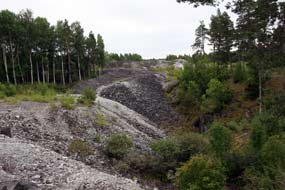 rung-ways dropping vertically into
the depths to be negotiated, and rock-strewn passageways with only a torch for
illumination. No nannying from the guide, with visitors having to take care for
themselves. The commentary was fulsomely detailed with opportunity for
questions; without doubt, despite our initial reservations, this was the finest
mine visit we had made, giving a realistic impression of the mine's scale of working environment. Our experience would commend others to walk the surface
route at Falun copper mine and make the 60m underground visit here at Sala
Silver Mine. rung-ways dropping vertically into
the depths to be negotiated, and rock-strewn passageways with only a torch for
illumination. No nannying from the guide, with visitors having to take care for
themselves. The commentary was fulsomely detailed with opportunity for
questions; without doubt, despite our initial reservations, this was the finest
mine visit we had made, giving a realistic impression of the mine's scale of working environment. Our experience would commend others to walk the surface
route at Falun copper mine and make the 60m underground visit here at Sala
Silver Mine.
There was also much to see on the surface
around the mine and we set off to walk around the collapsed pits of the former
open cast workings and spoil heaps (see right), and beyond this, the site of the
long-abandoned mining village. The small mining museum displays items excavated
from the mining village, historical details of the mine's development and
samples of ore. Nearby the winding towers of the Knekt Shaft and Queen
Christina Shaft stand as monuments to the former mine workings and along the
driveway, the surface winding tower and spoil heaps of the mine's deepest
workings, the 318m deep Carl XI Shaft. This visit to the Sala Silver Mine had
been a thoroughly absorbing afternoon, adding further to our understanding of
the importance of mineral resources in Sweden's historical economy. There was
just time to call in at the centre of the pleasant and unassuming modern town of
Sala and top up our provisions at the ICA supermarket, before returning for a
second night at the Sala campsite.
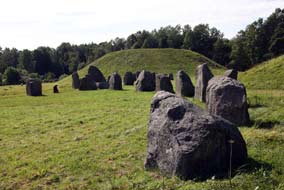 South to the Anundshög Iron Age burial ground near Västerås: we headed south
from Sala on Route 56, turning off on back-lanes to the Iron Age burial site at Anundshög 6kms
east of Västerås. As early as the 1,500 BC Bronze Age, people were already settling and
farming along the Badelunda ridge which stretched eastwards towards Lake Mäleren.
In these days before the land rose this was on a bay, the furthest inland point
of an inlet from South to the Anundshög Iron Age burial ground near Västerås: we headed south
from Sala on Route 56, turning off on back-lanes to the Iron Age burial site at Anundshög 6kms
east of Västerås. As early as the 1,500 BC Bronze Age, people were already settling and
farming along the Badelunda ridge which stretched eastwards towards Lake Mäleren.
In these days before the land rose this was on a bay, the furthest inland point
of an inlet from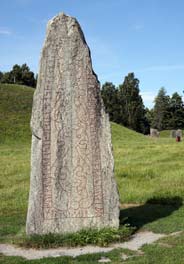 the sea, and remains have been found of a landing-stage at a
time when the ship was a significant means of travel. As the land rose, further
land emerged below the ridge cultivated by this prehistoric settled agricultural
society. Trade routes and water courses met around the Badelunda ridge, and both
archaeological finds and the surviving grave-fields show that an important power
centre ruled by a leading clan chieftain developed here at Anundshög during the early
Iron Age between 500~1050 AD. Around 500 visible graves survive with an unknown
number still undiscovered, of varying forms - burial mounds, stone ship-settings
and standing stones (see left). The largest is the great burial mound tumulus at Anundshög, Sweden's largest at 9m high and 64m in diameter created around the
10th century AD. Many of the mounds were plundered in antiquity and the
Anundshög tumulus has never been excavated. Built on a foundation of clay on which
the dead were cremated along with grave goods, the remains were covered with
stones and turf to raise the mound, the scale of the Anundshög tumulus and the
numbers involved in its construction indicating this was a powerful chieftain
who controlled large tracts of land. Around the mound were 5 large
ship-settings, another form of burial memorial associated with pagan ritual.
Again the scale suggests this was a sacred site ruled by a powerful chieftain.
Nearby a large and ornate rune stone was raised with a line of standing stones
marking a roadway leading to a forded river crossing, further indicators that he
who controlled communications routes and river-crossings with Anundshög at the
hub was indeed a powerful chieftain. The names of these rulers and their power
centre are unknown, but the burial site is now referred to by its later Medieval
name of Anundshög, the burial mound of Anund the chieftain's legendary name. By
Medieval times and the conversion to Christianity, the pagan ship-settings were
overturned and the rune stone torn down in an attempt to obliterate the pagan
past. A more settled agricultural society developed at Anundshög and the former
chieftain's territories divided up, with the former sacred burial site becoming
a meeting place for the local Thing, the district the sea, and remains have been found of a landing-stage at a
time when the ship was a significant means of travel. As the land rose, further
land emerged below the ridge cultivated by this prehistoric settled agricultural
society. Trade routes and water courses met around the Badelunda ridge, and both
archaeological finds and the surviving grave-fields show that an important power
centre ruled by a leading clan chieftain developed here at Anundshög during the early
Iron Age between 500~1050 AD. Around 500 visible graves survive with an unknown
number still undiscovered, of varying forms - burial mounds, stone ship-settings
and standing stones (see left). The largest is the great burial mound tumulus at Anundshög, Sweden's largest at 9m high and 64m in diameter created around the
10th century AD. Many of the mounds were plundered in antiquity and the
Anundshög tumulus has never been excavated. Built on a foundation of clay on which
the dead were cremated along with grave goods, the remains were covered with
stones and turf to raise the mound, the scale of the Anundshög tumulus and the
numbers involved in its construction indicating this was a powerful chieftain
who controlled large tracts of land. Around the mound were 5 large
ship-settings, another form of burial memorial associated with pagan ritual.
Again the scale suggests this was a sacred site ruled by a powerful chieftain.
Nearby a large and ornate rune stone was raised with a line of standing stones
marking a roadway leading to a forded river crossing, further indicators that he
who controlled communications routes and river-crossings with Anundshög at the
hub was indeed a powerful chieftain. The names of these rulers and their power
centre are unknown, but the burial site is now referred to by its later Medieval
name of Anundshög, the burial mound of Anund the chieftain's legendary name. By
Medieval times and the conversion to Christianity, the pagan ship-settings were
overturned and the rune stone torn down in an attempt to obliterate the pagan
past. A more settled agricultural society developed at Anundshög and the former
chieftain's territories divided up, with the former sacred burial site becoming
a meeting place for the local Thing, the district
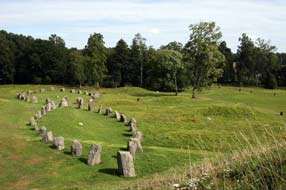 court which met to
resolve disputes. Badelunda church was built in the 13th century, its scale
again indicating that this was still an affluent farming community. court which met to
resolve disputes. Badelunda church was built in the 13th century, its scale
again indicating that this was still an affluent farming community.
Armed with maps and information booklet bought
from the café, we set off to explore the
Anundshög burial mounds site. The main tumulus was huge and surrounded by 4 of
the original 5 ship-settings now fully restored. The largest, over 50m in
diameter with stones 1m high, stood end to end leading to the tumulus with
several other burial mounds nearby. By now a hazy sun gave reasonable light for
photographing these remarkable 1,500 year old remains of pre-Christian, pre-historic
Swedish tribal society
(Photo 4 - Anundshög Iron Age burial-mounds and stone ship-settings). Clearly the now almost parklands site was a popular
Sunday afternoon outing for local families. The southern side of the site
looking out across flat arable farmland would once have been the inlet from the sea
alongside which the original settlements had farmed. A line of standing stones
led from the ford across the stream along the 'royal road' marking out this Iron
Age highway. This led to the 2.5m high rune stone, erected
in the late 10th century by a wealthy
land-owner to mark out his establishment of the road (see above right); in translation the runes
read: Folkvid raised these stones in memory of his son Heden, brother of
Anund; Vred carved the runes. Clearly this was a powerful man who set up
this imposing monument to tell the world for all time of his son, his road, and
himself. Vred was a skilful rune carver and produced an elegant pictorial design
of unknown significance around which the runic dedication is inscribed
(Photo 5 - Anundshög Rune stone and burial-mounds).
The top of the Anundshög burial mound gave a bird's eye view across the outline
of the 2 largest ship-settings (see left). stone, erected
in the late 10th century by a wealthy
land-owner to mark out his establishment of the road (see above right); in translation the runes
read: Folkvid raised these stones in memory of his son Heden, brother of
Anund; Vred carved the runes. Clearly this was a powerful man who set up
this imposing monument to tell the world for all time of his son, his road, and
himself. Vred was a skilful rune carver and produced an elegant pictorial design
of unknown significance around which the runic dedication is inscribed
(Photo 5 - Anundshög Rune stone and burial-mounds).
The top of the Anundshög burial mound gave a bird's eye view across the outline
of the 2 largest ship-settings (see left).
Västerås Cathedral:
by now it was 4-00pm and with the sky now gloomily overcast and rain beginning, we just had time to drive into
the city of Västerås before finding tonight's
campsite. Our satnav guided us through the eastern suburbs towards the centre,
passing heavy engineering companies that had made Västerås Sweden's industrial
workshop, which historically had exploited the metals mined and smelted across
the Bergslagen region. ABB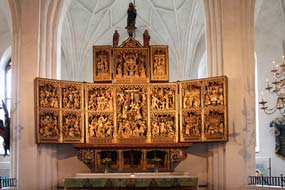 Industries whose generating plant we had seen at Porjus hydro-electric station was the city's main employer, and we passed a huge Bombardier engineering plant. Weaving a way through narrow winding
streets around the centre, thankful it was Sunday afternoon with minimal
traffic, we reached Västerås Domkyrkan. The red-brick cathedral was begun in the
13th century with Tessin the Younger adding the Baroque spire in 1695. We ambled
around the cathedral's chapels and memorials, noting the sarcophagus of Eric
XIV, Gustav Vasa's deranged son who was poisoned by his brother with
arsenic-laced soup in the internecine royal struggles following Vasa's death.
After a walk around the lanes and attractive wooden cottages of Kyrkbacken, the
old district behind the cathedral, we left Västerås and turned south onto Route
56 eventually crossing an arm of Lake Mälaren to find Mälarbadens Camping near
to Torshälla on the southern shore of the lake. This turned out to be a mediocre
and meanly penny-pinching campsite with additional coin charges for all the
basic facilities you should normally be able to take for granted; thankfully it
was only a one night stop. Industries whose generating plant we had seen at Porjus hydro-electric station was the city's main employer, and we passed a huge Bombardier engineering plant. Weaving a way through narrow winding
streets around the centre, thankful it was Sunday afternoon with minimal
traffic, we reached Västerås Domkyrkan. The red-brick cathedral was begun in the
13th century with Tessin the Younger adding the Baroque spire in 1695. We ambled
around the cathedral's chapels and memorials, noting the sarcophagus of Eric
XIV, Gustav Vasa's deranged son who was poisoned by his brother with
arsenic-laced soup in the internecine royal struggles following Vasa's death.
After a walk around the lanes and attractive wooden cottages of Kyrkbacken, the
old district behind the cathedral, we left Västerås and turned south onto Route
56 eventually crossing an arm of Lake Mälaren to find Mälarbadens Camping near
to Torshälla on the southern shore of the lake. This turned out to be a mediocre
and meanly penny-pinching campsite with additional coin charges for all the
basic facilities you should normally be able to take for granted; thankfully it
was only a one night stop.
The Ramsund Sigurd legend rock-engraving: in bright sunshine the following
morning, we drove on minor roads around the southern shore of Lake Mälaren to find the Ramsund Sigurd
Engraving. Turning off on a narrow lane we suddenly entered a dark and duly
mysterious wood and crossed a brook on a rickety bridge into a tree-lined
clearing to a parking place; there on a large bed-rock panel was the 5m long, 2m
high engraving (see below left). Carved around 1,080 AD, the stone takes the form of a
commemorative runic inscription shaped within a curving ribbon forming a
dragon's body and enclosing a panel of pictorial engraving illustrating the central
story of the legend of Sigurd (Sigfried) (Photo 6 - Ramsund Sigurd legend rock-engraving). The legend of the heroic dragon-slayer, of
golden treasure and a cursed ring occurs from time immemorial across Europe: the
hero's adventures figure in the English epic Beowulf, in the Icelandic
sagas of Snorri Sturluson and the Germanic Nibelungenlied epic saga borrowed by
Wagner in the Ring Cycle operas; it was heavily plagiarised by JRR Tolkien in
the Hobbit and Lord of the Rings.
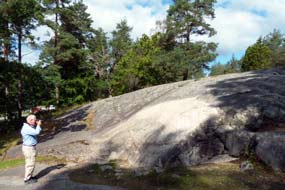 The legend of Sigurd Fafnesbane (Siegfried
the Dragon-Slayer) goes like this: once upon a time, an ancient magician named
Rodmar had 3 sons, each with remarkable powers. The first son Otr was able to
take on the shape of an otter when fishing for salmon; one of the Norse gods
Loki happened to be passing and threw a rock at the otter killing it. Rodmar
the father was mightily displeased at this and demanded that the god make
recompense for killing his son by filling the otter skin with golden treasure as
atonement. Loki went to the rapids and used his net to catch the dwarf Andvari
who had taken the shape of a pike. The dwarf purchased his freedom with all the
gold he possessed except for one gold ring; when Loki ripped the ring from his
finger, the dwarf placed a curse upon all who came into contact with the
treasure. Once Rodmar received the gold as payment for Otr's killing, the curse
brought greed upon him causing him to resent sharing the treasure with his other
2 sons Fafnir and Regin. Fafnir became so enraged that he killed his father to
get his hands on all the gold, and taking on the form of a snake-like dragon, he
went to brood at a place called Gnitaheden curled up on his pile of gold. The
curse of the ring continued: Regin, a skilful blacksmith, wanted his share of
the patrimony and planned to seize the treasure by trickery bringing into his
plans Sigurd whom he had earlier adopted as his step-son, forging him a razor-sharp
sword called Gram. Urged on by Regin, Sigurd dug a pit-trap near to where Fafnir
in the form of a dragon had slithered down to a lake to drink. Fafnir falls into
the trap and Sigurd stabs him to death with his sword Gram, so gaining the
honorific of Fafnesbane (Slayer of Fafnir). Sigurd cuts up the dragon, but in
roasting its heart on an open fire he burns his hand. Sucking his finger to soothe
the The legend of Sigurd Fafnesbane (Siegfried
the Dragon-Slayer) goes like this: once upon a time, an ancient magician named
Rodmar had 3 sons, each with remarkable powers. The first son Otr was able to
take on the shape of an otter when fishing for salmon; one of the Norse gods
Loki happened to be passing and threw a rock at the otter killing it. Rodmar
the father was mightily displeased at this and demanded that the god make
recompense for killing his son by filling the otter skin with golden treasure as
atonement. Loki went to the rapids and used his net to catch the dwarf Andvari
who had taken the shape of a pike. The dwarf purchased his freedom with all the
gold he possessed except for one gold ring; when Loki ripped the ring from his
finger, the dwarf placed a curse upon all who came into contact with the
treasure. Once Rodmar received the gold as payment for Otr's killing, the curse
brought greed upon him causing him to resent sharing the treasure with his other
2 sons Fafnir and Regin. Fafnir became so enraged that he killed his father to
get his hands on all the gold, and taking on the form of a snake-like dragon, he
went to brood at a place called Gnitaheden curled up on his pile of gold. The
curse of the ring continued: Regin, a skilful blacksmith, wanted his share of
the patrimony and planned to seize the treasure by trickery bringing into his
plans Sigurd whom he had earlier adopted as his step-son, forging him a razor-sharp
sword called Gram. Urged on by Regin, Sigurd dug a pit-trap near to where Fafnir
in the form of a dragon had slithered down to a lake to drink. Fafnir falls into
the trap and Sigurd stabs him to death with his sword Gram, so gaining the
honorific of Fafnesbane (Slayer of Fafnir). Sigurd cuts up the dragon, but in
roasting its heart on an open fire he burns his hand. Sucking his finger to soothe
the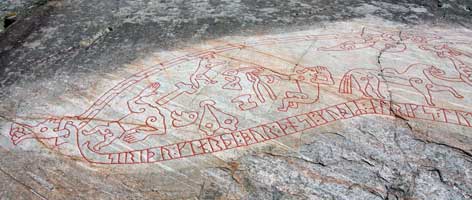 burn, he tastes the dragon's blood and instantly acquires the power to
understand the prophetic songs of birds sitting in a nearby tree who warn Sigurd
of Regin's evil plans to kill him and seize the treasure for himself. The birds
advise Sigurd to strike first and to kill Regin. Sigurd cuts off Regin's head to
escape his evil thoughts in the future; he returns to Fafnir's lair and loads
all the treasure onto his faithful horse Grani which is a direct descendent of
Odin's horse Sleipnir. burn, he tastes the dragon's blood and instantly acquires the power to
understand the prophetic songs of birds sitting in a nearby tree who warn Sigurd
of Regin's evil plans to kill him and seize the treasure for himself. The birds
advise Sigurd to strike first and to kill Regin. Sigurd cuts off Regin's head to
escape his evil thoughts in the future; he returns to Fafnir's lair and loads
all the treasure onto his faithful horse Grani which is a direct descendent of
Odin's horse Sleipnir.
So
how come the ancient legend of Sigurd Fafnesbane was reproduced in the 11th
century AD as pictograms surrounded by a runic inscription carved into the coils
of the dragon's body? (see right) The runes on the Ramsund engraving translate
as: Sigriðr, mother of Alríkr and daughter of Ormr, built this bridge in
memory of the soul of Holmgeirr, father of her husband Sigrøðr Perhaps it was the similarity of names
between the
woman Sigriðr and her late husband Sigroðr that caused the choice of the Sigurd
legend pictograms, again glorifying the family's status by association with the
legendary hero Sigurd. We know from
other dedicatory rune stones that it was not uncommon at this time for local
aristocratic families to gain prestige by building public works such as roads or bridges to honour deceased relatives. This was the time of transition from the
old pagan religion to the new Christianity which sought to secure standing in
the local community by sponsoring such public works in exchange for indulgences,
forgiveness of sins as guarantee of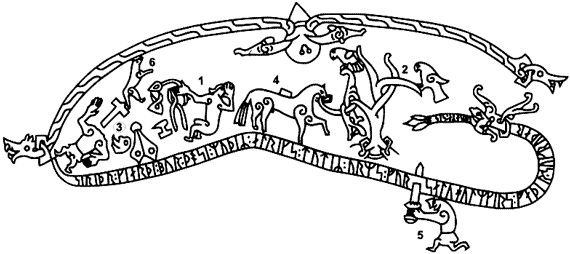 passage to heaven. And sure enough, as we stood by the rock panel admiring
this remarkable inscription from the 11th century AD, there below us we could
see parts of a stone roadway and abutments of the bridge which had once spanned
the river and which the inscription had
celebrated.
passage to heaven. And sure enough, as we stood by the rock panel admiring
this remarkable inscription from the 11th century AD, there below us we could
see parts of a stone roadway and abutments of the bridge which had once spanned
the river and which the inscription had
celebrated.
The Ramsund inscription and pictogram is reproduced
left: Sigurd is pictured sitting by the fire roasting Fafnir's heart (1) which drips
with blood; his horse Grani loaded with the treasure (4) is shown tethered
to a tree on which stand the birds (2) whose prophetic song warning of
Regin's treachery Sigurd now understands having sucked his burnt finger and
tasted the dragon's magic blood; Regin's body (3) whom Sigurd has just killed
lies with his severed head among his blacksmith's tools (bellows, anvil, hammer
and pincers); above all this stands Otr, the first brother whose death at the
hands of the god Loki had started all the woes (6); and below, Sigurd is shown
stabbing Fafnir, Regin's dragon-brother, with his sword Gran (5) which
penetrates the dragon's coil on which Sigriðr's dedicatory inscription is carved
in honour of the bridge she has built. We stood in amazement at this remarkably
preserved engraving in this mystical woodland setting (Photo 7 - Sigurd legend pictogram on Ramsund rock-engraving).
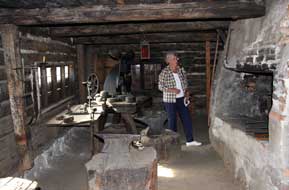 Eskilstuna and the Rademacher Forges: driving on into the small
town of Eskilstuna, we parked close to the centre to find the Rademacher Forges,
a preserved skansen-museum of 17th century cottage-industry iron smiths' forges.
Like nearby Västerås,
Eskilstuna had traditionally been an iron-working and metal crafts town,
drawing on the iron mined and smelted in Bergslagen, and producing both
household iron wares, horse equipment and arms for the Swedish military. In
the 1650s King Karl X Gustav had persuaded Reinhold Rademacher, a German iron
manufacturer in Swedish occupied Livonia (modern Latvia), to come to Sweden to
help develop forging skills. A group of 20 cottage-smithies for master-craftsmen
and apprentices was created each with an allowance of land for grazing and
growing crops. The surviving remains are now preserved at Eskilstuna as a
museum, all now rather twee and craft-shoppe, but before continuing south to Norrköping,
we did learn more from the museum attendant about the town's history of
iron-making and its still significant engineering industry.
A long afternoon drive on Route 55
brought us south to join the E4 motorway for a brief section around Norrköping to turn off at
the western approaches to the city to reach Himmelstalunds Camping. Eskilstuna and the Rademacher Forges: driving on into the small
town of Eskilstuna, we parked close to the centre to find the Rademacher Forges,
a preserved skansen-museum of 17th century cottage-industry iron smiths' forges.
Like nearby Västerås,
Eskilstuna had traditionally been an iron-working and metal crafts town,
drawing on the iron mined and smelted in Bergslagen, and producing both
household iron wares, horse equipment and arms for the Swedish military. In
the 1650s King Karl X Gustav had persuaded Reinhold Rademacher, a German iron
manufacturer in Swedish occupied Livonia (modern Latvia), to come to Sweden to
help develop forging skills. A group of 20 cottage-smithies for master-craftsmen
and apprentices was created each with an allowance of land for grazing and
growing crops. The surviving remains are now preserved at Eskilstuna as a
museum, all now rather twee and craft-shoppe, but before continuing south to Norrköping,
we did learn more from the museum attendant about the town's history of
iron-making and its still significant engineering industry.
A long afternoon drive on Route 55
brought us south to join the E4 motorway for a brief section around Norrköping to turn off at
the western approaches to the city to reach Himmelstalunds Camping.
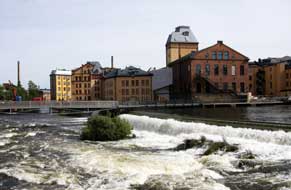 Norrköping,
the 'Manchester of Sweden': we had 2 reasons for visiting Norrköping (pronounced Nor-shurping):
one was to learn about the city's conserved textile industrial
heritage, the other its even older historical heritage dating back over 3,000
years; glancing across the river valley from the campsite, panels of bed-rock
were visible in the hill-side parklands containing the Himmelstalund Bronze Age
rock engravings. On a bright sunny morning with just a hazy hint of autumnal
dewiness on the grass, we crossed the footbridge beyond the campsite to walk the
2 kms along the river into the city. Norrköping's development as an industrial
city blossomed in the 19th century with the fast-flowing Motala ström providing
motive power for textile and paper mills built along the river. At one time, 70%
of Sweden's textiles were produced in Norrköping gaining it the nickname of
Sweden's Manchester. People flocked in from the surrounding countryside as
cheap labour Norrköping,
the 'Manchester of Sweden': we had 2 reasons for visiting Norrköping (pronounced Nor-shurping):
one was to learn about the city's conserved textile industrial
heritage, the other its even older historical heritage dating back over 3,000
years; glancing across the river valley from the campsite, panels of bed-rock
were visible in the hill-side parklands containing the Himmelstalund Bronze Age
rock engravings. On a bright sunny morning with just a hazy hint of autumnal
dewiness on the grass, we crossed the footbridge beyond the campsite to walk the
2 kms along the river into the city. Norrköping's development as an industrial
city blossomed in the 19th century with the fast-flowing Motala ström providing
motive power for textile and paper mills built along the river. At one time, 70%
of Sweden's textiles were produced in Norrköping gaining it the nickname of
Sweden's Manchester. People flocked in from the surrounding countryside as
cheap labour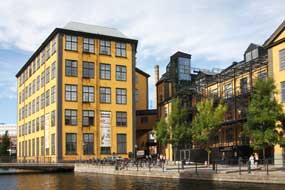 for the factories, but there was a blacker side to the city's image
of productive industry and affluence: cramped housing with overcrowded,
insanitary conditions made for appalling, disease-ridden living standards, and
with poor health-care facilities tuberculosis was a major killer until well into
the 20th century. Education and schooling was almost non-existent for children
of working families, wages were low with plentiful supplies of labour and
were frequently cut to maintain productive competitiveness and increased profits for
factory owners. The Swedish Manchester was as much an embodiment of the
Dark Satanic Mills as its English namesake. Amid such appalling social
conditions, factories multiplied and their owners grew rich, but post-WW2
overseas competition and lessening demand for conventional woollen and cotton
fabrics with the advent of man-made fibres brought serial decline, and in the
post-industrial age, the last textile mills closed in 1992. With serious loss of
employment opportunity, Norrköping struggled to attract decentralising
government departments to provide alternative employment, but despite PR
campaigns promoting the city's modern image, reality was starkly different for
working people: housing standards remained poor and rents unaffordable. In the
late 1990s, facing a social crisis, Norrköping re-invented itself in the for the factories, but there was a blacker side to the city's image
of productive industry and affluence: cramped housing with overcrowded,
insanitary conditions made for appalling, disease-ridden living standards, and
with poor health-care facilities tuberculosis was a major killer until well into
the 20th century. Education and schooling was almost non-existent for children
of working families, wages were low with plentiful supplies of labour and
were frequently cut to maintain productive competitiveness and increased profits for
factory owners. The Swedish Manchester was as much an embodiment of the
Dark Satanic Mills as its English namesake. Amid such appalling social
conditions, factories multiplied and their owners grew rich, but post-WW2
overseas competition and lessening demand for conventional woollen and cotton
fabrics with the advent of man-made fibres brought serial decline, and in the
post-industrial age, the last textile mills closed in 1992. With serious loss of
employment opportunity, Norrköping struggled to attract decentralising
government departments to provide alternative employment, but despite PR
campaigns promoting the city's modern image, reality was starkly different for
working people: housing standards remained poor and rents unaffordable. In the
late 1990s, facing a social crisis, Norrköping re-invented itself in the
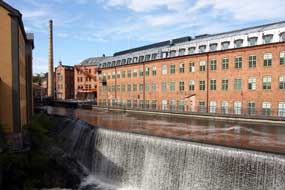 image-conscious,
non-productive new world: former industrial buildings clustered along the river
in the city centre were conserved and converted to museums, restaurants,
cultural centres and premises for higher education. The tourist era had arrived with a vengeance. Walkways
threaded between the factory chimneys of now deserted former industrial
buildings along the banks of canals, sluices and mill-races that once powered
the factories, their cascades now becoming 'features' of the new Industrial
Landscape (Industrilandskapet). image-conscious,
non-productive new world: former industrial buildings clustered along the river
in the city centre were conserved and converted to museums, restaurants,
cultural centres and premises for higher education. The tourist era had arrived with a vengeance. Walkways
threaded between the factory chimneys of now deserted former industrial
buildings along the banks of canals, sluices and mill-races that once powered
the factories, their cascades now becoming 'features' of the new Industrial
Landscape (Industrilandskapet).
Our visit to Norrköping's Industrial Landscape: the path from the campsite led
us across parkland and along Dargsgatan to a riverside walkway
where the fast-flowing River Motala
cascaded over weirs towards the complex of city centre former factory buildings
which the river once powered (see above left). Across the main town bridge, a side street led to
a river basin amid former mills and factories, and here we found the TIC set in
a former boiler house with its array of chimney-flues. At the TIC a fluently
English-speaking lady provided a street plan and English version of the
Industrial Landscape guide.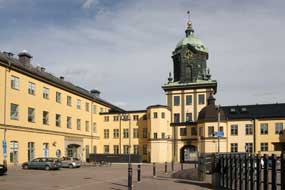 We were
over-awed by the surroundings of old factories and the rushing sound of water
surging along the labyrinth of channels and weirs set along the river's natural fall
over rapids which during the 19~20th centuries had been harnessed to power the factories. The waters spilled over a 300m long weir
dropping from the lip of a higher basin to form the centrepiece of the
Industrial Landscape conserved buildings
(see left) (Photo 8 - Motala ström weir in Norrköping's Industrial Landscape). One of these is the Arbetets Museum (Museum of Work),
based in what was a former cotton mill (see above right). Built in 1916 in a heptagon-shape to fit
onto the narrow island of Laxholmen in the river channel, the 7-storeyed textile
factory known as the Strykjärnet (Flat Iron from its shape) operated
until the mill's closure in the 1960s (Photo 9 - Former cotton mill on Laxholmen island, now Arbetets Museum). The building remained in a derelict state
until its restoration in the 1980s as part of the Industrial Landscape
project, re-opening in 1991 as the Arbetets Museum. The museum was free entry
with a range of trendy exhibitions on the theme of work showing how the industrial
society had affected working people's lives over the last 100 years. The
museum's most interesting exhibition documented the life of Eva Carlsson who
worked as a bobbin winder in the Flat Iron cotton mill from 1927 until its
closure in
We were
over-awed by the surroundings of old factories and the rushing sound of water
surging along the labyrinth of channels and weirs set along the river's natural fall
over rapids which during the 19~20th centuries had been harnessed to power the factories. The waters spilled over a 300m long weir
dropping from the lip of a higher basin to form the centrepiece of the
Industrial Landscape conserved buildings
(see left) (Photo 8 - Motala ström weir in Norrköping's Industrial Landscape). One of these is the Arbetets Museum (Museum of Work),
based in what was a former cotton mill (see above right). Built in 1916 in a heptagon-shape to fit
onto the narrow island of Laxholmen in the river channel, the 7-storeyed textile
factory known as the Strykjärnet (Flat Iron from its shape) operated
until the mill's closure in the 1960s (Photo 9 - Former cotton mill on Laxholmen island, now Arbetets Museum). The building remained in a derelict state
until its restoration in the 1980s as part of the Industrial Landscape
project, re-opening in 1991 as the Arbetets Museum. The museum was free entry
with a range of trendy exhibitions on the theme of work showing how the industrial
society had affected working people's lives over the last 100 years. The
museum's most interesting exhibition documented the life of Eva Carlsson who
worked as a bobbin winder in the Flat Iron cotton mill from 1927 until its
closure in
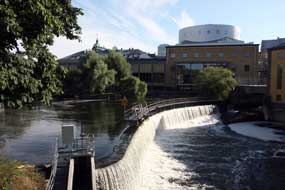 1962, giving a gruelling insight into the squalid living conditions
and arduous working hours of Norrköping's mill workers. Another exhibition
illustrated Norrköping's decline from its period of
industrial greatness, showing the 1950s demolition of confined, insanitary
housing and promotion of Norrköping as the bright, new, modern place to live and
work; the reality however was that with industrial wages still so low, employees
could not afford the rents and cost of living in the new apartments. Factory
closures of the 1980~90s brought further decline, with some of the country's
worst levels of unemployment; with no prospects, Norrköping was the place people
wanted to get away from. This was the city's real face rather than the
PR-tourist hype which dominates the image presented to today's visitors. 1962, giving a gruelling insight into the squalid living conditions
and arduous working hours of Norrköping's mill workers. Another exhibition
illustrated Norrköping's decline from its period of
industrial greatness, showing the 1950s demolition of confined, insanitary
housing and promotion of Norrköping as the bright, new, modern place to live and
work; the reality however was that with industrial wages still so low, employees
could not afford the rents and cost of living in the new apartments. Factory
closures of the 1980~90s brought further decline, with some of the country's
worst levels of unemployment; with no prospects, Norrköping was the place people
wanted to get away from. This was the city's real face rather than the
PR-tourist hype which dominates the image presented to today's visitors.
We walked along past the conserved 1750 Baroque
tower of the former Holmens Bruk paper mill (see above right), which was set up originally by a
Dutch entrepreneur Louis de Veer and has now been converted into a concert hall
alongside the river (see left) (Photo 10 - Motala ström and Holmens Bruk former paper mill, now concert hall). Across in Gamla Torget, a modernist statue of de Veer gazed
across at his former paper mill factory. The lower natural course of the Motala
Ström river beyond the industrial weirs led along a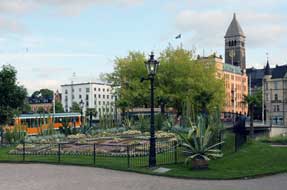 pleasant river-side walk across to Carl Johann Park where some 10,000 cacti are arranged each year in a
floral display in front of Bernadotte's statue, and city trams trundle along Drottninggatan past the monumentally unsightly Rådhus
(see right). We returned along the
riverside walkways above the weirs and industrial buildings to find the Norrköping Stads-museum, housed in
the bewilderingly multi-storeyed industrial premises of a former textile-weaving
and dying mill with its boiler house and factory chimney. The museum's displays
aim to illustrate Norrköping's textile industrial past. The former yarn-spinning
and weaving halls are now filled with historical textile machinery which was
operated and explained for us by a lady who clearly knew her warp from her weft (Photo 11 - Textile weaving machine in Norrköping's City Museum).
Jacquard weaving machines controlled by continuous punch-card drives produced
fabrics with regular geometric damask designs used for table clothes, curtains
and upholstery. Shuttles flew back and forth 200 times a minute and the pleasant river-side walk across to Carl Johann Park where some 10,000 cacti are arranged each year in a
floral display in front of Bernadotte's statue, and city trams trundle along Drottninggatan past the monumentally unsightly Rådhus
(see right). We returned along the
riverside walkways above the weirs and industrial buildings to find the Norrköping Stads-museum, housed in
the bewilderingly multi-storeyed industrial premises of a former textile-weaving
and dying mill with its boiler house and factory chimney. The museum's displays
aim to illustrate Norrköping's textile industrial past. The former yarn-spinning
and weaving halls are now filled with historical textile machinery which was
operated and explained for us by a lady who clearly knew her warp from her weft (Photo 11 - Textile weaving machine in Norrköping's City Museum).
Jacquard weaving machines controlled by continuous punch-card drives produced
fabrics with regular geometric damask designs used for table clothes, curtains
and upholstery. Shuttles flew back and forth 200 times a minute and the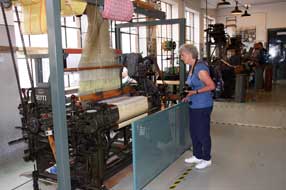 noise
was deafening (see left). The precision of this wonderful engineering was alluringly
impressive, but its application relied on the industrialised exploitation of
textile workers who spent their long working hours minding several such
machines. They were paid a pittance on piece rates, and breakdowns, empty bobbins or faults in the weave could lose them a
whole day's earnings.
Displays in other galleries illustrated the many trades associated with an
industrial city: milliners, hat and glove makers, cobblers, barbers,
confectioners, chimney sweeps, smiths, brick-layers, wheel and wagon wrights,
coopers and goldsmiths. noise
was deafening (see left). The precision of this wonderful engineering was alluringly
impressive, but its application relied on the industrialised exploitation of
textile workers who spent their long working hours minding several such
machines. They were paid a pittance on piece rates, and breakdowns, empty bobbins or faults in the weave could lose them a
whole day's earnings.
Displays in other galleries illustrated the many trades associated with an
industrial city: milliners, hat and glove makers, cobblers, barbers,
confectioners, chimney sweeps, smiths, brick-layers, wheel and wagon wrights,
coopers and goldsmiths.
We headed back out towards the campsite along the
river-side path where a former textile mill now housed parts of the Norrköping
campus of Linköping University. Term must just have started and young freshmen
undergraduates spilled out onto the pavement outside the student union. They all
looked to be enjoying their leisure time and we wondered when the realities of
university working life would begin for them. We had enjoyed our day exploring Norrköping's
conserved former industrial buildings, but behind the sterilely conserved post-industrial
glitz of modern tourist-oriented Norrköping, we had learnt
something of the harsh realities of the dreadful working and living conditions
of the city's industrial working classes that had earned Norrköping its blacker
image as the place people wanted to get away from.
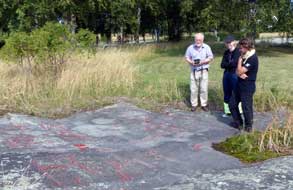 The
Bronze Age rock-engravings at Norrköping:
some 7,000 rock engravings
have been found at several sites around Norrköping chiselled into bed-rock
panels along the Motala Ström river, dating from the 1,500~500 BC Bronze Age.
Sea levels were higher then and today's bare hillsides would have been
islands with the waters of Bråviken reaching further inland to what is now The
Bronze Age rock-engravings at Norrköping:
some 7,000 rock engravings
have been found at several sites around Norrköping chiselled into bed-rock
panels along the Motala Ström river, dating from the 1,500~500 BC Bronze Age.
Sea levels were higher then and today's bare hillsides would have been
islands with the waters of Bråviken reaching further inland to what is now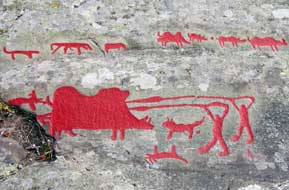 Norrköping
city centre. The Motala Ström would have been the main communications route for
the pastoralist peoples who lived along the shores in permanent
settlements, living by farming wheat and barley and by animal husbandry of sheep,
cattle and pigs and supplementing their diet by hunting. The rock-carvings accumulated over a 1000 year period, some overlapping others at what must have
been a shore-side social, cult-religious and trading centre. The carvings were
dated to the Bronze Age from the distinctive shapes of swords and axes which
feature in the engravings. People gathered at the cult-site seeking support for
good harvests and success in the hunt from the gods who controlled the weather
and ruled the necessities of life. As elsewhere, the carvings' themes reflected
this life style of the people who created them. Ships occur regularly on the
panels of engravings, again reflecting their importance as a means of Bronze
Age transport; the size of the vessels portrayed perhaps shows them as more
figurative representing the passage from life to death. Norrköping
city centre. The Motala Ström would have been the main communications route for
the pastoralist peoples who lived along the shores in permanent
settlements, living by farming wheat and barley and by animal husbandry of sheep,
cattle and pigs and supplementing their diet by hunting. The rock-carvings accumulated over a 1000 year period, some overlapping others at what must have
been a shore-side social, cult-religious and trading centre. The carvings were
dated to the Bronze Age from the distinctive shapes of swords and axes which
feature in the engravings. People gathered at the cult-site seeking support for
good harvests and success in the hunt from the gods who controlled the weather
and ruled the necessities of life. As elsewhere, the carvings' themes reflected
this life style of the people who created them. Ships occur regularly on the
panels of engravings, again reflecting their importance as a means of Bronze
Age transport; the size of the vessels portrayed perhaps shows them as more
figurative representing the passage from life to death.
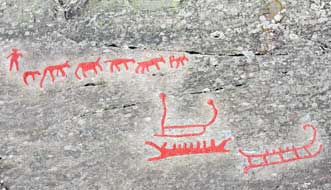 At the Rock Carvings Museum by the bypass bridge, we
had arranged to meet the following morning with Theres and Daniel,
2 of the Norrköping city archaeologists, at the Himmelstalund rock-engravings
site to find out more about the Bronze Age carvings (see above left). On the parkland hillside on the opposite side of the river from the
campsite and at 2 other locations, they guided us around the panels of engravings and explained their At the Rock Carvings Museum by the bypass bridge, we
had arranged to meet the following morning with Theres and Daniel,
2 of the Norrköping city archaeologists, at the Himmelstalund rock-engravings
site to find out more about the Bronze Age carvings (see above left). On the parkland hillside on the opposite side of the river from the
campsite and at 2 other locations, they guided us around the panels of engravings and explained their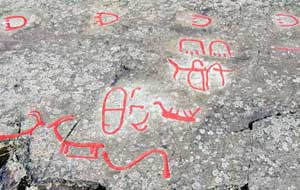 significance and meaning (Photo 12 - The Fiskeby rock-engravings site). There are some 1,600 engravings at Himmelstalund and
the concentration here indicates that this was probably the principal cult-site
of the region's settlements. Most of the carvings have been coloured in
with red paint to make them more visible for modern-day visitors; without the paint, it
would have been almost impossible to identify them. For the rest of the morning,
the 2 archaeologists led us on a detailed tour of the engravings panel by panel,
giving interpretation of the beliefs and life-style of the Bronze Age people who
farmed these shores 3,000 years ago and created the engravings. The predominance
of ship engravings showed 2 styles of boat, the older having
in-curving stem- and stern-posts, the newer outward curving prows and sterns
with animal figure heads. Some larger ships had markings symbolising crews of
rowers, others were decorated with tree-of-life symbols; the pine had only just
begun to colonise southern Scandinavia in the warmer post-glacial climate when
the carvings were made. Some of the ships had solidly engraved hulls, others had
hulls decorated with cross-patterning finely engraved with a bronze chisel
rather than flint. Some ships were superimposed by a line of long-necked horses,
sacred animals in Bronze Age pagan belief and sacrificed as offerings to
the gods. One of the Bronze Age carved ships had been enhanced by the addition
of 6 runic characters dated to the late Iron Age almost 1,500 years younger than
the pictorial engraving, perhaps indicating Himmelstalund's long continuation as
a cult-site.
significance and meaning (Photo 12 - The Fiskeby rock-engravings site). There are some 1,600 engravings at Himmelstalund and
the concentration here indicates that this was probably the principal cult-site
of the region's settlements. Most of the carvings have been coloured in
with red paint to make them more visible for modern-day visitors; without the paint, it
would have been almost impossible to identify them. For the rest of the morning,
the 2 archaeologists led us on a detailed tour of the engravings panel by panel,
giving interpretation of the beliefs and life-style of the Bronze Age people who
farmed these shores 3,000 years ago and created the engravings. The predominance
of ship engravings showed 2 styles of boat, the older having
in-curving stem- and stern-posts, the newer outward curving prows and sterns
with animal figure heads. Some larger ships had markings symbolising crews of
rowers, others were decorated with tree-of-life symbols; the pine had only just
begun to colonise southern Scandinavia in the warmer post-glacial climate when
the carvings were made. Some of the ships had solidly engraved hulls, others had
hulls decorated with cross-patterning finely engraved with a bronze chisel
rather than flint. Some ships were superimposed by a line of long-necked horses,
sacred animals in Bronze Age pagan belief and sacrificed as offerings to
the gods. One of the Bronze Age carved ships had been enhanced by the addition
of 6 runic characters dated to the late Iron Age almost 1,500 years younger than
the pictorial engraving, perhaps indicating Himmelstalund's long continuation as
a cult-site.
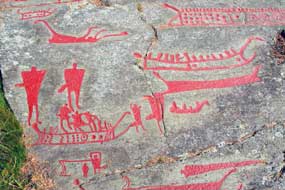 There were sun disk symbols with 4-bar cross carved in varying
sizes, one group being delicately small, and curious rectangular frames with
geometric lined patterns, speculatively interpreted as fishing or bird-trapping
nets. There were foot-print symbols, some bare feet, others with a sandal strap
(see above right),
and a line of There were sun disk symbols with 4-bar cross carved in varying
sizes, one group being delicately small, and curious rectangular frames with
geometric lined patterns, speculatively interpreted as fishing or bird-trapping
nets. There were foot-print symbols, some bare feet, others with a sandal strap
(see above right),
and a line of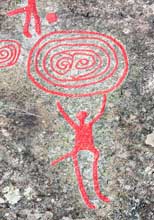 bear prints tracked across the entire width of a panel, turning
sharply to face a human figure, perhaps signifying the shamanistic bear
reverting to human form. Weapons also figured in several panels: life-sized
swords, male figures carrying long spears, and symbols representing axes and
bronze lure horned instruments (see above right). A hunting scene showed spear-wielding hunters
with hunting dogs, one upside-down perhaps indicating killed by the wild boars
they were attacking (see above right) (Photo 13 - Bronze Age rock engravings of wild boar hunt). One panel in a far corner showed farm animal
husbandry with male
boar, large sows and piglets being herded by a swine-herd, all cleverly carved along wide
grooves in the rock surface cut by retreating ice (Photo 14 - Rock engraving showing swine herd with boar, sow and piglets). The panel also showed 2 pairs
of child-sized footprints side by side; did this symbolise a child's passage to
adulthood or, with the high levels of child mortality, a family tragedy? We
discussed with the archaeologists the issue of public access to these precious
engravings and the risk of vandalism and people's insistence on adding their own
graffiti, with police indifference to the problem despite the ancient remains
supposedly being protected by law. bear prints tracked across the entire width of a panel, turning
sharply to face a human figure, perhaps signifying the shamanistic bear
reverting to human form. Weapons also figured in several panels: life-sized
swords, male figures carrying long spears, and symbols representing axes and
bronze lure horned instruments (see above right). A hunting scene showed spear-wielding hunters
with hunting dogs, one upside-down perhaps indicating killed by the wild boars
they were attacking (see above right) (Photo 13 - Bronze Age rock engravings of wild boar hunt). One panel in a far corner showed farm animal
husbandry with male
boar, large sows and piglets being herded by a swine-herd, all cleverly carved along wide
grooves in the rock surface cut by retreating ice (Photo 14 - Rock engraving showing swine herd with boar, sow and piglets). The panel also showed 2 pairs
of child-sized footprints side by side; did this symbolise a child's passage to
adulthood or, with the high levels of child mortality, a family tragedy? We
discussed with the archaeologists the issue of public access to these precious
engravings and the risk of vandalism and people's insistence on adding their own
graffiti, with police indifference to the problem despite the ancient remains
supposedly being protected by law.
Theres and Daniel, the 2 archaeologists drove us out to
2 other less known rock-engravings sites, and amid harvested
fields some 3kms from the city we were shown the Ekenberg panels with some 370
distinctive carvings. Male human figures were shown with an inverted triangular
body perhaps indicating the wearing of cloaks (see above left). The ships here were more
elaborately engraved, decorated with spiral patterning on the hulls and
animal-head prows; human figures nearby had arms raised in adoration. There
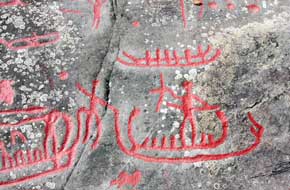 were more large sword engravings, the design of which had originally enabled the
engravings to be dated to the Bronze Age; one of the swords was shown piercing a
disk of concentric circles, speculatively interpreted as symbolising a solar
eclipse. A procession of human males escorting a larger figure perhaps
represented a sacrificial offering in a fertility sacrifice as in other
European Spring festivals. Below this was the most were more large sword engravings, the design of which had originally enabled the
engravings to be dated to the Bronze Age; one of the swords was shown piercing a
disk of concentric circles, speculatively interpreted as symbolising a solar
eclipse. A procession of human males escorting a larger figure perhaps
represented a sacrificial offering in a fertility sacrifice as in other
European Spring festivals. Below this was the most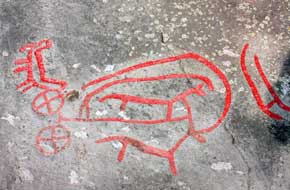 famous of the engravings, a
male figure raising a spiralled disk above his head, usually called the
Sun Carrier (see above right) (Photo 15 - Sun Carrier rock engraving at Ekenberg). At the bottom of the panel was a pair of elegantly carved deer with
branching antlers and a hunter attacking them with a spear. Lure instruments
figured regularly on the Ekenberg panels. We were then taken to a smaller site
at Fiskeby where the panels of rock-engravings had been discovered covered by
soil in a farmyard. The most distinctive figure here was a 2-wheeled chariot
with a pair of horses standing either side of the chariot-pole, their reins
clearly visible, but no representation of a charioteer or warrior
(Photo 16 - Rock engraving of 2-wheeled chariot and pair of horses with reins). This image of
the evidently Homeric chariot with its echo of contemporary Cretan Linear B 4-cross chariot
wheels was a particularly poignant find (see right). Another scene showed a spear-wielding
hunter with a pair of hunting dogs; another showed what appeared to be a battle
with a warrior standing aboard one of the ships seeming to hold a bow (see left). This had
been a particularly thrilling morning, recalling our visit to the Tanum
rock-engravings in Bohuslän (see
our log),
and we express our gratitude to Theres and Daniel for the time they had so freely
given and their helpful interpretation of the rock-engravings. famous of the engravings, a
male figure raising a spiralled disk above his head, usually called the
Sun Carrier (see above right) (Photo 15 - Sun Carrier rock engraving at Ekenberg). At the bottom of the panel was a pair of elegantly carved deer with
branching antlers and a hunter attacking them with a spear. Lure instruments
figured regularly on the Ekenberg panels. We were then taken to a smaller site
at Fiskeby where the panels of rock-engravings had been discovered covered by
soil in a farmyard. The most distinctive figure here was a 2-wheeled chariot
with a pair of horses standing either side of the chariot-pole, their reins
clearly visible, but no representation of a charioteer or warrior
(Photo 16 - Rock engraving of 2-wheeled chariot and pair of horses with reins). This image of
the evidently Homeric chariot with its echo of contemporary Cretan Linear B 4-cross chariot
wheels was a particularly poignant find (see right). Another scene showed a spear-wielding
hunter with a pair of hunting dogs; another showed what appeared to be a battle
with a warrior standing aboard one of the ships seeming to hold a bow (see left). This had
been a particularly thrilling morning, recalling our visit to the Tanum
rock-engravings in Bohuslän (see
our log),
and we express our gratitude to Theres and Daniel for the time they had so freely
given and their helpful interpretation of the rock-engravings.
Himmelstalunds Camping at Norrköping and a supper of Surströmming :
set near a sporting complex
in the western outskirts of Norrköping,
Himmelstalunds Camping is a broad-lawned campsite set on the banks of the Motala ström river, with a 2km
pleasant walk along the river to the city centre. In late August, the main
summer rush was well past and the campsite was almost deserted apart from 2
large groups of English migrant workers' caravans. It was a welcoming
campsite, kept for the last 9 years by a family who leased the site from Norrköping municipality. But relationships had soured since the city had
increasingly neglected its responsibilities for maintenance of the site,
buildings and facilities. The result was that the family in frustration had
decided to give up the camping; the place had an air of neglect, and its future
was now uncertain with even rumours of the site being sold off for
housing development.
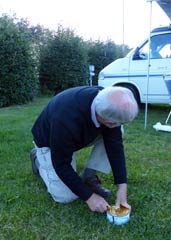 It seemed totally absurd that a city like Norrköping whose
economy now depended on tourism,
should so neglect and even abandon its only campsite which was so ideally
located. After our 2 days of learning-packed visits at Norrköping, we
spent a worthwhile day in camp here at Himmelstalunds, catching up on jobs and
enjoying the peaceful environment. On a warm and sunny evening, this seemed the
moment, long put off, to broach the dreaded tin of Surströmming which had been
festering away for several weeks in the bottom of the camper fridge; today was
also the 3rd Thursday of August, the traditional day to start eating this year's
production of Surströmming. We had originally bought the tin of fermented Baltic
herring from a harbour-side cottage on the off-shore High Coast island of
Trysunda; Surströmming, said to be foul-smelling, had an infamously noxious
reputation among southern Swedes but was relished by northerners. The tradition
of eating this disgusting concoction began during the 16th century on Ulvön and It seemed totally absurd that a city like Norrköping whose
economy now depended on tourism,
should so neglect and even abandon its only campsite which was so ideally
located. After our 2 days of learning-packed visits at Norrköping, we
spent a worthwhile day in camp here at Himmelstalunds, catching up on jobs and
enjoying the peaceful environment. On a warm and sunny evening, this seemed the
moment, long put off, to broach the dreaded tin of Surströmming which had been
festering away for several weeks in the bottom of the camper fridge; today was
also the 3rd Thursday of August, the traditional day to start eating this year's
production of Surströmming. We had originally bought the tin of fermented Baltic
herring from a harbour-side cottage on the off-shore High Coast island of
Trysunda; Surströmming, said to be foul-smelling, had an infamously noxious
reputation among southern Swedes but was relished by northerners. The tradition
of eating this disgusting concoction began during the 16th century on Ulvön and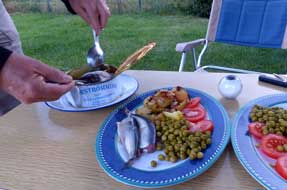 other Baltic island fishing settlements when, with the high cost of salting fish
over winter, fermenting in light brine became an alternative method of
preservation, despite producing an almost toxically inedible result stinking of
sewer gas. There are now only a handful of Surströmming producers on the
islands, sold mainly to the tourist trade in large strengthened tins to
withstand the pressure accumulated from the fermenting uncooked fish. Over the
4~10 weeks of fermentation, the tins can expand to the size of a football if not
kept in a fridge; airlines have banned Surströmming alleging that the pressurised cans are potentially
explosive; restaurants refuse to allow tins to be opened inside their premises
since the noxious smell can never fully be removed. We had been warned to be
sure to open our tin outside and not splash the liquid on clothing. Having
prepared the traditional accompaniments of potato, onion, tomatoes and tunnbröd
(flat-bread), Paul nervously applied the tin opener a safe distance from our
camper, expecting to release a spray of pressurised sewer-gas. Our Surströmming
was 'young', only 5 weeks old, and had been kept in the fridge; the tin
was tough and inside lurked 8 small uncooked herring. Now came the dreaded moment
to taste it (Photo 17 - Supper of Surströmming, Baltic herring fermented in brine): the smell was just about tolerable, but the slimy texture made it
seem not worth the effort of tearing the raw fish flesh from the bones. We
bravely persevered, but it has to be said it was truly the most
disgusting gastronomic experience ever: fork-fulls of saline slime with
nauseating texture and smell of rotting fish, though little taste. We had done
our duty and tried Surströmming, but the remains were cautiously consigned to
the bin!
More on Surströmming
other Baltic island fishing settlements when, with the high cost of salting fish
over winter, fermenting in light brine became an alternative method of
preservation, despite producing an almost toxically inedible result stinking of
sewer gas. There are now only a handful of Surströmming producers on the
islands, sold mainly to the tourist trade in large strengthened tins to
withstand the pressure accumulated from the fermenting uncooked fish. Over the
4~10 weeks of fermentation, the tins can expand to the size of a football if not
kept in a fridge; airlines have banned Surströmming alleging that the pressurised cans are potentially
explosive; restaurants refuse to allow tins to be opened inside their premises
since the noxious smell can never fully be removed. We had been warned to be
sure to open our tin outside and not splash the liquid on clothing. Having
prepared the traditional accompaniments of potato, onion, tomatoes and tunnbröd
(flat-bread), Paul nervously applied the tin opener a safe distance from our
camper, expecting to release a spray of pressurised sewer-gas. Our Surströmming
was 'young', only 5 weeks old, and had been kept in the fridge; the tin
was tough and inside lurked 8 small uncooked herring. Now came the dreaded moment
to taste it (Photo 17 - Supper of Surströmming, Baltic herring fermented in brine): the smell was just about tolerable, but the slimy texture made it
seem not worth the effort of tearing the raw fish flesh from the bones. We
bravely persevered, but it has to be said it was truly the most
disgusting gastronomic experience ever: fork-fulls of saline slime with
nauseating texture and smell of rotting fish, though little taste. We had done
our duty and tried Surströmming, but the remains were cautiously consigned to
the bin!
More on Surströmming
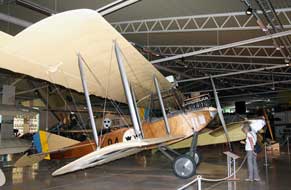 Linköping and the Swedish Air Force Museum:
the following day, we turned westwards on the E4 motorway to the city of
Linköping, home of Saab Aerospace, reproductions of whose aircraft line the
motorway on the approach to the city. After a brief visit to Linköping city
centre with its 12~13th century medieval cathedral, we made our way out to the
Swedish Air Force Museum at Malmen Airbase in the city's western outskirts. The Swedish Flygvapenmuseum (Air Force Museum)
with its displays of aircraft traces the history of the Swedish Air Force from
its establishment in 1926. Initially aircraft were purchased or built under
licence from British, French, German and American manufacturers, but from 1938
the Swedish government founded the SAAB Company (Svenska Aeroplan
Aktiebolaget) to develop Sweden's own military
aircraft. With the outbreak of WW2, the Air Force's role was to defend neutral
Swedish air space and territorial waters from intrusion by aircraft, ships and
submarines of the hostile warring nations, particularly German and Soviet.
During the Cold War when Sweden, although maintaining neutrality, was aligned
with NATO, the need to defend her airspace from Soviet intrusion was even more
intense. The museum's collection of aircraft traced this history from the
earliest biplanes, aircraft of Linköping and the Swedish Air Force Museum:
the following day, we turned westwards on the E4 motorway to the city of
Linköping, home of Saab Aerospace, reproductions of whose aircraft line the
motorway on the approach to the city. After a brief visit to Linköping city
centre with its 12~13th century medieval cathedral, we made our way out to the
Swedish Air Force Museum at Malmen Airbase in the city's western outskirts. The Swedish Flygvapenmuseum (Air Force Museum)
with its displays of aircraft traces the history of the Swedish Air Force from
its establishment in 1926. Initially aircraft were purchased or built under
licence from British, French, German and American manufacturers, but from 1938
the Swedish government founded the SAAB Company (Svenska Aeroplan
Aktiebolaget) to develop Sweden's own military
aircraft. With the outbreak of WW2, the Air Force's role was to defend neutral
Swedish air space and territorial waters from intrusion by aircraft, ships and
submarines of the hostile warring nations, particularly German and Soviet.
During the Cold War when Sweden, although maintaining neutrality, was aligned
with NATO, the need to defend her airspace from Soviet intrusion was even more
intense. The museum's collection of aircraft traced this history from the
earliest biplanes, aircraft of
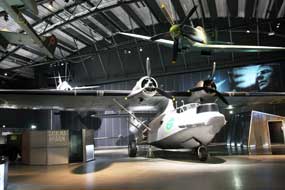 WW2
and the Cold War, right through to the modern SAAB-built Draken
and Gripen jet fighters. WW2
and the Cold War, right through to the modern SAAB-built Draken
and Gripen jet fighters.
We paid our 50kr seniors' reduced admission and
began our tour of the aircraft displays. The first hall showed the Air Force's
earliest biplanes from 1915 onwards (see above right), purchased from overseas manufacturers.
With the lead-up to WW2, Sweden needed modern aircraft to defend her neutrality,
initially buying British and German planes until denied commercial access to the
belligerents; displays included Fokker aircraft, Hawker Hart and Gloster
Gladiator. These latter 2 aircraft curiously bore blue swastika on white ground
markings which the commentary explained was the Finnish Air Force's emblem at
that time, the aircraft being flown by Swedish volunteers fighting for Finland
during the 1940 Winter War against the Soviet invaders. During WW2 Sweden
suffered a number of aerial intrusions of her airspace both accidental and
deliberate: German and Soviets bombers attacked Swedish targets and RAF planes
such as the Lancaster Easy Elsie crash landed in neutral Sweden (see
log of our visit to the crash site in Swedish Lapland). A huge Junkers JU-86
stood in a corner of the hall, captured by the Swedes when it crash-landed in
Swedish territory. Before USA
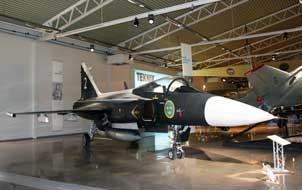 entered the war, the Swedish Air Force was able to
buy North American P-51 Mustangs, and an example of this highly successful
fighter aircraft was displayed bearing the gold 3 crowns on blue ground Swedish
markings. The SAAB Company founded in 1938 initially manufactured overseas
aircraft such as the Mustang under licence, but increasingly began designing and
building its own aircraft like the SAAB 17 and 18. SAAB were highly innovative
producing curious aircraft like the 1943 SAAB-21 with its rear-facing propeller set
behind the cockpit between twin fuselages to enable more powerful forward-firing
armaments
(Photo 18 - Twin fuselage, rear engine SAAB-21). Post-WW2 the decision was made to concentrate on jet military
aircraft leading to the jet version of the SAAB-21 and later development of the
highly successful Gripen and Draken jets, all of which were displayed (see left). entered the war, the Swedish Air Force was able to
buy North American P-51 Mustangs, and an example of this highly successful
fighter aircraft was displayed bearing the gold 3 crowns on blue ground Swedish
markings. The SAAB Company founded in 1938 initially manufactured overseas
aircraft such as the Mustang under licence, but increasingly began designing and
building its own aircraft like the SAAB 17 and 18. SAAB were highly innovative
producing curious aircraft like the 1943 SAAB-21 with its rear-facing propeller set
behind the cockpit between twin fuselages to enable more powerful forward-firing
armaments
(Photo 18 - Twin fuselage, rear engine SAAB-21). Post-WW2 the decision was made to concentrate on jet military
aircraft leading to the jet version of the SAAB-21 and later development of the
highly successful Gripen and Draken jets, all of which were displayed (see left).
The second hall entitled Expecting the Worst,
with displays of the aircraft from the period of the Cold War from 1946~89, had
excellent exhibitions detailing the military tensions of that time,
Sweden's surveillance programme against the threat of Soviet espionage and
aggression, and civilian life during the period of nuclear threat. The displays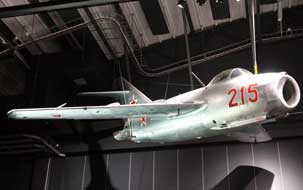 revealed that in the 1960s Sweden had even considered developing her own
independent nuclear weapons but in the end, while maintaining the delicate
balance of neutral status, enjoyed American protection through association with
NATO short of full membership. Her operational military aircraft of the
immediate post-war period and 1950s were mainly of British origin: later
versions of the Spitfire, Catalina flying boat for coastal patrols (see above
right), de Haviland
Venom and Vampire and Hawker Hunter, all of which were displayed. Most sinister
of all the aircraft however was the classic early Cold War Soviet MiG-15 jet
fighter (see right) which was suspended from the hall's high ceiling like an evil
presence (Photo 19 - Soviet Cold War MiG-15 jet fighter). It was fascinating to see how the barrel-shaped body and swept back
wings resembled those of the Swedish SAAB S-29 Tunnan (Photo 20 - Swedish SAAB S-29 Tunnan jet fighter above Hawker Hunter) and US Sabre jet, all of
which were developed from the end of WW2 German Messerschmitt 262 advanced jet fighter whose
drawings found their way east, west and north enabling post-war jet
developments. The final displays included the later SAAB military jets, the
Draken, Lansen and Viggen, all of which looked so formidable. The culminating
display in the first hall had been the mighty SAAB JAS-39 Gripen jet fighter
introduced in 1996 and today the Swedish Air Force's only combat aircraft (see
below left) (Photo 21 - SAAB JAS-39 Gripen jet fighter).
revealed that in the 1960s Sweden had even considered developing her own
independent nuclear weapons but in the end, while maintaining the delicate
balance of neutral status, enjoyed American protection through association with
NATO short of full membership. Her operational military aircraft of the
immediate post-war period and 1950s were mainly of British origin: later
versions of the Spitfire, Catalina flying boat for coastal patrols (see above
right), de Haviland
Venom and Vampire and Hawker Hunter, all of which were displayed. Most sinister
of all the aircraft however was the classic early Cold War Soviet MiG-15 jet
fighter (see right) which was suspended from the hall's high ceiling like an evil
presence (Photo 19 - Soviet Cold War MiG-15 jet fighter). It was fascinating to see how the barrel-shaped body and swept back
wings resembled those of the Swedish SAAB S-29 Tunnan (Photo 20 - Swedish SAAB S-29 Tunnan jet fighter above Hawker Hunter) and US Sabre jet, all of
which were developed from the end of WW2 German Messerschmitt 262 advanced jet fighter whose
drawings found their way east, west and north enabling post-war jet
developments. The final displays included the later SAAB military jets, the
Draken, Lansen and Viggen, all of which looked so formidable. The culminating
display in the first hall had been the mighty SAAB JAS-39 Gripen jet fighter
introduced in 1996 and today the Swedish Air Force's only combat aircraft (see
below left) (Photo 21 - SAAB JAS-39 Gripen jet fighter).
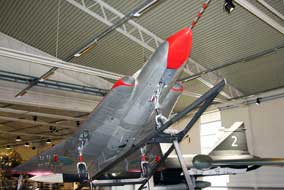 All of these aircraft were set against detailed
information panels setting the background of European and world-wide events of
the Cold War, along with clever displays of Swedish domestic settings with
contemporary furnishings and radio/TV playing news clips of the period. Another
display showed the control room base for military surveillance aircraft
patrolling Swedish airspace over the Baltic and intercepting Soviet aircraft; a
chilling recording played the radio dialogue between pilot and controller as the
Swedish jet identified a Soviet bomber approaching Swedish airspace. Much was
made of these close encounters which followed the 1952 shooting down by a Soviet
MiG-15 of a Swedish SIGINT DC-3 aircraft patrolling close to Soviet airspace on
a secret mission to gain radio intelligence on Soviet deployments. The entire
crew of 8 were killed when the DC-3 crashed into the Baltic. The incident was
denied by the Soviets and hushed up by the Swedish government who maintained
silence over its secret surveillance flights, causing much anguish for the
crew's families and controversy among the Swedish public. 50 years later the
wreck of the DC-3 was located on the bed of the Baltic and recovered to be
displayed in a special hall at the museum with still much mystery and
controversy surrounding the incident. This had been for us an excellent
afternoon at the Swedish Air Force Museum: the large halls gave plenty of space
around the superb aircraft collection enabling good photographic opportunity,
and most commendably all the detailed information panels were dual-language
Swedish and English. Whether or not aircraft are your thing, the museum gave a
thoroughly informative survey of chilling 20th century history. All of these aircraft were set against detailed
information panels setting the background of European and world-wide events of
the Cold War, along with clever displays of Swedish domestic settings with
contemporary furnishings and radio/TV playing news clips of the period. Another
display showed the control room base for military surveillance aircraft
patrolling Swedish airspace over the Baltic and intercepting Soviet aircraft; a
chilling recording played the radio dialogue between pilot and controller as the
Swedish jet identified a Soviet bomber approaching Swedish airspace. Much was
made of these close encounters which followed the 1952 shooting down by a Soviet
MiG-15 of a Swedish SIGINT DC-3 aircraft patrolling close to Soviet airspace on
a secret mission to gain radio intelligence on Soviet deployments. The entire
crew of 8 were killed when the DC-3 crashed into the Baltic. The incident was
denied by the Soviets and hushed up by the Swedish government who maintained
silence over its secret surveillance flights, causing much anguish for the
crew's families and controversy among the Swedish public. 50 years later the
wreck of the DC-3 was located on the bed of the Baltic and recovered to be
displayed in a special hall at the museum with still much mystery and
controversy surrounding the incident. This had been for us an excellent
afternoon at the Swedish Air Force Museum: the large halls gave plenty of space
around the superb aircraft collection enabling good photographic opportunity,
and most commendably all the detailed information panels were dual-language
Swedish and English. Whether or not aircraft are your thing, the museum gave a
thoroughly informative survey of chilling 20th century history.
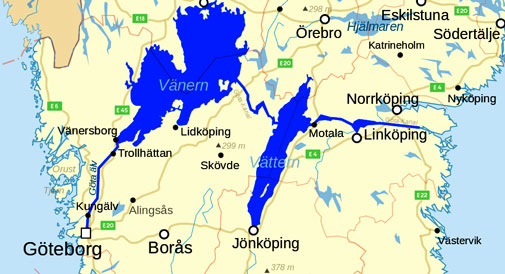 Bergs Slussar locks on
the Göta Canal: just north of Linköping
near the small town of Ljungsbro, we camped at an aire by the Bergs Slussar
locks as our base for exploring the central section of the Göta (pronounced
Yerta) Canal.
Construction of the Göta Canal was one of Sweden's largest civil engineering
projects, 190kms from the SE coast across the southern width of the country to
Lake Vättern, on to Lake Värnern, and with the Trollhätten Canal connecting
Stockholm on the Baltic with Göteborg on the North Sea. The canal was built
between 1810~32 to facilitate the transport of goods for export, and some 58,000
conscripted troops took part in its construction which was supervised by Baltzar
von Platen. He died in 1829 just 3 years before the canal's completion. 87 kms
of the canal's full length was cut by hand to create the navigable channel
linking the series of natural lakes, with a total of 58 sets of locks to
overcome the height difference between sea level and the canal's highest point
of 91.8m above sea level at Lake Viken. The canal continued in use throughout
the 19th century for the transport of both goods and passengers and today
is still in regular use for pleasure boats. After a night's camp, we walked up
to the Bergs Slussar (locks) complex where passage up and down the sequence of 3
sets of locks is scheduled at fixed times for boats to move through in convoy.
From the canal's exit at Lake Roxen, the Karl Johans Slussar is a flight of 7
interconnected locks which raises the canal 18.8m up to the marina at Berg (Photo 22 - Karl Johans locks raising Göta Canal from
Lake Roxen),
followed by the Oscars Slussar named after Crown Prince Oscar (later King Oscar
I) who with his father King Karl XIV Johan laid the foundation stone for the
locks in 1815. The double Oscar lock raises the canal another 4.8m and is
followed immediately by the Berg lock raising the canal a further 5.5m for its
ongoing passage under the lifting road-bridge (Photo 23 - Bergs and Oscars Slussar). Bergs Slussar locks on
the Göta Canal: just north of Linköping
near the small town of Ljungsbro, we camped at an aire by the Bergs Slussar
locks as our base for exploring the central section of the Göta (pronounced
Yerta) Canal.
Construction of the Göta Canal was one of Sweden's largest civil engineering
projects, 190kms from the SE coast across the southern width of the country to
Lake Vättern, on to Lake Värnern, and with the Trollhätten Canal connecting
Stockholm on the Baltic with Göteborg on the North Sea. The canal was built
between 1810~32 to facilitate the transport of goods for export, and some 58,000
conscripted troops took part in its construction which was supervised by Baltzar
von Platen. He died in 1829 just 3 years before the canal's completion. 87 kms
of the canal's full length was cut by hand to create the navigable channel
linking the series of natural lakes, with a total of 58 sets of locks to
overcome the height difference between sea level and the canal's highest point
of 91.8m above sea level at Lake Viken. The canal continued in use throughout
the 19th century for the transport of both goods and passengers and today
is still in regular use for pleasure boats. After a night's camp, we walked up
to the Bergs Slussar (locks) complex where passage up and down the sequence of 3
sets of locks is scheduled at fixed times for boats to move through in convoy.
From the canal's exit at Lake Roxen, the Karl Johans Slussar is a flight of 7
interconnected locks which raises the canal 18.8m up to the marina at Berg (Photo 22 - Karl Johans locks raising Göta Canal from
Lake Roxen),
followed by the Oscars Slussar named after Crown Prince Oscar (later King Oscar
I) who with his father King Karl XIV Johan laid the foundation stone for the
locks in 1815. The double Oscar lock raises the canal another 4.8m and is
followed immediately by the Berg lock raising the canal a further 5.5m for its
ongoing passage under the lifting road-bridge (Photo 23 - Bergs and Oscars Slussar).
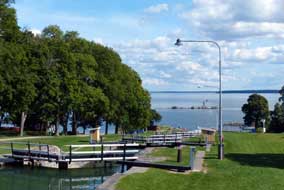 Having learned from the lock-keeper more about the
locks' layout and operation, we watched a group of boats entering the top Bergs
lock-chamber ready for the lower gates to be closed; when the lock had filled
and water-level equalised with the ongoing canal, the top gates were opened and
road bridge raised ready for the boats to move forward quickly to continue their
onward journey along the canal. We returned to the middle Oscar lock to watch a
further convoy of boats advancing from the marina to repeat the process (Photo 24 - Boat entering the Oscars Lock). In the
morning sunlight, this was such a pleasant scene. Along the board-walk around
the Bergs marina guest-harbour, we stood at the head of Karl Johans Slussar's 7 Having learned from the lock-keeper more about the
locks' layout and operation, we watched a group of boats entering the top Bergs
lock-chamber ready for the lower gates to be closed; when the lock had filled
and water-level equalised with the ongoing canal, the top gates were opened and
road bridge raised ready for the boats to move forward quickly to continue their
onward journey along the canal. We returned to the middle Oscar lock to watch a
further convoy of boats advancing from the marina to repeat the process (Photo 24 - Boat entering the Oscars Lock). In the
morning sunlight, this was such a pleasant scene. Along the board-walk around
the Bergs marina guest-harbour, we stood at the head of Karl Johans Slussar's 7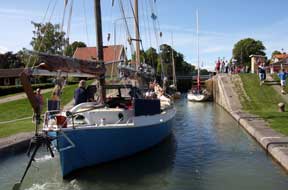 locks looking steeply to the foot of the flight to the shore of Lake Roxen far
below (see left), then walked down the hill slope to where a small marina allowed boats to
pause while waiting for the next scheduled passage up through the locks (see
right).
locks looking steeply to the foot of the flight to the shore of Lake Roxen far
below (see left), then walked down the hill slope to where a small marina allowed boats to
pause while waiting for the next scheduled passage up through the locks (see
right).
Exploring the Göta Canal: between
Berg and Borensberg the canal takes a parallel but separate cut from the Motala
Ström river which flows through 2 smaller lakes, so avoiding the necessity of
navigating rapids and shallows which the river's natural course would have
entailed. Just before Borensberg, our road passed under an aqueduct carrying the
canal which at towpath level was wide and peaceful (Photo 25 - Dramatic sky along the Göta Canal). We continued around to the
town of Motala where locks controlled the canal's outflow from Lake Boren and a
flight of 5 lock-chambers raised it a further 15.3m from lake level for its
ongoing passage through Motala out into Lake Vättern. Along to Motala's
canal-side harbour, a final set of locks controlled the canal's outflow into the
wide estuary of the Motala Ström. Walking down to the harbour-side's ice-cream
stalls, we could gaze out across the wide Motala Viken
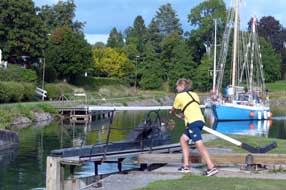 estuary and beyond the
by-pass bridge could just make out the distant Lake Vättern. The
canal's builder Baltzar von Platen also designed the town of Motala, which
developed with canal-associated industries; von Platen laid out the streets in a
fan-shaped pattern so that all residents could see the course of his canal; his
grave stands on the canal bank at Motala. We returned along Route 34 to
Borensberg both to complete our Göta Canal explorations at the Borensberg
Slussar and to find tonight's campsite. The road through the little town crossed
the canal on a lifting bridge, and we parked by the marina to see the locks,
pleasantly surprised to find the 4 boats which we had watched earlier passing
the Berg Slussar just arriving here at Borensberg having taken all afternoon to
travel the 20kms along the canal. The regulating lock at Borensberg, the only
one on the canal system to retain hand-operated gates, serves only to adjust the
canal by just 0.2m as it enters the varying water level of Lake Boren at its
eastern end. The lock-keeper had travelled along from Berg to see the convoy of
boats through the Borensberg locks. The 4 boats were moored in the lock-chamber,
the bottom gates closed, water-levels equalised, the top gates were opened,
lifting road-bridge raised, and the boats sailed on to continue their passage
across Lake Boren (see left); we waved farewell to the crews whom we had followed along the
canal (Photo 26 - Negotiating the Borensberg Lock). estuary and beyond the
by-pass bridge could just make out the distant Lake Vättern. The
canal's builder Baltzar von Platen also designed the town of Motala, which
developed with canal-associated industries; von Platen laid out the streets in a
fan-shaped pattern so that all residents could see the course of his canal; his
grave stands on the canal bank at Motala. We returned along Route 34 to
Borensberg both to complete our Göta Canal explorations at the Borensberg
Slussar and to find tonight's campsite. The road through the little town crossed
the canal on a lifting bridge, and we parked by the marina to see the locks,
pleasantly surprised to find the 4 boats which we had watched earlier passing
the Berg Slussar just arriving here at Borensberg having taken all afternoon to
travel the 20kms along the canal. The regulating lock at Borensberg, the only
one on the canal system to retain hand-operated gates, serves only to adjust the
canal by just 0.2m as it enters the varying water level of Lake Boren at its
eastern end. The lock-keeper had travelled along from Berg to see the convoy of
boats through the Borensberg locks. The 4 boats were moored in the lock-chamber,
the bottom gates closed, water-levels equalised, the top gates were opened,
lifting road-bridge raised, and the boats sailed on to continue their passage
across Lake Boren (see left); we waved farewell to the crews whom we had followed along the
canal (Photo 26 - Negotiating the Borensberg Lock).
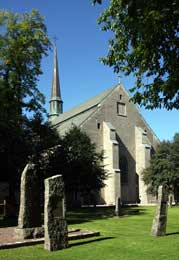 A night's camp at Strandbadets Camping,
Borensberg: we had enjoyed a wonderfully sunny day along the Göta
Canal and had learned much about this superb piece of 19th century engineering
which is clearly still well used albeit by pleasure craft. It was now time to
find the family-run Strandbadets Camping 2 kms from the village on the shore of
Lake Boren. We were greeted hospitably but warned that they were celebrating the
end of their summer season with a Saturday evening pop-concert for the occupants
of the static-caravans which monopolised the site. We had little choice but to
grin and bear it! At least tomorrow this would be a peaceful setting for our
planned day in camp to catch up with chores and complete more of our web
writing. A night's camp at Strandbadets Camping,
Borensberg: we had enjoyed a wonderfully sunny day along the Göta
Canal and had learned much about this superb piece of 19th century engineering
which is clearly still well used albeit by pleasure craft. It was now time to
find the family-run Strandbadets Camping 2 kms from the village on the shore of
Lake Boren. We were greeted hospitably but warned that they were celebrating the
end of their summer season with a Saturday evening pop-concert for the occupants
of the static-caravans which monopolised the site. We had little choice but to
grin and bear it! At least tomorrow this would be a peaceful setting for our
planned day in camp to catch up with chores and complete more of our web
writing.
Moving on to Vadstena: when we walked down
to the lake-shore at 7-00am the following morning at the start of our 17th Week, the sun was only just clearing the horizon and the trees and grass were
covered with early autumn dew; both the year and the trip were moving on fast.
We headed SW on delightfully rural lanes through farming villages and arable
countryside where harvesting was almost completed and autumn ploughing
beginning, and approached Vadstena. Set on the NE shore of the vast Lake Vättern,
the small town of 7,600 inhabitants had from medieval times been a royal seat
and important monastic centre. In 1545 Gustav Vasa had built Vadstena's moated
castle as part of his defensive ring of fortresses protecting the Swedish
heartlands from Danish incursion. 200 years earlier in 1346, King Magnus
Eriksson had donated Bjälbo Manor for use as a convent founded in 1362 by Birgitta Birgersdottir to become Vadstena Abbey. We parked by the old centre and
walked along through the former convent gardens to the Klosterkyrkan
Abbey-church which Birgitta had specified should be 'of plain construction,
humble and strong'. Viewed from under the trees in the gardens, the Abbey which
was consecrated in 1430 certainly met her criteria, looking sombre and sturdy
(see right).
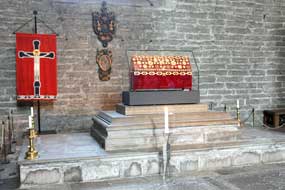 Vadstena Abbey-church:
Birgitta (1303~73) came from a noble
Östergötland family and was certainly made of sternly determined stuff: married
at 13, she bore 8 children and became lady-in-waiting to King Magnus Eriksson
and his Queen Blanche of Namur. Such was her forceful personality, she persuaded
her royal sponsors to bequeath Bjälbo Manor to found the nunnery to fulfil one
of her many revelations. But according to Catholic rules of the day, she needed
to obtain papal authorisation for this and in 1349 duly set off across Europe
for Rome. Unfortunately Vadstena Abbey-church:
Birgitta (1303~73) came from a noble
Östergötland family and was certainly made of sternly determined stuff: married
at 13, she bore 8 children and became lady-in-waiting to King Magnus Eriksson
and his Queen Blanche of Namur. Such was her forceful personality, she persuaded
her royal sponsors to bequeath Bjälbo Manor to found the nunnery to fulfil one
of her many revelations. But according to Catholic rules of the day, she needed
to obtain papal authorisation for this and in 1349 duly set off across Europe
for Rome. Unfortunately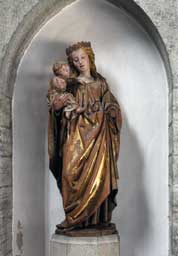 no one had told her that the pope was in Avignon, and
not even Birgitta's forceful charm could persuade him to return. She hung around
in Rome, enjoying more visions during the next 20 years waiting for papal
approval for her convent. Pope Urban V eventually gave his blessing to the
scheme in 1370, but Birgitta died in Rome in 1373. Her convent was duly
established alongside the abbey-church in Vadstena by her daughter Katarina who
continued her mother's ecclesiastical work, and Birgitta was canonised for her
efforts in 1391 to become Sweden's first female saint; her daughter was also
canonised as the founding abbess of Vadstena nunnery. Not even Birgitta's
reputation however could resist the forcefulness of Gustav Vasa's mid-16th
century Reformation, but since many of the nuns came from powerful families,
Vadstena convent was the last in the country to be closed in 1595. The
abbey-church continued as Vadstena's parish church and a new convent was founded
in the late 20th century (Photo 27 - Abbey-church at Vadstena founded in 1346 by St Birgitta). no one had told her that the pope was in Avignon, and
not even Birgitta's forceful charm could persuade him to return. She hung around
in Rome, enjoying more visions during the next 20 years waiting for papal
approval for her convent. Pope Urban V eventually gave his blessing to the
scheme in 1370, but Birgitta died in Rome in 1373. Her convent was duly
established alongside the abbey-church in Vadstena by her daughter Katarina who
continued her mother's ecclesiastical work, and Birgitta was canonised for her
efforts in 1391 to become Sweden's first female saint; her daughter was also
canonised as the founding abbess of Vadstena nunnery. Not even Birgitta's
reputation however could resist the forcefulness of Gustav Vasa's mid-16th
century Reformation, but since many of the nuns came from powerful families,
Vadstena convent was the last in the country to be closed in 1595. The
abbey-church continued as Vadstena's parish church and a new convent was founded
in the late 20th century (Photo 27 - Abbey-church at Vadstena founded in 1346 by St Birgitta).
The abbey-church with its beautiful medieval
architecture has over the centuries been embellished with a celebrated
collection of medieval artwork and tombs. Most spectacular was the decorated
Gothic vaulting, and the west end was dominated by the ornate sarcophagus of
Gustav Vasa's mentally retarded son Magnus who had lived at Vadstena Slott. The
tomb was guarded by chubby, glum-faced cherubs, the likeness of Magnus lying
atop with its life-like hands raised in prayer. A wooden
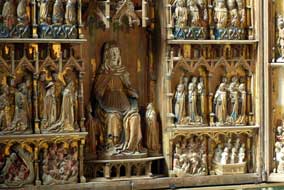 statuette
of Birgitta of 1435 portrayed the saint ecstatically enjoying one of her visions
(see right). All of
the statuettes around the church had their hands deliberately sawn off
possibly by Protestant vandalism after the Reformation. Along the abbey's
northern wall, the Door of Grace and Honour had received novice nuns into the
convent and released them on their deaths. In a place of honour to the side of
the main altar stood the reliquary containing the remains of Birgitta and her
daughter Katarina (see above left). Behind the huge and gilded altar triptych carved in 1520 and
displaying the assumption of Mary and scenes from the crucifixion, a lower
chancel was lined with confessional niches where the nuns told all. This was
backed with another carved triptych of 1460 portraying the saintly Birgitta
dictating her revelations to bands of attentive nuns, while below representations of purgatory showed the woebegone damned disappearing into the
mouth of a holy hippopotamus (see left). statuette
of Birgitta of 1435 portrayed the saint ecstatically enjoying one of her visions
(see right). All of
the statuettes around the church had their hands deliberately sawn off
possibly by Protestant vandalism after the Reformation. Along the abbey's
northern wall, the Door of Grace and Honour had received novice nuns into the
convent and released them on their deaths. In a place of honour to the side of
the main altar stood the reliquary containing the remains of Birgitta and her
daughter Katarina (see above left). Behind the huge and gilded altar triptych carved in 1520 and
displaying the assumption of Mary and scenes from the crucifixion, a lower
chancel was lined with confessional niches where the nuns told all. This was
backed with another carved triptych of 1460 portraying the saintly Birgitta
dictating her revelations to bands of attentive nuns, while below representations of purgatory showed the woebegone damned disappearing into the
mouth of a holy hippopotamus (see left).
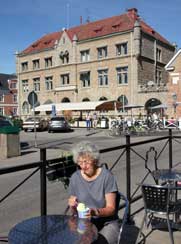 The delightful old town of Vadstena and its
Castle: after this feast of ecclesiastical artwork, we walked around
to the newly restored Bjälbo palace which had once been Birgitta's nunnery, and
out through the gardens to one the outbuildings which during the 18~19th
centuries had housed the town's lunatic asylum; known locally as Stora
Dårhuset (Great Madhouse), it now serves as the Hospital Museum
displaying the horrific contraptions used to control the unfortunate inmates.
Across to the shore of Lake Vättern, we were at last able stand beside this vast
inland sea which we only before seen from the heights of the Hanneberg plateau.
Following the shore-side path around past the excavated remains of the medieval
nunnery, we crossed to Vadstena Slott (Castle) whose moat now serves as the
town's lake-side marina. The massive sturdy-looking former Vasa fortress (Photo 28 - Vadstena Slott (Castle) founded by Gustav Vasa in 1545) had been enlarged and converted into a Renaissance palace by
Vasa's deranged sons, notably Johan III
who had poisoned his brother, Vasa's successor, Eric XIV with arsenic-laced soup
in the internecine wars which brought the dynasty to an inglorious end in the
early 17th century. We crossed the moat-bridge into the castle's vast inner
courtyard and re-crossed to the southern side back towards the old town. The
delightful cobbled street of Storgatan led along through the old town where we
paused to enjoy the excellent local liquorice ice cream at the 1936 founded Halvaars Glass
(see right) opposite the town hall. Vadstena had a tradition of lace-making and shops sold samples
of local lace. The delightful old town of Vadstena and its
Castle: after this feast of ecclesiastical artwork, we walked around
to the newly restored Bjälbo palace which had once been Birgitta's nunnery, and
out through the gardens to one the outbuildings which during the 18~19th
centuries had housed the town's lunatic asylum; known locally as Stora
Dårhuset (Great Madhouse), it now serves as the Hospital Museum
displaying the horrific contraptions used to control the unfortunate inmates.
Across to the shore of Lake Vättern, we were at last able stand beside this vast
inland sea which we only before seen from the heights of the Hanneberg plateau.
Following the shore-side path around past the excavated remains of the medieval
nunnery, we crossed to Vadstena Slott (Castle) whose moat now serves as the
town's lake-side marina. The massive sturdy-looking former Vasa fortress (Photo 28 - Vadstena Slott (Castle) founded by Gustav Vasa in 1545) had been enlarged and converted into a Renaissance palace by
Vasa's deranged sons, notably Johan III
who had poisoned his brother, Vasa's successor, Eric XIV with arsenic-laced soup
in the internecine wars which brought the dynasty to an inglorious end in the
early 17th century. We crossed the moat-bridge into the castle's vast inner
courtyard and re-crossed to the southern side back towards the old town. The
delightful cobbled street of Storgatan led along through the old town where we
paused to enjoy the excellent local liquorice ice cream at the 1936 founded Halvaars Glass
(see right) opposite the town hall. Vadstena had a tradition of lace-making and shops sold samples
of local lace.
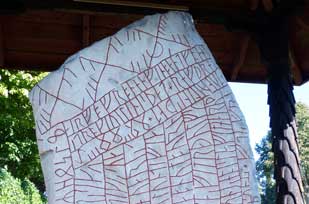 The 9th century Rök Runestone and the language
of runes: leaving Vadstena we drove SW across agricultural countryside
to find the isolated church of Rök and the 9th century Rök Runestone. The runic
alphabet developed from the 6~7th centuries to express the language of the
northern Germanic peoples, as Norse travellers came into contact with
the Roman Empire and witnessed the art of writing. Runic script probably evolved
from Byzantine Greek (cf the similarities of many of the characters), the oldest
runic alphabet consisting of 24 different symbols. A later script evolved in the
8th century with an alphabet of 16 characters, one variant of which, 'twig
runes, was used on the Rök Runestone. The runic alphabet spread across northern
Europe, and it became common by the 9th century to erect runic inscriptions as
memorials to the dead. After the introduction of Christianity in the 10~11th
centuries, rune stones were often decorated with ornate crosses. The 9th century Rök Runestone and the language
of runes: leaving Vadstena we drove SW across agricultural countryside
to find the isolated church of Rök and the 9th century Rök Runestone. The runic
alphabet developed from the 6~7th centuries to express the language of the
northern Germanic peoples, as Norse travellers came into contact with
the Roman Empire and witnessed the art of writing. Runic script probably evolved
from Byzantine Greek (cf the similarities of many of the characters), the oldest
runic alphabet consisting of 24 different symbols. A later script evolved in the
8th century with an alphabet of 16 characters, one variant of which, 'twig
runes, was used on the Rök Runestone. The runic alphabet spread across northern
Europe, and it became common by the 9th century to erect runic inscriptions as
memorials to the dead. After the introduction of Christianity in the 10~11th
centuries, rune stones were often decorated with ornate crosses.
The huge runestone at Rök was raised in the early
9th century by a local
Viking period chieftain Varin in memory of his dead son Vämod, and features the
longest known runic inscription of over 700 characters covering front, back and
sides of the 2.5m high engraved stone. The stone was discovered in the 19th
century built into the 12th century church wall; it was common practice to use
pagan rune stones as building material. A few parts of the inscription are
damaged but most remains legible. It is unique in that the exquisitely carved
runic memorial inscription contains literary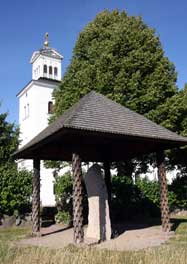 references to unknown pieces of
Norse mythology, historic references to Theodoric the Great, king of the Ostrogoths and briefly ruler of the residual Western Roman Empire, as well
as having some obscurely encrypted sections. The inscription is therefore
considered the first piece of Swedish literature, and in translation reads: references to unknown pieces of
Norse mythology, historic references to Theodoric the Great, king of the Ostrogoths and briefly ruler of the residual Western Roman Empire, as well
as having some obscurely encrypted sections. The inscription is therefore
considered the first piece of Swedish literature, and in translation reads:
In memory of
Vämod stand these runes, and Varin wrote them,
the father in memory of his dead son
I tell the young men the tale of the two war booties which 12 times were taken
from various men
This I tell second, about him who 9 generations ago lost his life with the Reidgoths, and
died with them because of his offences
<continuing in verse>
Theodoric the Bold
Chief of sea warriors
Ruled over the shores of the Hreiðsea,
Now sits armed
On his Gothic horse,
His shield strapped,
Prince of the Mærings
The inscription continues with obscure references
to unknown kings and their relatives in Själland, and invokes the Norse Aesir
god Thor.
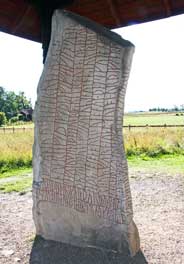 Our visit to the
Rök Runestone: we reached the small
museum close to Rök church with the huge runestone set up under a roofed
covering across the field (see above right). Displays at the museum gave background details and
interpretation of the stone and its runic inscription. Although runic experts
can translate the inscription, there is still controversy over its
interpretation: Reidgoths is a poetic name for the Ostro-Goths; Hreiðsea is
presumably the Mediterranean where the Ostro-Goths ruled, and the Mærings were
Theodoric's clan. The Scandinavian Vikings travelled far into Europe, coming
into contact with the Christianised Roman world, and would have heard tales of
Theodoric and his infamous Ostro-Goths who ruled from Ravenna; a statue of
Theodoric found in Aachen sitting with shield and lance on his horse was well
known, hence the reference in the inscription. Theodoric died in 526 AD around 9
generations before the 9th century Rök Runestone inscription; the Church
considered him a cruel, barbarous tyrant hence the reference to dying for his
offences. Perhaps the references were intended to signify the powerful
connections of Varin's family as local chieftains. The stone's scale clearly
indicate that Varin was indeed a powerful chieftain: the monument stood at the
place where Rök church would be built 3 centuries later, the village taking its
name from the stone, Rök literally meaning a stone in Old Norse. It was set up
in a prominent position so that no passer-by could avoid seeing it and
marvelling at the powerful connection of Varin and his family. Walking over to
the church with the rune stone standing alongside (see left), this great 1,300 year old
monument with its intriguingly obscure literary and mythological references
still had the power to thrill, just as Varin had intended (Photo 29 - Rök Runestone) Our visit to the
Rök Runestone: we reached the small
museum close to Rök church with the huge runestone set up under a roofed
covering across the field (see above right). Displays at the museum gave background details and
interpretation of the stone and its runic inscription. Although runic experts
can translate the inscription, there is still controversy over its
interpretation: Reidgoths is a poetic name for the Ostro-Goths; Hreiðsea is
presumably the Mediterranean where the Ostro-Goths ruled, and the Mærings were
Theodoric's clan. The Scandinavian Vikings travelled far into Europe, coming
into contact with the Christianised Roman world, and would have heard tales of
Theodoric and his infamous Ostro-Goths who ruled from Ravenna; a statue of
Theodoric found in Aachen sitting with shield and lance on his horse was well
known, hence the reference in the inscription. Theodoric died in 526 AD around 9
generations before the 9th century Rök Runestone inscription; the Church
considered him a cruel, barbarous tyrant hence the reference to dying for his
offences. Perhaps the references were intended to signify the powerful
connections of Varin's family as local chieftains. The stone's scale clearly
indicate that Varin was indeed a powerful chieftain: the monument stood at the
place where Rök church would be built 3 centuries later, the village taking its
name from the stone, Rök literally meaning a stone in Old Norse. It was set up
in a prominent position so that no passer-by could avoid seeing it and
marvelling at the powerful connection of Varin and his family. Walking over to
the church with the rune stone standing alongside (see left), this great 1,300 year old
monument with its intriguingly obscure literary and mythological references
still had the power to thrill, just as Varin had intended (Photo 29 - Rök Runestone)
Lake Tåken bird observation tower and a peaceful night's camp: a short distance from Rök, we approached the
Glänås Naturum along a single-track lane on the shores of Lake Tåken with its
bird observation tower overlooking the lake. Lake Tåken is a 44km2
hollow in an otherwise flat landscape, just 0.8m deep and surrounded by Northern
Europe's largest area of reed beds. The nutrient-rich shallow waters, extensive
reed beds, lake-shore meadows and water-logged shore-side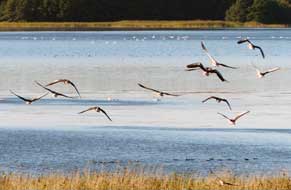 woods
attract substantial numbers and species of bird-life. The bird observation tower
gave a panoramic view over the lake and close inshore among the reeds large
numbers of shoveller ducks and greylag geese were flying around in flocks (see
right) and settling further
out. In the distance across the width of the lake, 1000s of mute swans were
gathered, and we spent a peaceful hour watching and photographing the birds. woods
attract substantial numbers and species of bird-life. The bird observation tower
gave a panoramic view over the lake and close inshore among the reeds large
numbers of shoveller ducks and greylag geese were flying around in flocks (see
right) and settling further
out. In the distance across the width of the lake, 1000s of mute swans were
gathered, and we spent a peaceful hour watching and photographing the birds.
But after a long day we needed a campsite for
tonight, and again the Swedish Camping Association's campsite listing available
free of charge in Tourist Offices came to our rescue: Paradisets Camping was just south of
the E4 motorway was conveniently on our onward route tomorrow and took us just
15 minutes to reach there. What seemed a conventional campsite next to a sports
centre was deserted on our arrival, but the warden responded to our phone call
and appeared shortly after, suggesting we might camp on the short-cropped turf
near the reception hut. With good facilities in the sports centre, and a
peaceful location overlooking open countryside, and charge of 150kr for a
night's stay, this suited us well, and we gladly settled in. As the sun set
suffusing a salmon-pink glow across the dusky sky, we enjoyed a wonderfully
peaceful evening in this quiet rural setting. Overnight the temperature fell to
an autumnal 11°C.
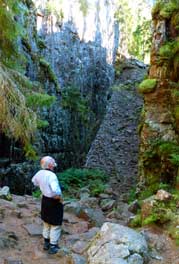 Into Småland to Eksjö and the Skurugata Gorge
nature reserve: the following morning we continued south on Route 32
through the increasingly hilly and forested Småland terrain lined with rocky
outcrops, to turn off into the small town of Eksjö. Parking among the wooden
houses in the old part of the town, we secured a town plan from the TIC along
with the location and details of the nature reserve and gorge of Skurugata. We
followed a winding, narrow lane for some 13 kms from the town out into the
hilly, forested countryside eventually reaching the Skurugata nature reserve
parking area. Although in Swedish, the map obtained from the TIC did at least
show contours and the route for the footpath circuit along the Skurugata gorge
and return over the 337m hill of Skuruhatt. We booted up taking sweaters
anticipating cool temperatures down in the bed of the gorge, and set off along
the way-marked path down into the forest. It is uncertain Into Småland to Eksjö and the Skurugata Gorge
nature reserve: the following morning we continued south on Route 32
through the increasingly hilly and forested Småland terrain lined with rocky
outcrops, to turn off into the small town of Eksjö. Parking among the wooden
houses in the old part of the town, we secured a town plan from the TIC along
with the location and details of the nature reserve and gorge of Skurugata. We
followed a winding, narrow lane for some 13 kms from the town out into the
hilly, forested countryside eventually reaching the Skurugata nature reserve
parking area. Although in Swedish, the map obtained from the TIC did at least
show contours and the route for the footpath circuit along the Skurugata gorge
and return over the 337m hill of Skuruhatt. We booted up taking sweaters
anticipating cool temperatures down in the bed of the gorge, and set off along
the way-marked path down into the forest. It is uncertain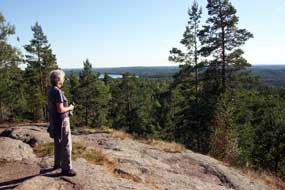 whether the of Skurugata gorge was formed by glacial melt-water erosion or a natural rift-fault
caused by tectonic movement; either way, it runs for a length of 800m, 7m wide between
sheer rock walls up to 35m in height. At the start of the gorge
the path dropped markedly with the cliff sides rising precipitously on either
side, the bed of the gorge strewn with boulders from rock-falls and crossed by
fallen trees making for slow progress. After considerable loss of height into
the dark depths of the narrowing gorge, we threaded a way through the grey-brown
porphyry and feldspar boulders and fallen trees, dropping further with the rock
side-walls rising sheer on either side (see left) (Photo 30 - Skurugata Gorge). Ahead the gorge-bed path rose steeply up
a scree-strewn slope then dropped severely again to an even greater depth. With
the temperature now markedly lower in the sunless depths of the gorge, the bed
was wet in places and in Spring may well be impassable. With progress
slow over the scree and boulders, we eventually approached the narrow gorge's end with
the narrow walls beginning to lower and the temperature noticeably beginning to
rise. A signpost pointed steeply up through the forest to the return route over
the high point of Skuruhatt; this peaceful hilltop gave distant views of lakes
and continuous Småland pine forests (see right) (Photo 31 - Distant Småland pine
forests viewed from Skuruhatt), and a marked path led back to the parking
area, after a thrilling 2 hour walk along the length of the gorge. whether the of Skurugata gorge was formed by glacial melt-water erosion or a natural rift-fault
caused by tectonic movement; either way, it runs for a length of 800m, 7m wide between
sheer rock walls up to 35m in height. At the start of the gorge
the path dropped markedly with the cliff sides rising precipitously on either
side, the bed of the gorge strewn with boulders from rock-falls and crossed by
fallen trees making for slow progress. After considerable loss of height into
the dark depths of the narrowing gorge, we threaded a way through the grey-brown
porphyry and feldspar boulders and fallen trees, dropping further with the rock
side-walls rising sheer on either side (see left) (Photo 30 - Skurugata Gorge). Ahead the gorge-bed path rose steeply up
a scree-strewn slope then dropped severely again to an even greater depth. With
the temperature now markedly lower in the sunless depths of the gorge, the bed
was wet in places and in Spring may well be impassable. With progress
slow over the scree and boulders, we eventually approached the narrow gorge's end with
the narrow walls beginning to lower and the temperature noticeably beginning to
rise. A signpost pointed steeply up through the forest to the return route over
the high point of Skuruhatt; this peaceful hilltop gave distant views of lakes
and continuous Småland pine forests (see right) (Photo 31 - Distant Småland pine
forests viewed from Skuruhatt), and a marked path led back to the parking
area, after a thrilling 2 hour walk along the length of the gorge.
Movänta Camping and the old wooden town of
Eksjö: 12kms east of Eksjö along Route 40, we found a welcoming
campsite, Movänta Camping with flat pitches spread under the pines on the shores
of Lake Försjön. Largely deserted at the end of August, this was a peaceful
setting for our next day in camp, and after a chill night we woke to a clear sky
with the sun just clearing the pines (Photo 32 - A peaceful day in camp at Movänta Camping). Refreshed after a day of chores and
writing in peaceful sunshine, we returned to Eksjö for a brief visit to this
historical wooden town. In 2003 Eksjö celebrated its 600th anniversary having
been granted its town charter in 1403 by King Eric of Pomerania. The town has
suffered its share
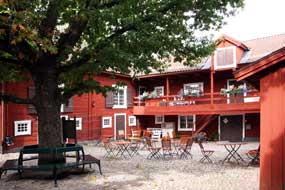 of disasters over the centuries: razed by Danish invaders in
1568, royal patronage from King Johann III enabled rebuilding, but disaster
struck again in 1856 when fire destroyed the southern part of Eksjö. Fortunately
the area of 17th century wooden houses to the north of Stortorget was saved both
from the fire and from wanton urban vandalism of the 1960s, and has been
conserved as a wooden town heritage area, the modern town expanding around and
beyond it. The town also has a long-standing military connection with the Royal
Smalandia Hussars having been garrisoned here during the 18~19th centuries and a
unit of the Swedish armed forces still having a base in the northern outskirts.
Despite this civilised little town being prepared for a weekend of 'musical'
disruption by the Eksjö Festival, we spent an hour ambling around the narrow
cobbled lanes and wooden houses with their flower-filled courtyards. Some of the
wooden cottages were painted with Falun Rödfarg, the larger wooden town houses
dressed in pastel shades. The Neo-Classical Stortorget was filled with
stage-works and marquees surrounding the statue of the Smalandian Hussar in the
centre of the town square; thankful to have missed the disruption by a day, we
returned along through the old town to the peace of the oak tree and flower
filled Lilla-torget (see left) (Photo 33 - Lilla-torget in Eksjö old wooden town). Eksjö was a charming place, perhaps not on a par with Nora
since it lacked the hand-made Nora Glass ice cream of its Bergslagen fellow wooden town (Trästäder)
(see
log of our visit). of disasters over the centuries: razed by Danish invaders in
1568, royal patronage from King Johann III enabled rebuilding, but disaster
struck again in 1856 when fire destroyed the southern part of Eksjö. Fortunately
the area of 17th century wooden houses to the north of Stortorget was saved both
from the fire and from wanton urban vandalism of the 1960s, and has been
conserved as a wooden town heritage area, the modern town expanding around and
beyond it. The town also has a long-standing military connection with the Royal
Smalandia Hussars having been garrisoned here during the 18~19th centuries and a
unit of the Swedish armed forces still having a base in the northern outskirts.
Despite this civilised little town being prepared for a weekend of 'musical'
disruption by the Eksjö Festival, we spent an hour ambling around the narrow
cobbled lanes and wooden houses with their flower-filled courtyards. Some of the
wooden cottages were painted with Falun Rödfarg, the larger wooden town houses
dressed in pastel shades. The Neo-Classical Stortorget was filled with
stage-works and marquees surrounding the statue of the Smalandian Hussar in the
centre of the town square; thankful to have missed the disruption by a day, we
returned along through the old town to the peace of the oak tree and flower
filled Lilla-torget (see left) (Photo 33 - Lilla-torget in Eksjö old wooden town). Eksjö was a charming place, perhaps not on a par with Nora
since it lacked the hand-made Nora Glass ice cream of its Bergslagen fellow wooden town (Trästäder)
(see
log of our visit).
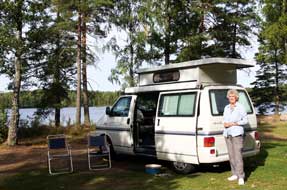 Orrefors Camping: route 32 took us
south through wooded sweeping hills and we began passing glass works of Småland's
Kingdom of Glass (Glasriket); the frequency of signs showed that the
glass industry was highly commercialised towards tourism. On arrival at Orrefors,
we discovered that the glassworks there had recently closed with the loss of
some 200 jobs; we decided therefore to stay at Orrefors Camping tonight and move
on to try to see a demonstration of glass-blowing at the Nybro glassworks
tomorrow. The campsite seemed peaceful in a pleasant lake-side setting among
pine and oak woods (see right), but appearances were deceptive. Having settled in under the
trees, it soon became clear that the owner's inhospitable manner and
overwhelming noise of traffic and road works from main road were major
negatives; we should have read the signs and moved on to the more acceptable Joelskogens Camping at Nybro. But we made the most of it, and as the evening
grew dusk a campfire was lit in the hearth by the lake with the flames lighting
up our pitch and the evening air filled with the smell of wood smoke (Photo
34 - Evening campfire at Orrefors Camping). Orrefors Camping: route 32 took us
south through wooded sweeping hills and we began passing glass works of Småland's
Kingdom of Glass (Glasriket); the frequency of signs showed that the
glass industry was highly commercialised towards tourism. On arrival at Orrefors,
we discovered that the glassworks there had recently closed with the loss of
some 200 jobs; we decided therefore to stay at Orrefors Camping tonight and move
on to try to see a demonstration of glass-blowing at the Nybro glassworks
tomorrow. The campsite seemed peaceful in a pleasant lake-side setting among
pine and oak woods (see right), but appearances were deceptive. Having settled in under the
trees, it soon became clear that the owner's inhospitable manner and
overwhelming noise of traffic and road works from main road were major
negatives; we should have read the signs and moved on to the more acceptable Joelskogens Camping at Nybro. But we made the most of it, and as the evening
grew dusk a campfire was lit in the hearth by the lake with the flames lighting
up our pitch and the evening air filled with the smell of wood smoke (Photo
34 - Evening campfire at Orrefors Camping).
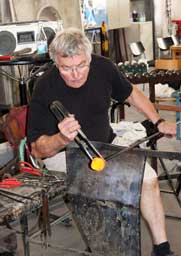 Watching glass-blowing at Pukeberg Glassworks
at Nybro: Nybro was a delightful little town, and we found the
Pukeberg Glassworks set in old brick buildings around a lawned courtyard. Gustav
Vasa had been impressed by seeing glass produced in Italy in the mid-16th
century and had introduced glass-making to Sweden whose forests produced
charcoal to fire the furnaces. Today the glassworks in Småland's Glasriket all promote
their ornate wares with vast amounts of advertising and sell at extortionate prices! We expected to have to pay a
fee to watch the exhibition of glass-blowing, but up in the workshop the
glass-blower was producing coloured glass animals. In fascination we sat and watched as he
dipped his steel rod into the 1,200°C furnace of molten glass, lifting out a
gobbet of glowing red hot glass, rolling and shaping this with tools, blending
in coloured glass fragments, heating the plug again and working at this on his Watching glass-blowing at Pukeberg Glassworks
at Nybro: Nybro was a delightful little town, and we found the
Pukeberg Glassworks set in old brick buildings around a lawned courtyard. Gustav
Vasa had been impressed by seeing glass produced in Italy in the mid-16th
century and had introduced glass-making to Sweden whose forests produced
charcoal to fire the furnaces. Today the glassworks in Småland's Glasriket all promote
their ornate wares with vast amounts of advertising and sell at extortionate prices! We expected to have to pay a
fee to watch the exhibition of glass-blowing, but up in the workshop the
glass-blower was producing coloured glass animals. In fascination we sat and watched as he
dipped his steel rod into the 1,200°C furnace of molten glass, lifting out a
gobbet of glowing red hot glass, rolling and shaping this with tools, blending
in coloured glass fragments, heating the plug again and working at this on his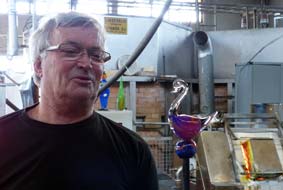 rolling bench to produce the decorative wares (see left) (Photos
35 and 36 - Glass-blower at Nybro Glassworks). Gunne Brandstedt the master
glass-blower told us he came from 3 generations of glass-blowers and having been trained by craftsmen at Murano near Venice,
he had been blowing glass for 50 years.
It was fascinating watching him as he shaped the animals proudly showing us the
result on the tip of his steel pole, and deftly tapping them off into the
annealing kiln for final slow cooling. It was a pity that today he was producing
small glass animals rather than blowing larger items.
rolling bench to produce the decorative wares (see left) (Photos
35 and 36 - Glass-blower at Nybro Glassworks). Gunne Brandstedt the master
glass-blower told us he came from 3 generations of glass-blowers and having been trained by craftsmen at Murano near Venice,
he had been blowing glass for 50 years.
It was fascinating watching him as he shaped the animals proudly showing us the
result on the tip of his steel pole, and deftly tapping them off into the
annealing kiln for final slow cooling. It was a pity that today he was producing
small glass animals rather than blowing larger items.
It was time to continue our journey south towards
Kalmar to cross the 6km high-arching bridge over to the Baltic island of Öland.
Follow us there in the next edition as we conclude our time in Sweden, exploring
Öland and the historic town of Kalmar before travelling around Sweden's southern
coastline to the naval port of Karlskrona, the Danish-founded fortress town of
Kristianstad, Kivik and the pocket-sized Stenshuset National Park, the medieval
port-town of Ystad and venue of the fictional Wallander detective stories, the
Viking fortress town of Trelleborg, and Skåne's southernmost tip at the
Falsterbo peninsula. We conclude our tour of Sweden where we started 5 months
ago at Malmö, before re-crossing the Öresund Bridge and returning through Denmark
for the ferry back to UK from Esbjerg. Join us again shortly for our concluding
episode of our 2013 Swedish travels.
Next edition
to be published shortly
|
Sheila and Paul |
Published: 18 January 2014 |
|
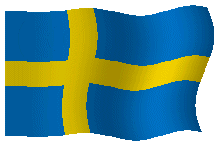
 CAMPING
IN SWEDEN 2013 - Sala silver mines, Ånundshög archaeological remains near Västerås, Norrköping, Linköping,
the locks of the Göta Canal, Vadstena, Eksjö, and the Glasriket glassworks of Småland:
CAMPING
IN SWEDEN 2013 - Sala silver mines, Ånundshög archaeological remains near Västerås, Norrköping, Linköping,
the locks of the Göta Canal, Vadstena, Eksjö, and the Glasriket glassworks of Småland: to invest their wealth in iron works,
which is what happened at here Ängelsberg. In 1680 the local land-owner developed the Ängelsberg
Bruk (estate iron works and forge) to produce pig- and wrought iron. Typical of
estate iron-works, which across Bergslagen contributed to Sweden's 17~18th
century economic prosperity, Ängelsberg increased in its technological
development and scale of production during the 19th century with charcoal-fired
blast furnace driven by increasingly powerful blowers. But competition from UK and German steel production
made smaller estate-based iron production uneconomical, and Ängelsberg
iron-works was fired for the last time in 1919. The Ängelsberg earth and timber
insulated blast furnace with its high furnace stack equipped with water-wheel
driven heated air blower, ore-crusher and ore roasting kiln have been conserved
(Photo 1 - Ängelsberg Bruk 18th~19th century blast furnace) set amid the landscaped estate and now have UNESCO World Heritage
status. Today the estate with its trimly manicured lawns and neat chocolate-box
red-painted wooden buildings was a peaceful setting; what would this scene have
looked like at the height of its industrial production?
to invest their wealth in iron works,
which is what happened at here Ängelsberg. In 1680 the local land-owner developed the Ängelsberg
Bruk (estate iron works and forge) to produce pig- and wrought iron. Typical of
estate iron-works, which across Bergslagen contributed to Sweden's 17~18th
century economic prosperity, Ängelsberg increased in its technological
development and scale of production during the 19th century with charcoal-fired
blast furnace driven by increasingly powerful blowers. But competition from UK and German steel production
made smaller estate-based iron production uneconomical, and Ängelsberg
iron-works was fired for the last time in 1919. The Ängelsberg earth and timber
insulated blast furnace with its high furnace stack equipped with water-wheel
driven heated air blower, ore-crusher and ore roasting kiln have been conserved
(Photo 1 - Ängelsberg Bruk 18th~19th century blast furnace) set amid the landscaped estate and now have UNESCO World Heritage
status. Today the estate with its trimly manicured lawns and neat chocolate-box
red-painted wooden buildings was a peaceful setting; what would this scene have
looked like at the height of its industrial production? improved
with water-powered pumps and hoists, deeper mining developed. A small township
grew up south of the mines housing miners and their families, with
over 1000 living there at its height. By Gustav Vasa's reign (1523~60) with Sweden now
independent of Danish domination, the output from Sala's silver mine was a
mainstay of the new state's economy with the result that the mine was described
as the 'Treasury of Sweden'. But as shafts and galleries were dug deeper,
serious cave-ins threatened this
vital economic resource. German mining experts were brought in during the later
16th century; new shafts were dug and more systematically planned and surveyed
galleries developed. An entire surface system of canals and ponds was created to
drive water-wheels to power pumps and hoists for extracting the ore which was
transported 2 kms north for refining, crushing and smelting to retrieve the
minute quantities of silver from the galena mineral. Subsidence of the older
workings made them unusable and the old mining village unsafe for habitation,
and a new town developed where the modern town of Sala now stands just to the
north of the mine.
improved
with water-powered pumps and hoists, deeper mining developed. A small township
grew up south of the mines housing miners and their families, with
over 1000 living there at its height. By Gustav Vasa's reign (1523~60) with Sweden now
independent of Danish domination, the output from Sala's silver mine was a
mainstay of the new state's economy with the result that the mine was described
as the 'Treasury of Sweden'. But as shafts and galleries were dug deeper,
serious cave-ins threatened this
vital economic resource. German mining experts were brought in during the later
16th century; new shafts were dug and more systematically planned and surveyed
galleries developed. An entire surface system of canals and ponds was created to
drive water-wheels to power pumps and hoists for extracting the ore which was
transported 2 kms north for refining, crushing and smelting to retrieve the
minute quantities of silver from the galena mineral. Subsidence of the older
workings made them unusable and the old mining village unsafe for habitation,
and a new town developed where the modern town of Sala now stands just to the
north of the mine. During the 17th century, the State's revenue
from Sala Silver Mine's output financed Gustav II Adolfus' foreign wars, with
shafts cut deeper and galleries spreading sideways into the veins of ore
deposits; the silver mine financed the construction of the ill-fated royal
warship Vasa. Improved technology for pumping and winching in the 18~19th
centuries enabled even deeper shafts to be driven, initially down to 60m, then
155m and the deepest working level at 318m, each of the shafts named after royal
beneficiaries of the mine's income - Queen Christina's Shaft, Gustav II's Shaft
and Carl XI's Shaft. Until the 19th century, fire-setting was the only means of
advancing shafts and galleries, with wood fired overnight against the workings
to break the rock; smoke was cleared by ventilation shafts and miners worked
with picks to extract the ore, advancing the face just 10cms a day. It was
desperately gruelling work in a hazardous environment with rock-falls frequent,
dust a major cause of lung disease, and only wood torches for lighting. The
Swedish State gained its silver revenue at vast human cost. Only in the mid-19th
century did black powder and later Nobel's dynamite become a reliable explosive,
enabling greater advance in the driving of galleries; steam powered and later
electrically operated pumps enabled even deeper shafts. The main mine ceased in 1908
but extraction of silver and lead continued until 1962 when all mining activity
at Sala ended. The deeper working levels below 155m have now flooded, but
tourist visits now take place down to the 60m and 155m levels which are
maintained.
During the 17th century, the State's revenue
from Sala Silver Mine's output financed Gustav II Adolfus' foreign wars, with
shafts cut deeper and galleries spreading sideways into the veins of ore
deposits; the silver mine financed the construction of the ill-fated royal
warship Vasa. Improved technology for pumping and winching in the 18~19th
centuries enabled even deeper shafts to be driven, initially down to 60m, then
155m and the deepest working level at 318m, each of the shafts named after royal
beneficiaries of the mine's income - Queen Christina's Shaft, Gustav II's Shaft
and Carl XI's Shaft. Until the 19th century, fire-setting was the only means of
advancing shafts and galleries, with wood fired overnight against the workings
to break the rock; smoke was cleared by ventilation shafts and miners worked
with picks to extract the ore, advancing the face just 10cms a day. It was
desperately gruelling work in a hazardous environment with rock-falls frequent,
dust a major cause of lung disease, and only wood torches for lighting. The
Swedish State gained its silver revenue at vast human cost. Only in the mid-19th
century did black powder and later Nobel's dynamite become a reliable explosive,
enabling greater advance in the driving of galleries; steam powered and later
electrically operated pumps enabled even deeper shafts. The main mine ceased in 1908
but extraction of silver and lead continued until 1962 when all mining activity
at Sala ended. The deeper working levels below 155m have now flooded, but
tourist visits now take place down to the 60m and 155m levels which are
maintained. showing us a sectional plan of the centuries old mine workings and
detailing their history. Throughout the mine's history access to the deeper
reaches had been by a series of wooden ladders. We started underground however
down a series of steep, winding stone steps to a gallery where the guide gave us
further technical details of working methods. He led us to a fenced portal
opening into the vast Christina Shaft 20m in diameter and dropping fully to the
deepest working level. Looking upwards glimpses of daylight could be seen, but
downwards into the fearsome depths endlessly to the now flooded lower levels
nothing but darkness with perhaps just a hint of water. This had been the mine's
principal working shaft at the height of its late 19th century working. In what
seemed like a 3-dimensional maze of tunnels and galleries, we descended metal
rungs to a lower level where the guide issued torches for the next stage of descent into
partial darkness via a narrow and open spiral ladder.
showing us a sectional plan of the centuries old mine workings and
detailing their history. Throughout the mine's history access to the deeper
reaches had been by a series of wooden ladders. We started underground however
down a series of steep, winding stone steps to a gallery where the guide gave us
further technical details of working methods. He led us to a fenced portal
opening into the vast Christina Shaft 20m in diameter and dropping fully to the
deepest working level. Looking upwards glimpses of daylight could be seen, but
downwards into the fearsome depths endlessly to the now flooded lower levels
nothing but darkness with perhaps just a hint of water. This had been the mine's
principal working shaft at the height of its late 19th century working. In what
seemed like a 3-dimensional maze of tunnels and galleries, we descended metal
rungs to a lower level where the guide issued torches for the next stage of descent into
partial darkness via a narrow and open spiral ladder. rung-ways dropping vertically into
the depths to be negotiated, and rock-strewn passageways with only a torch for
illumination. No nannying from the guide, with visitors having to take care for
themselves. The commentary was fulsomely detailed with opportunity for
questions; without doubt, despite our initial reservations, this was the finest
mine visit we had made, giving a realistic impression of the mine's scale of working environment. Our experience would commend others to walk the surface
route at Falun copper mine and make the 60m underground visit here at Sala
Silver Mine.
rung-ways dropping vertically into
the depths to be negotiated, and rock-strewn passageways with only a torch for
illumination. No nannying from the guide, with visitors having to take care for
themselves. The commentary was fulsomely detailed with opportunity for
questions; without doubt, despite our initial reservations, this was the finest
mine visit we had made, giving a realistic impression of the mine's scale of working environment. Our experience would commend others to walk the surface
route at Falun copper mine and make the 60m underground visit here at Sala
Silver Mine. South to the Anundshög Iron Age burial ground near Västerås: we headed south
from Sala on Route 56, turning off on back-lanes to the Iron Age burial site at Anundshög 6kms
east of Västerås. As early as the 1,500 BC Bronze Age, people were already settling and
farming along the Badelunda ridge which stretched eastwards towards Lake Mäleren.
In these days before the land rose this was on a bay, the furthest inland point
of an inlet from
South to the Anundshög Iron Age burial ground near Västerås: we headed south
from Sala on Route 56, turning off on back-lanes to the Iron Age burial site at Anundshög 6kms
east of Västerås. As early as the 1,500 BC Bronze Age, people were already settling and
farming along the Badelunda ridge which stretched eastwards towards Lake Mäleren.
In these days before the land rose this was on a bay, the furthest inland point
of an inlet from the sea, and remains have been found of a landing-stage at a
time when the ship was a significant means of travel. As the land rose, further
land emerged below the ridge cultivated by this prehistoric settled agricultural
society. Trade routes and water courses met around the Badelunda ridge, and both
archaeological finds and the surviving grave-fields show that an important power
centre ruled by a leading clan chieftain developed here at Anundshög during the early
Iron Age between 500~1050 AD. Around 500 visible graves survive with an unknown
number still undiscovered, of varying forms - burial mounds, stone ship-settings
and standing stones (see left). The largest is the great burial mound tumulus at Anundshög, Sweden's largest at 9m high and 64m in diameter created around the
10th century AD. Many of the mounds were plundered in antiquity and the
Anundshög tumulus has never been excavated. Built on a foundation of clay on which
the dead were cremated along with grave goods, the remains were covered with
stones and turf to raise the mound, the scale of the Anundshög tumulus and the
numbers involved in its construction indicating this was a powerful chieftain
who controlled large tracts of land. Around the mound were 5 large
ship-settings, another form of burial memorial associated with pagan ritual.
Again the scale suggests this was a sacred site ruled by a powerful chieftain.
Nearby a large and ornate rune stone was raised with a line of standing stones
marking a roadway leading to a forded river crossing, further indicators that he
who controlled communications routes and river-crossings with Anundshög at the
hub was indeed a powerful chieftain. The names of these rulers and their power
centre are unknown, but the burial site is now referred to by its later Medieval
name of Anundshög, the burial mound of Anund the chieftain's legendary name. By
Medieval times and the conversion to Christianity, the pagan ship-settings were
overturned and the rune stone torn down in an attempt to obliterate the pagan
past. A more settled agricultural society developed at Anundshög and the former
chieftain's territories divided up, with the former sacred burial site becoming
a meeting place for the local Thing, the district
the sea, and remains have been found of a landing-stage at a
time when the ship was a significant means of travel. As the land rose, further
land emerged below the ridge cultivated by this prehistoric settled agricultural
society. Trade routes and water courses met around the Badelunda ridge, and both
archaeological finds and the surviving grave-fields show that an important power
centre ruled by a leading clan chieftain developed here at Anundshög during the early
Iron Age between 500~1050 AD. Around 500 visible graves survive with an unknown
number still undiscovered, of varying forms - burial mounds, stone ship-settings
and standing stones (see left). The largest is the great burial mound tumulus at Anundshög, Sweden's largest at 9m high and 64m in diameter created around the
10th century AD. Many of the mounds were plundered in antiquity and the
Anundshög tumulus has never been excavated. Built on a foundation of clay on which
the dead were cremated along with grave goods, the remains were covered with
stones and turf to raise the mound, the scale of the Anundshög tumulus and the
numbers involved in its construction indicating this was a powerful chieftain
who controlled large tracts of land. Around the mound were 5 large
ship-settings, another form of burial memorial associated with pagan ritual.
Again the scale suggests this was a sacred site ruled by a powerful chieftain.
Nearby a large and ornate rune stone was raised with a line of standing stones
marking a roadway leading to a forded river crossing, further indicators that he
who controlled communications routes and river-crossings with Anundshög at the
hub was indeed a powerful chieftain. The names of these rulers and their power
centre are unknown, but the burial site is now referred to by its later Medieval
name of Anundshög, the burial mound of Anund the chieftain's legendary name. By
Medieval times and the conversion to Christianity, the pagan ship-settings were
overturned and the rune stone torn down in an attempt to obliterate the pagan
past. A more settled agricultural society developed at Anundshög and the former
chieftain's territories divided up, with the former sacred burial site becoming
a meeting place for the local Thing, the district
 court which met to
resolve disputes. Badelunda church was built in the 13th century, its scale
again indicating that this was still an affluent farming community.
court which met to
resolve disputes. Badelunda church was built in the 13th century, its scale
again indicating that this was still an affluent farming community. stone, erected
in the late 10th century by a wealthy
land-owner to mark out his establishment of the road (see above right); in translation the runes
read: Folkvid raised these stones in memory of his son Heden, brother of
Anund; Vred carved the runes. Clearly this was a powerful man who set up
this imposing monument to tell the world for all time of his son, his road, and
himself. Vred was a skilful rune carver and produced an elegant pictorial design
of unknown significance around which the runic dedication is inscribed
(Photo 5 - Anundshög Rune stone and burial-mounds).
The top of the Anundshög burial mound gave a bird's eye view across the outline
of the 2 largest ship-settings (see left).
stone, erected
in the late 10th century by a wealthy
land-owner to mark out his establishment of the road (see above right); in translation the runes
read: Folkvid raised these stones in memory of his son Heden, brother of
Anund; Vred carved the runes. Clearly this was a powerful man who set up
this imposing monument to tell the world for all time of his son, his road, and
himself. Vred was a skilful rune carver and produced an elegant pictorial design
of unknown significance around which the runic dedication is inscribed
(Photo 5 - Anundshög Rune stone and burial-mounds).
The top of the Anundshög burial mound gave a bird's eye view across the outline
of the 2 largest ship-settings (see left). Industries whose generating plant we had seen at Porjus hydro-electric station was the city's main employer, and we passed a huge Bombardier engineering plant. Weaving a way through narrow winding
streets around the centre, thankful it was Sunday afternoon with minimal
traffic, we reached Västerås Domkyrkan. The red-brick cathedral was begun in the
13th century with Tessin the Younger adding the Baroque spire in 1695. We ambled
around the cathedral's chapels and memorials, noting the sarcophagus of Eric
XIV, Gustav Vasa's deranged son who was poisoned by his brother with
arsenic-laced soup in the internecine royal struggles following Vasa's death.
After a walk around the lanes and attractive wooden cottages of Kyrkbacken, the
old district behind the cathedral, we left Västerås and turned south onto Route
56 eventually crossing an arm of Lake Mälaren to find Mälarbadens Camping near
to Torshälla on the southern shore of the lake. This turned out to be a mediocre
and meanly penny-pinching campsite with additional coin charges for all the
basic facilities you should normally be able to take for granted; thankfully it
was only a one night stop.
Industries whose generating plant we had seen at Porjus hydro-electric station was the city's main employer, and we passed a huge Bombardier engineering plant. Weaving a way through narrow winding
streets around the centre, thankful it was Sunday afternoon with minimal
traffic, we reached Västerås Domkyrkan. The red-brick cathedral was begun in the
13th century with Tessin the Younger adding the Baroque spire in 1695. We ambled
around the cathedral's chapels and memorials, noting the sarcophagus of Eric
XIV, Gustav Vasa's deranged son who was poisoned by his brother with
arsenic-laced soup in the internecine royal struggles following Vasa's death.
After a walk around the lanes and attractive wooden cottages of Kyrkbacken, the
old district behind the cathedral, we left Västerås and turned south onto Route
56 eventually crossing an arm of Lake Mälaren to find Mälarbadens Camping near
to Torshälla on the southern shore of the lake. This turned out to be a mediocre
and meanly penny-pinching campsite with additional coin charges for all the
basic facilities you should normally be able to take for granted; thankfully it
was only a one night stop. The legend of Sigurd Fafnesbane (Siegfried
the Dragon-Slayer) goes like this: once upon a time, an ancient magician named
Rodmar had 3 sons, each with remarkable powers. The first son Otr was able to
take on the shape of an otter when fishing for salmon; one of the Norse gods
Loki happened to be passing and threw a rock at the otter killing it. Rodmar
the father was mightily displeased at this and demanded that the god make
recompense for killing his son by filling the otter skin with golden treasure as
atonement. Loki went to the rapids and used his net to catch the dwarf Andvari
who had taken the shape of a pike. The dwarf purchased his freedom with all the
gold he possessed except for one gold ring; when Loki ripped the ring from his
finger, the dwarf placed a curse upon all who came into contact with the
treasure. Once Rodmar received the gold as payment for Otr's killing, the curse
brought greed upon him causing him to resent sharing the treasure with his other
2 sons Fafnir and Regin. Fafnir became so enraged that he killed his father to
get his hands on all the gold, and taking on the form of a snake-like dragon, he
went to brood at a place called Gnitaheden curled up on his pile of gold. The
curse of the ring continued: Regin, a skilful blacksmith, wanted his share of
the patrimony and planned to seize the treasure by trickery bringing into his
plans Sigurd whom he had earlier adopted as his step-son, forging him a razor-sharp
sword called Gram. Urged on by Regin, Sigurd dug a pit-trap near to where Fafnir
in the form of a dragon had slithered down to a lake to drink. Fafnir falls into
the trap and Sigurd stabs him to death with his sword Gram, so gaining the
honorific of Fafnesbane (Slayer of Fafnir). Sigurd cuts up the dragon, but in
roasting its heart on an open fire he burns his hand. Sucking his finger to soothe
the
The legend of Sigurd Fafnesbane (Siegfried
the Dragon-Slayer) goes like this: once upon a time, an ancient magician named
Rodmar had 3 sons, each with remarkable powers. The first son Otr was able to
take on the shape of an otter when fishing for salmon; one of the Norse gods
Loki happened to be passing and threw a rock at the otter killing it. Rodmar
the father was mightily displeased at this and demanded that the god make
recompense for killing his son by filling the otter skin with golden treasure as
atonement. Loki went to the rapids and used his net to catch the dwarf Andvari
who had taken the shape of a pike. The dwarf purchased his freedom with all the
gold he possessed except for one gold ring; when Loki ripped the ring from his
finger, the dwarf placed a curse upon all who came into contact with the
treasure. Once Rodmar received the gold as payment for Otr's killing, the curse
brought greed upon him causing him to resent sharing the treasure with his other
2 sons Fafnir and Regin. Fafnir became so enraged that he killed his father to
get his hands on all the gold, and taking on the form of a snake-like dragon, he
went to brood at a place called Gnitaheden curled up on his pile of gold. The
curse of the ring continued: Regin, a skilful blacksmith, wanted his share of
the patrimony and planned to seize the treasure by trickery bringing into his
plans Sigurd whom he had earlier adopted as his step-son, forging him a razor-sharp
sword called Gram. Urged on by Regin, Sigurd dug a pit-trap near to where Fafnir
in the form of a dragon had slithered down to a lake to drink. Fafnir falls into
the trap and Sigurd stabs him to death with his sword Gram, so gaining the
honorific of Fafnesbane (Slayer of Fafnir). Sigurd cuts up the dragon, but in
roasting its heart on an open fire he burns his hand. Sucking his finger to soothe
the burn, he tastes the dragon's blood and instantly acquires the power to
understand the prophetic songs of birds sitting in a nearby tree who warn Sigurd
of Regin's evil plans to kill him and seize the treasure for himself. The birds
advise Sigurd to strike first and to kill Regin. Sigurd cuts off Regin's head to
escape his evil thoughts in the future; he returns to Fafnir's lair and loads
all the treasure onto his faithful horse Grani which is a direct descendent of
Odin's horse Sleipnir.
burn, he tastes the dragon's blood and instantly acquires the power to
understand the prophetic songs of birds sitting in a nearby tree who warn Sigurd
of Regin's evil plans to kill him and seize the treasure for himself. The birds
advise Sigurd to strike first and to kill Regin. Sigurd cuts off Regin's head to
escape his evil thoughts in the future; he returns to Fafnir's lair and loads
all the treasure onto his faithful horse Grani which is a direct descendent of
Odin's horse Sleipnir. passage to heaven. And sure enough, as we stood by the rock panel admiring
this remarkable inscription from the 11th century AD, there below us we could
see parts of a stone roadway and abutments of the bridge which had once spanned
the river and which the inscription had
celebrated.
passage to heaven. And sure enough, as we stood by the rock panel admiring
this remarkable inscription from the 11th century AD, there below us we could
see parts of a stone roadway and abutments of the bridge which had once spanned
the river and which the inscription had
celebrated. Eskilstuna and the Rademacher Forges: driving on into the small
town of Eskilstuna, we parked close to the centre to find the Rademacher Forges,
a preserved skansen-museum of 17th century cottage-industry iron smiths' forges.
Like nearby Västerås,
Eskilstuna had traditionally been an iron-working and metal crafts town,
drawing on the iron mined and smelted in Bergslagen, and producing both
household iron wares, horse equipment and arms for the Swedish military. In
the 1650s King Karl X Gustav had persuaded Reinhold Rademacher, a German iron
manufacturer in Swedish occupied Livonia (modern Latvia), to come to Sweden to
help develop forging skills. A group of 20 cottage-smithies for master-craftsmen
and apprentices was created each with an allowance of land for grazing and
growing crops. The surviving remains are now preserved at Eskilstuna as a
museum, all now rather twee and craft-shoppe, but before continuing south to Norrköping,
we did learn more from the museum attendant about the town's history of
iron-making and its still significant engineering industry.
A long afternoon drive on Route 55
brought us south to join the E4 motorway for a brief section around Norrköping to turn off at
the western approaches to the city to reach Himmelstalunds Camping.
Eskilstuna and the Rademacher Forges: driving on into the small
town of Eskilstuna, we parked close to the centre to find the Rademacher Forges,
a preserved skansen-museum of 17th century cottage-industry iron smiths' forges.
Like nearby Västerås,
Eskilstuna had traditionally been an iron-working and metal crafts town,
drawing on the iron mined and smelted in Bergslagen, and producing both
household iron wares, horse equipment and arms for the Swedish military. In
the 1650s King Karl X Gustav had persuaded Reinhold Rademacher, a German iron
manufacturer in Swedish occupied Livonia (modern Latvia), to come to Sweden to
help develop forging skills. A group of 20 cottage-smithies for master-craftsmen
and apprentices was created each with an allowance of land for grazing and
growing crops. The surviving remains are now preserved at Eskilstuna as a
museum, all now rather twee and craft-shoppe, but before continuing south to Norrköping,
we did learn more from the museum attendant about the town's history of
iron-making and its still significant engineering industry.
A long afternoon drive on Route 55
brought us south to join the E4 motorway for a brief section around Norrköping to turn off at
the western approaches to the city to reach Himmelstalunds Camping. Norrköping,
the 'Manchester of Sweden': we had 2 reasons for visiting Norrköping (pronounced Nor-shurping):
one was to learn about the city's conserved textile industrial
heritage, the other its even older historical heritage dating back over 3,000
years; glancing across the river valley from the campsite, panels of bed-rock
were visible in the hill-side parklands containing the Himmelstalund Bronze Age
rock engravings. On a bright sunny morning with just a hazy hint of autumnal
dewiness on the grass, we crossed the footbridge beyond the campsite to walk the
2 kms along the river into the city. Norrköping's development as an industrial
city blossomed in the 19th century with the fast-flowing Motala ström providing
motive power for textile and paper mills built along the river. At one time, 70%
of Sweden's textiles were produced in Norrköping gaining it the nickname of
Sweden's Manchester. People flocked in from the surrounding countryside as
cheap labour
Norrköping,
the 'Manchester of Sweden': we had 2 reasons for visiting Norrköping (pronounced Nor-shurping):
one was to learn about the city's conserved textile industrial
heritage, the other its even older historical heritage dating back over 3,000
years; glancing across the river valley from the campsite, panels of bed-rock
were visible in the hill-side parklands containing the Himmelstalund Bronze Age
rock engravings. On a bright sunny morning with just a hazy hint of autumnal
dewiness on the grass, we crossed the footbridge beyond the campsite to walk the
2 kms along the river into the city. Norrköping's development as an industrial
city blossomed in the 19th century with the fast-flowing Motala ström providing
motive power for textile and paper mills built along the river. At one time, 70%
of Sweden's textiles were produced in Norrköping gaining it the nickname of
Sweden's Manchester. People flocked in from the surrounding countryside as
cheap labour for the factories, but there was a blacker side to the city's image
of productive industry and affluence: cramped housing with overcrowded,
insanitary conditions made for appalling, disease-ridden living standards, and
with poor health-care facilities tuberculosis was a major killer until well into
the 20th century. Education and schooling was almost non-existent for children
of working families, wages were low with plentiful supplies of labour and
were frequently cut to maintain productive competitiveness and increased profits for
factory owners. The Swedish Manchester was as much an embodiment of the
Dark Satanic Mills as its English namesake. Amid such appalling social
conditions, factories multiplied and their owners grew rich, but post-WW2
overseas competition and lessening demand for conventional woollen and cotton
fabrics with the advent of man-made fibres brought serial decline, and in the
post-industrial age, the last textile mills closed in 1992. With serious loss of
employment opportunity, Norrköping struggled to attract decentralising
government departments to provide alternative employment, but despite PR
campaigns promoting the city's modern image, reality was starkly different for
working people: housing standards remained poor and rents unaffordable. In the
late 1990s, facing a social crisis, Norrköping re-invented itself in the
for the factories, but there was a blacker side to the city's image
of productive industry and affluence: cramped housing with overcrowded,
insanitary conditions made for appalling, disease-ridden living standards, and
with poor health-care facilities tuberculosis was a major killer until well into
the 20th century. Education and schooling was almost non-existent for children
of working families, wages were low with plentiful supplies of labour and
were frequently cut to maintain productive competitiveness and increased profits for
factory owners. The Swedish Manchester was as much an embodiment of the
Dark Satanic Mills as its English namesake. Amid such appalling social
conditions, factories multiplied and their owners grew rich, but post-WW2
overseas competition and lessening demand for conventional woollen and cotton
fabrics with the advent of man-made fibres brought serial decline, and in the
post-industrial age, the last textile mills closed in 1992. With serious loss of
employment opportunity, Norrköping struggled to attract decentralising
government departments to provide alternative employment, but despite PR
campaigns promoting the city's modern image, reality was starkly different for
working people: housing standards remained poor and rents unaffordable. In the
late 1990s, facing a social crisis, Norrköping re-invented itself in the
 image-conscious,
non-productive new world: former industrial buildings clustered along the river
in the city centre were conserved and converted to museums, restaurants,
cultural centres and premises for higher education. The tourist era had arrived with a vengeance. Walkways
threaded between the factory chimneys of now deserted former industrial
buildings along the banks of canals, sluices and mill-races that once powered
the factories, their cascades now becoming 'features' of the new Industrial
Landscape (Industrilandskapet).
image-conscious,
non-productive new world: former industrial buildings clustered along the river
in the city centre were conserved and converted to museums, restaurants,
cultural centres and premises for higher education. The tourist era had arrived with a vengeance. Walkways
threaded between the factory chimneys of now deserted former industrial
buildings along the banks of canals, sluices and mill-races that once powered
the factories, their cascades now becoming 'features' of the new Industrial
Landscape (Industrilandskapet). We were
over-awed by the surroundings of old factories and the rushing sound of water
surging along the labyrinth of channels and weirs set along the river's natural fall
over rapids which during the 19~20th centuries had been harnessed to power the factories. The waters spilled over a 300m long weir
dropping from the lip of a higher basin to form the centrepiece of the
Industrial Landscape conserved buildings
(see left) (Photo 8 - Motala ström weir in Norrköping's Industrial Landscape). One of these is the
We were
over-awed by the surroundings of old factories and the rushing sound of water
surging along the labyrinth of channels and weirs set along the river's natural fall
over rapids which during the 19~20th centuries had been harnessed to power the factories. The waters spilled over a 300m long weir
dropping from the lip of a higher basin to form the centrepiece of the
Industrial Landscape conserved buildings
(see left) (Photo 8 - Motala ström weir in Norrköping's Industrial Landscape). One of these is the  1962, giving a gruelling insight into the squalid living conditions
and arduous working hours of Norrköping's mill workers. Another exhibition
illustrated Norrköping's decline from its period of
industrial greatness, showing the 1950s demolition of confined, insanitary
housing and promotion of Norrköping as the bright, new, modern place to live and
work; the reality however was that with industrial wages still so low, employees
could not afford the rents and cost of living in the new apartments. Factory
closures of the 1980~90s brought further decline, with some of the country's
worst levels of unemployment; with no prospects, Norrköping was the place people
wanted to get away from. This was the city's real face rather than the
PR-tourist hype which dominates the image presented to today's visitors.
1962, giving a gruelling insight into the squalid living conditions
and arduous working hours of Norrköping's mill workers. Another exhibition
illustrated Norrköping's decline from its period of
industrial greatness, showing the 1950s demolition of confined, insanitary
housing and promotion of Norrköping as the bright, new, modern place to live and
work; the reality however was that with industrial wages still so low, employees
could not afford the rents and cost of living in the new apartments. Factory
closures of the 1980~90s brought further decline, with some of the country's
worst levels of unemployment; with no prospects, Norrköping was the place people
wanted to get away from. This was the city's real face rather than the
PR-tourist hype which dominates the image presented to today's visitors. pleasant river-side walk across to Carl Johann Park where some 10,000 cacti are arranged each year in a
floral display in front of Bernadotte's statue, and city trams trundle along Drottninggatan past the monumentally unsightly Rådhus
(see right). We returned along the
riverside walkways above the weirs and industrial buildings to find the Norrköping Stads-museum, housed in
the bewilderingly multi-storeyed industrial premises of a former textile-weaving
and dying mill with its boiler house and factory chimney. The museum's displays
aim to illustrate Norrköping's textile industrial past. The former yarn-spinning
and weaving halls are now filled with historical textile machinery which was
operated and explained for us by a lady who clearly knew her warp from her weft (Photo 11 - Textile weaving machine in Norrköping's City Museum).
Jacquard weaving machines controlled by continuous punch-card drives produced
fabrics with regular geometric damask designs used for table clothes, curtains
and upholstery. Shuttles flew back and forth 200 times a minute and the
pleasant river-side walk across to Carl Johann Park where some 10,000 cacti are arranged each year in a
floral display in front of Bernadotte's statue, and city trams trundle along Drottninggatan past the monumentally unsightly Rådhus
(see right). We returned along the
riverside walkways above the weirs and industrial buildings to find the Norrköping Stads-museum, housed in
the bewilderingly multi-storeyed industrial premises of a former textile-weaving
and dying mill with its boiler house and factory chimney. The museum's displays
aim to illustrate Norrköping's textile industrial past. The former yarn-spinning
and weaving halls are now filled with historical textile machinery which was
operated and explained for us by a lady who clearly knew her warp from her weft (Photo 11 - Textile weaving machine in Norrköping's City Museum).
Jacquard weaving machines controlled by continuous punch-card drives produced
fabrics with regular geometric damask designs used for table clothes, curtains
and upholstery. Shuttles flew back and forth 200 times a minute and the noise
was deafening (see left). The precision of this wonderful engineering was alluringly
impressive, but its application relied on the industrialised exploitation of
textile workers who spent their long working hours minding several such
machines. They were paid a pittance on piece rates, and breakdowns, empty bobbins or faults in the weave could lose them a
whole day's earnings.
Displays in other galleries illustrated the many trades associated with an
industrial city: milliners, hat and glove makers, cobblers, barbers,
confectioners, chimney sweeps, smiths, brick-layers, wheel and wagon wrights,
coopers and goldsmiths.
noise
was deafening (see left). The precision of this wonderful engineering was alluringly
impressive, but its application relied on the industrialised exploitation of
textile workers who spent their long working hours minding several such
machines. They were paid a pittance on piece rates, and breakdowns, empty bobbins or faults in the weave could lose them a
whole day's earnings.
Displays in other galleries illustrated the many trades associated with an
industrial city: milliners, hat and glove makers, cobblers, barbers,
confectioners, chimney sweeps, smiths, brick-layers, wheel and wagon wrights,
coopers and goldsmiths. The
Bronze Age rock-engravings at Norrköping:
some 7,000 rock engravings
have been found at several sites around Norrköping chiselled into bed-rock
panels along the Motala Ström river, dating from the 1,500~500 BC Bronze Age.
Sea levels were higher then and today's bare hillsides would have been
islands with the waters of Bråviken reaching further inland to what is now
The
Bronze Age rock-engravings at Norrköping:
some 7,000 rock engravings
have been found at several sites around Norrköping chiselled into bed-rock
panels along the Motala Ström river, dating from the 1,500~500 BC Bronze Age.
Sea levels were higher then and today's bare hillsides would have been
islands with the waters of Bråviken reaching further inland to what is now Norrköping
city centre. The Motala Ström would have been the main communications route for
the pastoralist peoples who lived along the shores in permanent
settlements, living by farming wheat and barley and by animal husbandry of sheep,
cattle and pigs and supplementing their diet by hunting. The rock-carvings accumulated over a 1000 year period, some overlapping others at what must have
been a shore-side social, cult-religious and trading centre. The carvings were
dated to the Bronze Age from the distinctive shapes of swords and axes which
feature in the engravings. People gathered at the cult-site seeking support for
good harvests and success in the hunt from the gods who controlled the weather
and ruled the necessities of life. As elsewhere, the carvings' themes reflected
this life style of the people who created them. Ships occur regularly on the
panels of engravings, again reflecting their importance as a means of Bronze
Age transport; the size of the vessels portrayed perhaps shows them as more
figurative representing the passage from life to death.
Norrköping
city centre. The Motala Ström would have been the main communications route for
the pastoralist peoples who lived along the shores in permanent
settlements, living by farming wheat and barley and by animal husbandry of sheep,
cattle and pigs and supplementing their diet by hunting. The rock-carvings accumulated over a 1000 year period, some overlapping others at what must have
been a shore-side social, cult-religious and trading centre. The carvings were
dated to the Bronze Age from the distinctive shapes of swords and axes which
feature in the engravings. People gathered at the cult-site seeking support for
good harvests and success in the hunt from the gods who controlled the weather
and ruled the necessities of life. As elsewhere, the carvings' themes reflected
this life style of the people who created them. Ships occur regularly on the
panels of engravings, again reflecting their importance as a means of Bronze
Age transport; the size of the vessels portrayed perhaps shows them as more
figurative representing the passage from life to death. At the Rock Carvings Museum by the bypass bridge, we
had arranged to meet the following morning with Theres and Daniel,
2 of the Norrköping city archaeologists, at the Himmelstalund rock-engravings
site to find out more about the Bronze Age carvings (see above left). On the parkland hillside on the opposite side of the river from the
campsite and at 2 other locations, they guided us around the panels of engravings and explained their
At the Rock Carvings Museum by the bypass bridge, we
had arranged to meet the following morning with Theres and Daniel,
2 of the Norrköping city archaeologists, at the Himmelstalund rock-engravings
site to find out more about the Bronze Age carvings (see above left). On the parkland hillside on the opposite side of the river from the
campsite and at 2 other locations, they guided us around the panels of engravings and explained their significance and meaning (Photo 12 - The Fiskeby rock-engravings site). There are some 1,600 engravings at Himmelstalund and
the concentration here indicates that this was probably the principal cult-site
of the region's settlements. Most of the carvings have been coloured in
with red paint to make them more visible for modern-day visitors; without the paint, it
would have been almost impossible to identify them. For the rest of the morning,
the 2 archaeologists led us on a detailed tour of the engravings panel by panel,
giving interpretation of the beliefs and life-style of the Bronze Age people who
farmed these shores 3,000 years ago and created the engravings. The predominance
of ship engravings showed 2 styles of boat, the older having
in-curving stem- and stern-posts, the newer outward curving prows and sterns
with animal figure heads. Some larger ships had markings symbolising crews of
rowers, others were decorated with tree-of-life symbols; the pine had only just
begun to colonise southern Scandinavia in the warmer post-glacial climate when
the carvings were made. Some of the ships had solidly engraved hulls, others had
hulls decorated with cross-patterning finely engraved with a bronze chisel
rather than flint. Some ships were superimposed by a line of long-necked horses,
sacred animals in Bronze Age pagan belief and sacrificed as offerings to
the gods. One of the Bronze Age carved ships had been enhanced by the addition
of 6 runic characters dated to the late Iron Age almost 1,500 years younger than
the pictorial engraving, perhaps indicating Himmelstalund's long continuation as
a cult-site.
significance and meaning (Photo 12 - The Fiskeby rock-engravings site). There are some 1,600 engravings at Himmelstalund and
the concentration here indicates that this was probably the principal cult-site
of the region's settlements. Most of the carvings have been coloured in
with red paint to make them more visible for modern-day visitors; without the paint, it
would have been almost impossible to identify them. For the rest of the morning,
the 2 archaeologists led us on a detailed tour of the engravings panel by panel,
giving interpretation of the beliefs and life-style of the Bronze Age people who
farmed these shores 3,000 years ago and created the engravings. The predominance
of ship engravings showed 2 styles of boat, the older having
in-curving stem- and stern-posts, the newer outward curving prows and sterns
with animal figure heads. Some larger ships had markings symbolising crews of
rowers, others were decorated with tree-of-life symbols; the pine had only just
begun to colonise southern Scandinavia in the warmer post-glacial climate when
the carvings were made. Some of the ships had solidly engraved hulls, others had
hulls decorated with cross-patterning finely engraved with a bronze chisel
rather than flint. Some ships were superimposed by a line of long-necked horses,
sacred animals in Bronze Age pagan belief and sacrificed as offerings to
the gods. One of the Bronze Age carved ships had been enhanced by the addition
of 6 runic characters dated to the late Iron Age almost 1,500 years younger than
the pictorial engraving, perhaps indicating Himmelstalund's long continuation as
a cult-site.
 There were sun disk symbols with 4-bar cross carved in varying
sizes, one group being delicately small, and curious rectangular frames with
geometric lined patterns, speculatively interpreted as fishing or bird-trapping
nets. There were foot-print symbols, some bare feet, others with a sandal strap
(see above right),
and a line of
There were sun disk symbols with 4-bar cross carved in varying
sizes, one group being delicately small, and curious rectangular frames with
geometric lined patterns, speculatively interpreted as fishing or bird-trapping
nets. There were foot-print symbols, some bare feet, others with a sandal strap
(see above right),
and a line of bear prints tracked across the entire width of a panel, turning
sharply to face a human figure, perhaps signifying the shamanistic bear
reverting to human form. Weapons also figured in several panels: life-sized
swords, male figures carrying long spears, and symbols representing axes and
bronze lure horned instruments (see above right). A hunting scene showed spear-wielding hunters
with hunting dogs, one upside-down perhaps indicating killed by the wild boars
they were attacking (see above right) (Photo 13 - Bronze Age rock engravings of wild boar hunt). One panel in a far corner showed farm animal
husbandry with male
boar, large sows and piglets being herded by a swine-herd, all cleverly carved along wide
grooves in the rock surface cut by retreating ice (Photo 14 - Rock engraving showing swine herd with boar, sow and piglets). The panel also showed 2 pairs
of child-sized footprints side by side; did this symbolise a child's passage to
adulthood or, with the high levels of child mortality, a family tragedy? We
discussed with the archaeologists the issue of public access to these precious
engravings and the risk of vandalism and people's insistence on adding their own
graffiti, with police indifference to the problem despite the ancient remains
supposedly being protected by law.
bear prints tracked across the entire width of a panel, turning
sharply to face a human figure, perhaps signifying the shamanistic bear
reverting to human form. Weapons also figured in several panels: life-sized
swords, male figures carrying long spears, and symbols representing axes and
bronze lure horned instruments (see above right). A hunting scene showed spear-wielding hunters
with hunting dogs, one upside-down perhaps indicating killed by the wild boars
they were attacking (see above right) (Photo 13 - Bronze Age rock engravings of wild boar hunt). One panel in a far corner showed farm animal
husbandry with male
boar, large sows and piglets being herded by a swine-herd, all cleverly carved along wide
grooves in the rock surface cut by retreating ice (Photo 14 - Rock engraving showing swine herd with boar, sow and piglets). The panel also showed 2 pairs
of child-sized footprints side by side; did this symbolise a child's passage to
adulthood or, with the high levels of child mortality, a family tragedy? We
discussed with the archaeologists the issue of public access to these precious
engravings and the risk of vandalism and people's insistence on adding their own
graffiti, with police indifference to the problem despite the ancient remains
supposedly being protected by law. were more large sword engravings, the design of which had originally enabled the
engravings to be dated to the Bronze Age; one of the swords was shown piercing a
disk of concentric circles, speculatively interpreted as symbolising a solar
eclipse. A procession of human males escorting a larger figure perhaps
represented a sacrificial offering in a fertility sacrifice as in other
European Spring festivals. Below this was the most
were more large sword engravings, the design of which had originally enabled the
engravings to be dated to the Bronze Age; one of the swords was shown piercing a
disk of concentric circles, speculatively interpreted as symbolising a solar
eclipse. A procession of human males escorting a larger figure perhaps
represented a sacrificial offering in a fertility sacrifice as in other
European Spring festivals. Below this was the most famous of the engravings, a
male figure raising a spiralled disk above his head, usually called the
Sun Carrier (see above right) (Photo 15 - Sun Carrier rock engraving at Ekenberg). At the bottom of the panel was a pair of elegantly carved deer with
branching antlers and a hunter attacking them with a spear. Lure instruments
figured regularly on the Ekenberg panels. We were then taken to a smaller site
at Fiskeby where the panels of rock-engravings had been discovered covered by
soil in a farmyard. The most distinctive figure here was a 2-wheeled chariot
with a pair of horses standing either side of the chariot-pole, their reins
clearly visible, but no representation of a charioteer or warrior
(Photo 16 - Rock engraving of 2-wheeled chariot and pair of horses with reins). This image of
the evidently Homeric chariot with its echo of contemporary Cretan Linear B 4-cross chariot
wheels was a particularly poignant find (see right). Another scene showed a spear-wielding
hunter with a pair of hunting dogs; another showed what appeared to be a battle
with a warrior standing aboard one of the ships seeming to hold a bow (see left). This had
been a particularly thrilling morning, recalling our visit to the Tanum
rock-engravings in Bohuslän (
famous of the engravings, a
male figure raising a spiralled disk above his head, usually called the
Sun Carrier (see above right) (Photo 15 - Sun Carrier rock engraving at Ekenberg). At the bottom of the panel was a pair of elegantly carved deer with
branching antlers and a hunter attacking them with a spear. Lure instruments
figured regularly on the Ekenberg panels. We were then taken to a smaller site
at Fiskeby where the panels of rock-engravings had been discovered covered by
soil in a farmyard. The most distinctive figure here was a 2-wheeled chariot
with a pair of horses standing either side of the chariot-pole, their reins
clearly visible, but no representation of a charioteer or warrior
(Photo 16 - Rock engraving of 2-wheeled chariot and pair of horses with reins). This image of
the evidently Homeric chariot with its echo of contemporary Cretan Linear B 4-cross chariot
wheels was a particularly poignant find (see right). Another scene showed a spear-wielding
hunter with a pair of hunting dogs; another showed what appeared to be a battle
with a warrior standing aboard one of the ships seeming to hold a bow (see left). This had
been a particularly thrilling morning, recalling our visit to the Tanum
rock-engravings in Bohuslän ( It seemed totally absurd that a city like Norrköping whose
economy now depended on tourism,
should so neglect and even abandon its only campsite which was so ideally
located. After our 2 days of learning-packed visits at Norrköping, we
spent a worthwhile day in camp here at Himmelstalunds, catching up on jobs and
enjoying the peaceful environment. On a warm and sunny evening, this seemed the
moment, long put off, to broach the dreaded tin of Surströmming which had been
festering away for several weeks in the bottom of the camper fridge; today was
also the 3rd Thursday of August, the traditional day to start eating this year's
production of Surströmming. We had originally bought the tin of fermented Baltic
herring from a harbour-side cottage on the off-shore High Coast island of
Trysunda; Surströmming, said to be foul-smelling, had an infamously noxious
reputation among southern Swedes but was relished by northerners. The tradition
of eating this disgusting concoction began during the 16th century on Ulvön and
It seemed totally absurd that a city like Norrköping whose
economy now depended on tourism,
should so neglect and even abandon its only campsite which was so ideally
located. After our 2 days of learning-packed visits at Norrköping, we
spent a worthwhile day in camp here at Himmelstalunds, catching up on jobs and
enjoying the peaceful environment. On a warm and sunny evening, this seemed the
moment, long put off, to broach the dreaded tin of Surströmming which had been
festering away for several weeks in the bottom of the camper fridge; today was
also the 3rd Thursday of August, the traditional day to start eating this year's
production of Surströmming. We had originally bought the tin of fermented Baltic
herring from a harbour-side cottage on the off-shore High Coast island of
Trysunda; Surströmming, said to be foul-smelling, had an infamously noxious
reputation among southern Swedes but was relished by northerners. The tradition
of eating this disgusting concoction began during the 16th century on Ulvön and other Baltic island fishing settlements when, with the high cost of salting fish
over winter, fermenting in light brine became an alternative method of
preservation, despite producing an almost toxically inedible result stinking of
sewer gas. There are now only a handful of Surströmming producers on the
islands, sold mainly to the tourist trade in large strengthened tins to
withstand the pressure accumulated from the fermenting uncooked fish. Over the
4~10 weeks of fermentation, the tins can expand to the size of a football if not
kept in a fridge; airlines have banned Surströmming alleging that the pressurised cans are potentially
explosive; restaurants refuse to allow tins to be opened inside their premises
since the noxious smell can never fully be removed. We had been warned to be
sure to open our tin outside and not splash the liquid on clothing. Having
prepared the traditional accompaniments of potato, onion, tomatoes and tunnbröd
(flat-bread), Paul nervously applied the tin opener a safe distance from our
camper, expecting to release a spray of pressurised sewer-gas. Our Surströmming
was 'young', only 5 weeks old, and had been kept in the fridge; the tin
was tough and inside lurked 8 small uncooked herring. Now came the dreaded moment
to taste it (Photo 17 - Supper of Surströmming, Baltic herring fermented in brine): the smell was just about tolerable, but the slimy texture made it
seem not worth the effort of tearing the raw fish flesh from the bones. We
bravely persevered, but it has to be said it was truly the most
disgusting gastronomic experience ever: fork-fulls of saline slime with
nauseating texture and smell of rotting fish, though little taste. We had done
our duty and tried Surströmming, but the remains were cautiously consigned to
the bin!
other Baltic island fishing settlements when, with the high cost of salting fish
over winter, fermenting in light brine became an alternative method of
preservation, despite producing an almost toxically inedible result stinking of
sewer gas. There are now only a handful of Surströmming producers on the
islands, sold mainly to the tourist trade in large strengthened tins to
withstand the pressure accumulated from the fermenting uncooked fish. Over the
4~10 weeks of fermentation, the tins can expand to the size of a football if not
kept in a fridge; airlines have banned Surströmming alleging that the pressurised cans are potentially
explosive; restaurants refuse to allow tins to be opened inside their premises
since the noxious smell can never fully be removed. We had been warned to be
sure to open our tin outside and not splash the liquid on clothing. Having
prepared the traditional accompaniments of potato, onion, tomatoes and tunnbröd
(flat-bread), Paul nervously applied the tin opener a safe distance from our
camper, expecting to release a spray of pressurised sewer-gas. Our Surströmming
was 'young', only 5 weeks old, and had been kept in the fridge; the tin
was tough and inside lurked 8 small uncooked herring. Now came the dreaded moment
to taste it (Photo 17 - Supper of Surströmming, Baltic herring fermented in brine): the smell was just about tolerable, but the slimy texture made it
seem not worth the effort of tearing the raw fish flesh from the bones. We
bravely persevered, but it has to be said it was truly the most
disgusting gastronomic experience ever: fork-fulls of saline slime with
nauseating texture and smell of rotting fish, though little taste. We had done
our duty and tried Surströmming, but the remains were cautiously consigned to
the bin!
 Linköping and the Swedish Air Force Museum:
the following day, we turned westwards on the E4 motorway to the city of
Linköping, home of Saab Aerospace, reproductions of whose aircraft line the
motorway on the approach to the city. After a brief visit to Linköping city
centre with its 12~13th century medieval cathedral, we made our way out to the
Swedish Air Force Museum at Malmen Airbase in the city's western outskirts. The
Linköping and the Swedish Air Force Museum:
the following day, we turned westwards on the E4 motorway to the city of
Linköping, home of Saab Aerospace, reproductions of whose aircraft line the
motorway on the approach to the city. After a brief visit to Linköping city
centre with its 12~13th century medieval cathedral, we made our way out to the
Swedish Air Force Museum at Malmen Airbase in the city's western outskirts. The  WW2
and the Cold War, right through to the modern SAAB-built Draken
and Gripen jet fighters.
WW2
and the Cold War, right through to the modern SAAB-built Draken
and Gripen jet fighters. entered the war, the Swedish Air Force was able to
buy North American P-51 Mustangs, and an example of this highly successful
fighter aircraft was displayed bearing the gold 3 crowns on blue ground Swedish
markings. The SAAB Company founded in 1938 initially manufactured overseas
aircraft such as the Mustang under licence, but increasingly began designing and
building its own aircraft like the SAAB 17 and 18. SAAB were highly innovative
producing curious aircraft like the 1943 SAAB-21 with its rear-facing propeller set
behind the cockpit between twin fuselages to enable more powerful forward-firing
armaments
(Photo 18 - Twin fuselage, rear engine SAAB-21). Post-WW2 the decision was made to concentrate on jet military
aircraft leading to the jet version of the SAAB-21 and later development of the
highly successful Gripen and Draken jets, all of which were displayed (see left).
entered the war, the Swedish Air Force was able to
buy North American P-51 Mustangs, and an example of this highly successful
fighter aircraft was displayed bearing the gold 3 crowns on blue ground Swedish
markings. The SAAB Company founded in 1938 initially manufactured overseas
aircraft such as the Mustang under licence, but increasingly began designing and
building its own aircraft like the SAAB 17 and 18. SAAB were highly innovative
producing curious aircraft like the 1943 SAAB-21 with its rear-facing propeller set
behind the cockpit between twin fuselages to enable more powerful forward-firing
armaments
(Photo 18 - Twin fuselage, rear engine SAAB-21). Post-WW2 the decision was made to concentrate on jet military
aircraft leading to the jet version of the SAAB-21 and later development of the
highly successful Gripen and Draken jets, all of which were displayed (see left). revealed that in the 1960s Sweden had even considered developing her own
independent nuclear weapons but in the end, while maintaining the delicate
balance of neutral status, enjoyed American protection through association with
NATO short of full membership. Her operational military aircraft of the
immediate post-war period and 1950s were mainly of British origin: later
versions of the Spitfire, Catalina flying boat for coastal patrols (see above
right), de Haviland
Venom and Vampire and Hawker Hunter, all of which were displayed. Most sinister
of all the aircraft however was the classic early Cold War Soviet MiG-15 jet
fighter (see right) which was suspended from the hall's high ceiling like an evil
presence (Photo 19 - Soviet Cold War MiG-15 jet fighter). It was fascinating to see how the barrel-shaped body and swept back
wings resembled those of the Swedish SAAB S-29 Tunnan (Photo 20 - Swedish SAAB S-29 Tunnan jet fighter above Hawker Hunter) and US Sabre jet, all of
which were developed from the end of WW2 German Messerschmitt 262 advanced jet fighter whose
drawings found their way east, west and north enabling post-war jet
developments. The final displays included the later SAAB military jets, the
Draken, Lansen and Viggen, all of which looked so formidable. The culminating
display in the first hall had been the mighty SAAB JAS-39 Gripen jet fighter
introduced in 1996 and today the Swedish Air Force's only combat aircraft (see
below left) (Photo 21 - SAAB JAS-39 Gripen jet fighter).
revealed that in the 1960s Sweden had even considered developing her own
independent nuclear weapons but in the end, while maintaining the delicate
balance of neutral status, enjoyed American protection through association with
NATO short of full membership. Her operational military aircraft of the
immediate post-war period and 1950s were mainly of British origin: later
versions of the Spitfire, Catalina flying boat for coastal patrols (see above
right), de Haviland
Venom and Vampire and Hawker Hunter, all of which were displayed. Most sinister
of all the aircraft however was the classic early Cold War Soviet MiG-15 jet
fighter (see right) which was suspended from the hall's high ceiling like an evil
presence (Photo 19 - Soviet Cold War MiG-15 jet fighter). It was fascinating to see how the barrel-shaped body and swept back
wings resembled those of the Swedish SAAB S-29 Tunnan (Photo 20 - Swedish SAAB S-29 Tunnan jet fighter above Hawker Hunter) and US Sabre jet, all of
which were developed from the end of WW2 German Messerschmitt 262 advanced jet fighter whose
drawings found their way east, west and north enabling post-war jet
developments. The final displays included the later SAAB military jets, the
Draken, Lansen and Viggen, all of which looked so formidable. The culminating
display in the first hall had been the mighty SAAB JAS-39 Gripen jet fighter
introduced in 1996 and today the Swedish Air Force's only combat aircraft (see
below left) (Photo 21 - SAAB JAS-39 Gripen jet fighter). All of these aircraft were set against detailed
information panels setting the background of European and world-wide events of
the Cold War, along with clever displays of Swedish domestic settings with
contemporary furnishings and radio/TV playing news clips of the period. Another
display showed the control room base for military surveillance aircraft
patrolling Swedish airspace over the Baltic and intercepting Soviet aircraft; a
chilling recording played the radio dialogue between pilot and controller as the
Swedish jet identified a Soviet bomber approaching Swedish airspace. Much was
made of these close encounters which followed the 1952 shooting down by a Soviet
MiG-15 of a Swedish SIGINT DC-3 aircraft patrolling close to Soviet airspace on
a secret mission to gain radio intelligence on Soviet deployments. The entire
crew of 8 were killed when the DC-3 crashed into the Baltic. The incident was
denied by the Soviets and hushed up by the Swedish government who maintained
silence over its secret surveillance flights, causing much anguish for the
crew's families and controversy among the Swedish public. 50 years later the
wreck of the DC-3 was located on the bed of the Baltic and recovered to be
displayed in a special hall at the museum with still much mystery and
controversy surrounding the incident. This had been for us an excellent
afternoon at the Swedish Air Force Museum: the large halls gave plenty of space
around the superb aircraft collection enabling good photographic opportunity,
and most commendably all the detailed information panels were dual-language
Swedish and English. Whether or not aircraft are your thing, the museum gave a
thoroughly informative survey of chilling 20th century history.
All of these aircraft were set against detailed
information panels setting the background of European and world-wide events of
the Cold War, along with clever displays of Swedish domestic settings with
contemporary furnishings and radio/TV playing news clips of the period. Another
display showed the control room base for military surveillance aircraft
patrolling Swedish airspace over the Baltic and intercepting Soviet aircraft; a
chilling recording played the radio dialogue between pilot and controller as the
Swedish jet identified a Soviet bomber approaching Swedish airspace. Much was
made of these close encounters which followed the 1952 shooting down by a Soviet
MiG-15 of a Swedish SIGINT DC-3 aircraft patrolling close to Soviet airspace on
a secret mission to gain radio intelligence on Soviet deployments. The entire
crew of 8 were killed when the DC-3 crashed into the Baltic. The incident was
denied by the Soviets and hushed up by the Swedish government who maintained
silence over its secret surveillance flights, causing much anguish for the
crew's families and controversy among the Swedish public. 50 years later the
wreck of the DC-3 was located on the bed of the Baltic and recovered to be
displayed in a special hall at the museum with still much mystery and
controversy surrounding the incident. This had been for us an excellent
afternoon at the Swedish Air Force Museum: the large halls gave plenty of space
around the superb aircraft collection enabling good photographic opportunity,
and most commendably all the detailed information panels were dual-language
Swedish and English. Whether or not aircraft are your thing, the museum gave a
thoroughly informative survey of chilling 20th century history. Bergs Slussar locks on
the Göta Canal: just north of Linköping
near the small town of Ljungsbro, we camped at an aire by the Bergs Slussar
locks as our base for exploring the central section of the Göta (pronounced
Yerta) Canal.
Construction of the Göta Canal was one of Sweden's largest civil engineering
projects, 190kms from the SE coast across the southern width of the country to
Lake Vättern, on to Lake Värnern, and with the Trollhätten Canal connecting
Stockholm on the Baltic with Göteborg on the North Sea. The canal was built
between 1810~32 to facilitate the transport of goods for export, and some 58,000
conscripted troops took part in its construction which was supervised by Baltzar
von Platen. He died in 1829 just 3 years before the canal's completion. 87 kms
of the canal's full length was cut by hand to create the navigable channel
linking the series of natural lakes, with a total of 58 sets of locks to
overcome the height difference between sea level and the canal's highest point
of 91.8m above sea level at Lake Viken. The canal continued in use throughout
the 19th century for the transport of both goods and passengers and today
is still in regular use for pleasure boats. After a night's camp, we walked up
to the Bergs Slussar (locks) complex where passage up and down the sequence of 3
sets of locks is scheduled at fixed times for boats to move through in convoy.
From the canal's exit at Lake Roxen, the Karl Johans Slussar is a flight of 7
interconnected locks which raises the canal 18.8m up to the marina at Berg (Photo 22 - Karl Johans locks raising Göta Canal from
Lake Roxen),
followed by the Oscars Slussar named after Crown Prince Oscar (later King Oscar
I) who with his father King Karl XIV Johan laid the foundation stone for the
locks in 1815. The double Oscar lock raises the canal another 4.8m and is
followed immediately by the Berg lock raising the canal a further 5.5m for its
ongoing passage under the lifting road-bridge (Photo 23 - Bergs and Oscars Slussar).
Bergs Slussar locks on
the Göta Canal: just north of Linköping
near the small town of Ljungsbro, we camped at an aire by the Bergs Slussar
locks as our base for exploring the central section of the Göta (pronounced
Yerta) Canal.
Construction of the Göta Canal was one of Sweden's largest civil engineering
projects, 190kms from the SE coast across the southern width of the country to
Lake Vättern, on to Lake Värnern, and with the Trollhätten Canal connecting
Stockholm on the Baltic with Göteborg on the North Sea. The canal was built
between 1810~32 to facilitate the transport of goods for export, and some 58,000
conscripted troops took part in its construction which was supervised by Baltzar
von Platen. He died in 1829 just 3 years before the canal's completion. 87 kms
of the canal's full length was cut by hand to create the navigable channel
linking the series of natural lakes, with a total of 58 sets of locks to
overcome the height difference between sea level and the canal's highest point
of 91.8m above sea level at Lake Viken. The canal continued in use throughout
the 19th century for the transport of both goods and passengers and today
is still in regular use for pleasure boats. After a night's camp, we walked up
to the Bergs Slussar (locks) complex where passage up and down the sequence of 3
sets of locks is scheduled at fixed times for boats to move through in convoy.
From the canal's exit at Lake Roxen, the Karl Johans Slussar is a flight of 7
interconnected locks which raises the canal 18.8m up to the marina at Berg (Photo 22 - Karl Johans locks raising Göta Canal from
Lake Roxen),
followed by the Oscars Slussar named after Crown Prince Oscar (later King Oscar
I) who with his father King Karl XIV Johan laid the foundation stone for the
locks in 1815. The double Oscar lock raises the canal another 4.8m and is
followed immediately by the Berg lock raising the canal a further 5.5m for its
ongoing passage under the lifting road-bridge (Photo 23 - Bergs and Oscars Slussar).
 Having learned from the lock-keeper more about the
locks' layout and operation, we watched a group of boats entering the top Bergs
lock-chamber ready for the lower gates to be closed; when the lock had filled
and water-level equalised with the ongoing canal, the top gates were opened and
road bridge raised ready for the boats to move forward quickly to continue their
onward journey along the canal. We returned to the middle Oscar lock to watch a
further convoy of boats advancing from the marina to repeat the process (Photo 24 - Boat entering the Oscars Lock). In the
morning sunlight, this was such a pleasant scene. Along the board-walk around
the Bergs marina guest-harbour, we stood at the head of Karl Johans Slussar's 7
Having learned from the lock-keeper more about the
locks' layout and operation, we watched a group of boats entering the top Bergs
lock-chamber ready for the lower gates to be closed; when the lock had filled
and water-level equalised with the ongoing canal, the top gates were opened and
road bridge raised ready for the boats to move forward quickly to continue their
onward journey along the canal. We returned to the middle Oscar lock to watch a
further convoy of boats advancing from the marina to repeat the process (Photo 24 - Boat entering the Oscars Lock). In the
morning sunlight, this was such a pleasant scene. Along the board-walk around
the Bergs marina guest-harbour, we stood at the head of Karl Johans Slussar's 7 locks looking steeply to the foot of the flight to the shore of Lake Roxen far
below (see left), then walked down the hill slope to where a small marina allowed boats to
pause while waiting for the next scheduled passage up through the locks (see
right).
locks looking steeply to the foot of the flight to the shore of Lake Roxen far
below (see left), then walked down the hill slope to where a small marina allowed boats to
pause while waiting for the next scheduled passage up through the locks (see
right).  estuary and beyond the
by-pass bridge could just make out the distant Lake Vättern. The
canal's builder Baltzar von Platen also designed the town of Motala, which
developed with canal-associated industries; von Platen laid out the streets in a
fan-shaped pattern so that all residents could see the course of his canal; his
grave stands on the canal bank at Motala. We returned along Route 34 to
Borensberg both to complete our Göta Canal explorations at the Borensberg
Slussar and to find tonight's campsite. The road through the little town crossed
the canal on a lifting bridge, and we parked by the marina to see the locks,
pleasantly surprised to find the 4 boats which we had watched earlier passing
the Berg Slussar just arriving here at Borensberg having taken all afternoon to
travel the 20kms along the canal. The regulating lock at Borensberg, the only
one on the canal system to retain hand-operated gates, serves only to adjust the
canal by just 0.2m as it enters the varying water level of Lake Boren at its
eastern end. The lock-keeper had travelled along from Berg to see the convoy of
boats through the Borensberg locks. The 4 boats were moored in the lock-chamber,
the bottom gates closed, water-levels equalised, the top gates were opened,
lifting road-bridge raised, and the boats sailed on to continue their passage
across Lake Boren (see left); we waved farewell to the crews whom we had followed along the
canal (Photo 26 - Negotiating the Borensberg Lock).
estuary and beyond the
by-pass bridge could just make out the distant Lake Vättern. The
canal's builder Baltzar von Platen also designed the town of Motala, which
developed with canal-associated industries; von Platen laid out the streets in a
fan-shaped pattern so that all residents could see the course of his canal; his
grave stands on the canal bank at Motala. We returned along Route 34 to
Borensberg both to complete our Göta Canal explorations at the Borensberg
Slussar and to find tonight's campsite. The road through the little town crossed
the canal on a lifting bridge, and we parked by the marina to see the locks,
pleasantly surprised to find the 4 boats which we had watched earlier passing
the Berg Slussar just arriving here at Borensberg having taken all afternoon to
travel the 20kms along the canal. The regulating lock at Borensberg, the only
one on the canal system to retain hand-operated gates, serves only to adjust the
canal by just 0.2m as it enters the varying water level of Lake Boren at its
eastern end. The lock-keeper had travelled along from Berg to see the convoy of
boats through the Borensberg locks. The 4 boats were moored in the lock-chamber,
the bottom gates closed, water-levels equalised, the top gates were opened,
lifting road-bridge raised, and the boats sailed on to continue their passage
across Lake Boren (see left); we waved farewell to the crews whom we had followed along the
canal (Photo 26 - Negotiating the Borensberg Lock).  A night's camp at Strandbadets Camping,
Borensberg: we had enjoyed a wonderfully sunny day along the Göta
Canal and had learned much about this superb piece of 19th century engineering
which is clearly still well used albeit by pleasure craft. It was now time to
find the family-run Strandbadets Camping 2 kms from the village on the shore of
Lake Boren. We were greeted hospitably but warned that they were celebrating the
end of their summer season with a Saturday evening pop-concert for the occupants
of the static-caravans which monopolised the site. We had little choice but to
grin and bear it! At least tomorrow this would be a peaceful setting for our
planned day in camp to catch up with chores and complete more of our web
writing.
A night's camp at Strandbadets Camping,
Borensberg: we had enjoyed a wonderfully sunny day along the Göta
Canal and had learned much about this superb piece of 19th century engineering
which is clearly still well used albeit by pleasure craft. It was now time to
find the family-run Strandbadets Camping 2 kms from the village on the shore of
Lake Boren. We were greeted hospitably but warned that they were celebrating the
end of their summer season with a Saturday evening pop-concert for the occupants
of the static-caravans which monopolised the site. We had little choice but to
grin and bear it! At least tomorrow this would be a peaceful setting for our
planned day in camp to catch up with chores and complete more of our web
writing.  Vadstena Abbey-church:
Birgitta (1303~73) came from a noble
Östergötland family and was certainly made of sternly determined stuff: married
at 13, she bore 8 children and became lady-in-waiting to King Magnus Eriksson
and his Queen Blanche of Namur. Such was her forceful personality, she persuaded
her royal sponsors to bequeath Bjälbo Manor to found the nunnery to fulfil one
of her many revelations. But according to Catholic rules of the day, she needed
to obtain papal authorisation for this and in 1349 duly set off across Europe
for Rome. Unfortunately
Vadstena Abbey-church:
Birgitta (1303~73) came from a noble
Östergötland family and was certainly made of sternly determined stuff: married
at 13, she bore 8 children and became lady-in-waiting to King Magnus Eriksson
and his Queen Blanche of Namur. Such was her forceful personality, she persuaded
her royal sponsors to bequeath Bjälbo Manor to found the nunnery to fulfil one
of her many revelations. But according to Catholic rules of the day, she needed
to obtain papal authorisation for this and in 1349 duly set off across Europe
for Rome. Unfortunately no one had told her that the pope was in Avignon, and
not even Birgitta's forceful charm could persuade him to return. She hung around
in Rome, enjoying more visions during the next 20 years waiting for papal
approval for her convent. Pope Urban V eventually gave his blessing to the
scheme in 1370, but Birgitta died in Rome in 1373. Her convent was duly
established alongside the abbey-church in Vadstena by her daughter Katarina who
continued her mother's ecclesiastical work, and Birgitta was canonised for her
efforts in 1391 to become Sweden's first female saint; her daughter was also
canonised as the founding abbess of Vadstena nunnery. Not even Birgitta's
reputation however could resist the forcefulness of Gustav Vasa's mid-16th
century Reformation, but since many of the nuns came from powerful families,
Vadstena convent was the last in the country to be closed in 1595. The
abbey-church continued as Vadstena's parish church and a new convent was founded
in the late 20th century (Photo 27 - Abbey-church at Vadstena founded in 1346 by St Birgitta).
no one had told her that the pope was in Avignon, and
not even Birgitta's forceful charm could persuade him to return. She hung around
in Rome, enjoying more visions during the next 20 years waiting for papal
approval for her convent. Pope Urban V eventually gave his blessing to the
scheme in 1370, but Birgitta died in Rome in 1373. Her convent was duly
established alongside the abbey-church in Vadstena by her daughter Katarina who
continued her mother's ecclesiastical work, and Birgitta was canonised for her
efforts in 1391 to become Sweden's first female saint; her daughter was also
canonised as the founding abbess of Vadstena nunnery. Not even Birgitta's
reputation however could resist the forcefulness of Gustav Vasa's mid-16th
century Reformation, but since many of the nuns came from powerful families,
Vadstena convent was the last in the country to be closed in 1595. The
abbey-church continued as Vadstena's parish church and a new convent was founded
in the late 20th century (Photo 27 - Abbey-church at Vadstena founded in 1346 by St Birgitta).
 statuette
of Birgitta of 1435 portrayed the saint ecstatically enjoying one of her visions
(see right). All of
the statuettes around the church had their hands deliberately sawn off
possibly by Protestant vandalism after the Reformation. Along the abbey's
northern wall, the Door of Grace and Honour had received novice nuns into the
convent and released them on their deaths. In a place of honour to the side of
the main altar stood the reliquary containing the remains of Birgitta and her
daughter Katarina (see above left). Behind the huge and gilded altar triptych carved in 1520 and
displaying the assumption of Mary and scenes from the crucifixion, a lower
chancel was lined with confessional niches where the nuns told all. This was
backed with another carved triptych of 1460 portraying the saintly Birgitta
dictating her revelations to bands of attentive nuns, while below representations of purgatory showed the woebegone damned disappearing into the
mouth of a holy hippopotamus (see left).
statuette
of Birgitta of 1435 portrayed the saint ecstatically enjoying one of her visions
(see right). All of
the statuettes around the church had their hands deliberately sawn off
possibly by Protestant vandalism after the Reformation. Along the abbey's
northern wall, the Door of Grace and Honour had received novice nuns into the
convent and released them on their deaths. In a place of honour to the side of
the main altar stood the reliquary containing the remains of Birgitta and her
daughter Katarina (see above left). Behind the huge and gilded altar triptych carved in 1520 and
displaying the assumption of Mary and scenes from the crucifixion, a lower
chancel was lined with confessional niches where the nuns told all. This was
backed with another carved triptych of 1460 portraying the saintly Birgitta
dictating her revelations to bands of attentive nuns, while below representations of purgatory showed the woebegone damned disappearing into the
mouth of a holy hippopotamus (see left). The delightful old town of Vadstena and its
Castle: after this feast of ecclesiastical artwork, we walked around
to the newly restored Bjälbo palace which had once been Birgitta's nunnery, and
out through the gardens to one the outbuildings which during the 18~19th
centuries had housed the town's lunatic asylum; known locally as Stora
Dårhuset (Great Madhouse), it now serves as the Hospital Museum
displaying the horrific contraptions used to control the unfortunate inmates.
Across to the shore of Lake Vättern, we were at last able stand beside this vast
inland sea which we only before seen from the heights of the Hanneberg plateau.
Following the shore-side path around past the excavated remains of the medieval
nunnery, we crossed to Vadstena Slott (Castle) whose moat now serves as the
town's lake-side marina. The massive sturdy-looking former Vasa fortress (Photo 28 - Vadstena Slott (Castle) founded by Gustav Vasa in 1545) had been enlarged and converted into a Renaissance palace by
Vasa's deranged sons, notably Johan III
who had poisoned his brother, Vasa's successor, Eric XIV with arsenic-laced soup
in the internecine wars which brought the dynasty to an inglorious end in the
early 17th century. We crossed the moat-bridge into the castle's vast inner
courtyard and re-crossed to the southern side back towards the old town. The
delightful cobbled street of Storgatan led along through the old town where we
paused to enjoy the excellent local liquorice ice cream at the 1936 founded Halvaars Glass
(see right) opposite the town hall. Vadstena had a tradition of lace-making and shops sold samples
of local lace.
The delightful old town of Vadstena and its
Castle: after this feast of ecclesiastical artwork, we walked around
to the newly restored Bjälbo palace which had once been Birgitta's nunnery, and
out through the gardens to one the outbuildings which during the 18~19th
centuries had housed the town's lunatic asylum; known locally as Stora
Dårhuset (Great Madhouse), it now serves as the Hospital Museum
displaying the horrific contraptions used to control the unfortunate inmates.
Across to the shore of Lake Vättern, we were at last able stand beside this vast
inland sea which we only before seen from the heights of the Hanneberg plateau.
Following the shore-side path around past the excavated remains of the medieval
nunnery, we crossed to Vadstena Slott (Castle) whose moat now serves as the
town's lake-side marina. The massive sturdy-looking former Vasa fortress (Photo 28 - Vadstena Slott (Castle) founded by Gustav Vasa in 1545) had been enlarged and converted into a Renaissance palace by
Vasa's deranged sons, notably Johan III
who had poisoned his brother, Vasa's successor, Eric XIV with arsenic-laced soup
in the internecine wars which brought the dynasty to an inglorious end in the
early 17th century. We crossed the moat-bridge into the castle's vast inner
courtyard and re-crossed to the southern side back towards the old town. The
delightful cobbled street of Storgatan led along through the old town where we
paused to enjoy the excellent local liquorice ice cream at the 1936 founded Halvaars Glass
(see right) opposite the town hall. Vadstena had a tradition of lace-making and shops sold samples
of local lace.  The 9th century Rök Runestone and the language
of runes: leaving Vadstena we drove SW across agricultural countryside
to find the isolated church of Rök and the 9th century Rök Runestone. The runic
alphabet developed from the 6~7th centuries to express the language of the
northern Germanic peoples, as Norse travellers came into contact with
the Roman Empire and witnessed the art of writing. Runic script probably evolved
from Byzantine Greek (cf the similarities of many of the characters), the oldest
runic alphabet consisting of 24 different symbols. A later script evolved in the
8th century with an alphabet of 16 characters, one variant of which, 'twig
runes, was used on the Rök Runestone. The runic alphabet spread across northern
Europe, and it became common by the 9th century to erect runic inscriptions as
memorials to the dead. After the introduction of Christianity in the 10~11th
centuries, rune stones were often decorated with ornate crosses.
The 9th century Rök Runestone and the language
of runes: leaving Vadstena we drove SW across agricultural countryside
to find the isolated church of Rök and the 9th century Rök Runestone. The runic
alphabet developed from the 6~7th centuries to express the language of the
northern Germanic peoples, as Norse travellers came into contact with
the Roman Empire and witnessed the art of writing. Runic script probably evolved
from Byzantine Greek (cf the similarities of many of the characters), the oldest
runic alphabet consisting of 24 different symbols. A later script evolved in the
8th century with an alphabet of 16 characters, one variant of which, 'twig
runes, was used on the Rök Runestone. The runic alphabet spread across northern
Europe, and it became common by the 9th century to erect runic inscriptions as
memorials to the dead. After the introduction of Christianity in the 10~11th
centuries, rune stones were often decorated with ornate crosses. references to unknown pieces of
Norse mythology, historic references to Theodoric the Great, king of the Ostrogoths and briefly ruler of the residual Western Roman Empire, as well
as having some obscurely encrypted sections. The inscription is therefore
considered the first piece of Swedish literature, and in translation reads:
references to unknown pieces of
Norse mythology, historic references to Theodoric the Great, king of the Ostrogoths and briefly ruler of the residual Western Roman Empire, as well
as having some obscurely encrypted sections. The inscription is therefore
considered the first piece of Swedish literature, and in translation reads: Our visit to the
Rök Runestone: we reached the small
museum close to Rök church with the huge runestone set up under a roofed
covering across the field (see above right). Displays at the museum gave background details and
interpretation of the stone and its runic inscription. Although runic experts
can translate the inscription, there is still controversy over its
interpretation: Reidgoths is a poetic name for the Ostro-Goths; Hreiðsea is
presumably the Mediterranean where the Ostro-Goths ruled, and the Mærings were
Theodoric's clan. The Scandinavian Vikings travelled far into Europe, coming
into contact with the Christianised Roman world, and would have heard tales of
Theodoric and his infamous Ostro-Goths who ruled from Ravenna; a statue of
Theodoric found in Aachen sitting with shield and lance on his horse was well
known, hence the reference in the inscription. Theodoric died in 526 AD around 9
generations before the 9th century Rök Runestone inscription; the Church
considered him a cruel, barbarous tyrant hence the reference to dying for his
offences. Perhaps the references were intended to signify the powerful
connections of Varin's family as local chieftains. The stone's scale clearly
indicate that Varin was indeed a powerful chieftain: the monument stood at the
place where Rök church would be built 3 centuries later, the village taking its
name from the stone, Rök literally meaning a stone in Old Norse. It was set up
in a prominent position so that no passer-by could avoid seeing it and
marvelling at the powerful connection of Varin and his family. Walking over to
the church with the rune stone standing alongside (see left), this great 1,300 year old
monument with its intriguingly obscure literary and mythological references
still had the power to thrill, just as Varin had intended (Photo 29 - Rök Runestone)
Our visit to the
Rök Runestone: we reached the small
museum close to Rök church with the huge runestone set up under a roofed
covering across the field (see above right). Displays at the museum gave background details and
interpretation of the stone and its runic inscription. Although runic experts
can translate the inscription, there is still controversy over its
interpretation: Reidgoths is a poetic name for the Ostro-Goths; Hreiðsea is
presumably the Mediterranean where the Ostro-Goths ruled, and the Mærings were
Theodoric's clan. The Scandinavian Vikings travelled far into Europe, coming
into contact with the Christianised Roman world, and would have heard tales of
Theodoric and his infamous Ostro-Goths who ruled from Ravenna; a statue of
Theodoric found in Aachen sitting with shield and lance on his horse was well
known, hence the reference in the inscription. Theodoric died in 526 AD around 9
generations before the 9th century Rök Runestone inscription; the Church
considered him a cruel, barbarous tyrant hence the reference to dying for his
offences. Perhaps the references were intended to signify the powerful
connections of Varin's family as local chieftains. The stone's scale clearly
indicate that Varin was indeed a powerful chieftain: the monument stood at the
place where Rök church would be built 3 centuries later, the village taking its
name from the stone, Rök literally meaning a stone in Old Norse. It was set up
in a prominent position so that no passer-by could avoid seeing it and
marvelling at the powerful connection of Varin and his family. Walking over to
the church with the rune stone standing alongside (see left), this great 1,300 year old
monument with its intriguingly obscure literary and mythological references
still had the power to thrill, just as Varin had intended (Photo 29 - Rök Runestone) woods
attract substantial numbers and species of bird-life. The bird observation tower
gave a panoramic view over the lake and close inshore among the reeds large
numbers of shoveller ducks and greylag geese were flying around in flocks (see
right) and settling further
out. In the distance across the width of the lake, 1000s of mute swans were
gathered, and we spent a peaceful hour watching and photographing the birds.
woods
attract substantial numbers and species of bird-life. The bird observation tower
gave a panoramic view over the lake and close inshore among the reeds large
numbers of shoveller ducks and greylag geese were flying around in flocks (see
right) and settling further
out. In the distance across the width of the lake, 1000s of mute swans were
gathered, and we spent a peaceful hour watching and photographing the birds. Into Småland to Eksjö and the Skurugata Gorge
nature reserve: the following morning we continued south on Route 32
through the increasingly hilly and forested Småland terrain lined with rocky
outcrops, to turn off into the small town of Eksjö. Parking among the wooden
houses in the old part of the town, we secured a town plan from the TIC along
with the location and details of the nature reserve and gorge of Skurugata. We
followed a winding, narrow lane for some 13 kms from the town out into the
hilly, forested countryside eventually reaching the Skurugata nature reserve
parking area. Although in Swedish, the map obtained from the TIC did at least
show contours and the route for the footpath circuit along the Skurugata gorge
and return over the 337m hill of Skuruhatt. We booted up taking sweaters
anticipating cool temperatures down in the bed of the gorge, and set off along
the way-marked path down into the forest. It is uncertain
Into Småland to Eksjö and the Skurugata Gorge
nature reserve: the following morning we continued south on Route 32
through the increasingly hilly and forested Småland terrain lined with rocky
outcrops, to turn off into the small town of Eksjö. Parking among the wooden
houses in the old part of the town, we secured a town plan from the TIC along
with the location and details of the nature reserve and gorge of Skurugata. We
followed a winding, narrow lane for some 13 kms from the town out into the
hilly, forested countryside eventually reaching the Skurugata nature reserve
parking area. Although in Swedish, the map obtained from the TIC did at least
show contours and the route for the footpath circuit along the Skurugata gorge
and return over the 337m hill of Skuruhatt. We booted up taking sweaters
anticipating cool temperatures down in the bed of the gorge, and set off along
the way-marked path down into the forest. It is uncertain whether the of Skurugata gorge was formed by glacial melt-water erosion or a natural rift-fault
caused by tectonic movement; either way, it runs for a length of 800m, 7m wide between
sheer rock walls up to 35m in height. At the start of the gorge
the path dropped markedly with the cliff sides rising precipitously on either
side, the bed of the gorge strewn with boulders from rock-falls and crossed by
fallen trees making for slow progress. After considerable loss of height into
the dark depths of the narrowing gorge, we threaded a way through the grey-brown
porphyry and feldspar boulders and fallen trees, dropping further with the rock
side-walls rising sheer on either side (see left) (Photo 30 - Skurugata Gorge). Ahead the gorge-bed path rose steeply up
a scree-strewn slope then dropped severely again to an even greater depth. With
the temperature now markedly lower in the sunless depths of the gorge, the bed
was wet in places and in Spring may well be impassable. With progress
slow over the scree and boulders, we eventually approached the narrow gorge's end with
the narrow walls beginning to lower and the temperature noticeably beginning to
rise. A signpost pointed steeply up through the forest to the return route over
the high point of Skuruhatt; this peaceful hilltop gave distant views of lakes
and continuous Småland pine forests (see right) (Photo 31 - Distant Småland pine
forests viewed from Skuruhatt), and a marked path led back to the parking
area, after a thrilling 2 hour walk along the length of the gorge.
whether the of Skurugata gorge was formed by glacial melt-water erosion or a natural rift-fault
caused by tectonic movement; either way, it runs for a length of 800m, 7m wide between
sheer rock walls up to 35m in height. At the start of the gorge
the path dropped markedly with the cliff sides rising precipitously on either
side, the bed of the gorge strewn with boulders from rock-falls and crossed by
fallen trees making for slow progress. After considerable loss of height into
the dark depths of the narrowing gorge, we threaded a way through the grey-brown
porphyry and feldspar boulders and fallen trees, dropping further with the rock
side-walls rising sheer on either side (see left) (Photo 30 - Skurugata Gorge). Ahead the gorge-bed path rose steeply up
a scree-strewn slope then dropped severely again to an even greater depth. With
the temperature now markedly lower in the sunless depths of the gorge, the bed
was wet in places and in Spring may well be impassable. With progress
slow over the scree and boulders, we eventually approached the narrow gorge's end with
the narrow walls beginning to lower and the temperature noticeably beginning to
rise. A signpost pointed steeply up through the forest to the return route over
the high point of Skuruhatt; this peaceful hilltop gave distant views of lakes
and continuous Småland pine forests (see right) (Photo 31 - Distant Småland pine
forests viewed from Skuruhatt), and a marked path led back to the parking
area, after a thrilling 2 hour walk along the length of the gorge. of disasters over the centuries: razed by Danish invaders in
1568, royal patronage from King Johann III enabled rebuilding, but disaster
struck again in 1856 when fire destroyed the southern part of Eksjö. Fortunately
the area of 17th century wooden houses to the north of Stortorget was saved both
from the fire and from wanton urban vandalism of the 1960s, and has been
conserved as a wooden town heritage area, the modern town expanding around and
beyond it. The town also has a long-standing military connection with the Royal
Smalandia Hussars having been garrisoned here during the 18~19th centuries and a
unit of the Swedish armed forces still having a base in the northern outskirts.
Despite this civilised little town being prepared for a weekend of 'musical'
disruption by the Eksjö Festival, we spent an hour ambling around the narrow
cobbled lanes and wooden houses with their flower-filled courtyards. Some of the
wooden cottages were painted with Falun Rödfarg, the larger wooden town houses
dressed in pastel shades. The Neo-Classical Stortorget was filled with
stage-works and marquees surrounding the statue of the Smalandian Hussar in the
centre of the town square; thankful to have missed the disruption by a day, we
returned along through the old town to the peace of the oak tree and flower
filled Lilla-torget (see left) (Photo 33 - Lilla-torget in Eksjö old wooden town). Eksjö was a charming place, perhaps not on a par with Nora
since it lacked the hand-made Nora Glass ice cream of its Bergslagen fellow wooden town (Trästäder)
(
of disasters over the centuries: razed by Danish invaders in
1568, royal patronage from King Johann III enabled rebuilding, but disaster
struck again in 1856 when fire destroyed the southern part of Eksjö. Fortunately
the area of 17th century wooden houses to the north of Stortorget was saved both
from the fire and from wanton urban vandalism of the 1960s, and has been
conserved as a wooden town heritage area, the modern town expanding around and
beyond it. The town also has a long-standing military connection with the Royal
Smalandia Hussars having been garrisoned here during the 18~19th centuries and a
unit of the Swedish armed forces still having a base in the northern outskirts.
Despite this civilised little town being prepared for a weekend of 'musical'
disruption by the Eksjö Festival, we spent an hour ambling around the narrow
cobbled lanes and wooden houses with their flower-filled courtyards. Some of the
wooden cottages were painted with Falun Rödfarg, the larger wooden town houses
dressed in pastel shades. The Neo-Classical Stortorget was filled with
stage-works and marquees surrounding the statue of the Smalandian Hussar in the
centre of the town square; thankful to have missed the disruption by a day, we
returned along through the old town to the peace of the oak tree and flower
filled Lilla-torget (see left) (Photo 33 - Lilla-torget in Eksjö old wooden town). Eksjö was a charming place, perhaps not on a par with Nora
since it lacked the hand-made Nora Glass ice cream of its Bergslagen fellow wooden town (Trästäder)
( Orrefors Camping: route 32 took us
south through wooded sweeping hills and we began passing glass works of Småland's
Kingdom of Glass (Glasriket); the frequency of signs showed that the
glass industry was highly commercialised towards tourism. On arrival at Orrefors,
we discovered that the glassworks there had recently closed with the loss of
some 200 jobs; we decided therefore to stay at Orrefors Camping tonight and move
on to try to see a demonstration of glass-blowing at the Nybro glassworks
tomorrow. The campsite seemed peaceful in a pleasant lake-side setting among
pine and oak woods (see right), but appearances were deceptive. Having settled in under the
trees, it soon became clear that the owner's inhospitable manner and
overwhelming noise of traffic and road works from main road were major
negatives; we should have read the signs and moved on to the more acceptable Joelskogens Camping at Nybro. But we made the most of it, and as the evening
grew dusk a campfire was lit in the hearth by the lake with the flames lighting
up our pitch and the evening air filled with the smell of wood smoke (Photo
34 - Evening campfire at Orrefors Camping).
Orrefors Camping: route 32 took us
south through wooded sweeping hills and we began passing glass works of Småland's
Kingdom of Glass (Glasriket); the frequency of signs showed that the
glass industry was highly commercialised towards tourism. On arrival at Orrefors,
we discovered that the glassworks there had recently closed with the loss of
some 200 jobs; we decided therefore to stay at Orrefors Camping tonight and move
on to try to see a demonstration of glass-blowing at the Nybro glassworks
tomorrow. The campsite seemed peaceful in a pleasant lake-side setting among
pine and oak woods (see right), but appearances were deceptive. Having settled in under the
trees, it soon became clear that the owner's inhospitable manner and
overwhelming noise of traffic and road works from main road were major
negatives; we should have read the signs and moved on to the more acceptable Joelskogens Camping at Nybro. But we made the most of it, and as the evening
grew dusk a campfire was lit in the hearth by the lake with the flames lighting
up our pitch and the evening air filled with the smell of wood smoke (Photo
34 - Evening campfire at Orrefors Camping). Watching glass-blowing at Pukeberg Glassworks
at Nybro: Nybro was a delightful little town, and we found the
Pukeberg Glassworks set in old brick buildings around a lawned courtyard. Gustav
Vasa had been impressed by seeing glass produced in Italy in the mid-16th
century and had introduced glass-making to Sweden whose forests produced
charcoal to fire the furnaces. Today the glassworks in Småland's Glasriket all promote
their ornate wares with vast amounts of advertising and sell at extortionate prices! We expected to have to pay a
fee to watch the exhibition of glass-blowing, but up in the workshop the
glass-blower was producing coloured glass animals. In fascination we sat and watched as he
dipped his steel rod into the 1,200°C furnace of molten glass, lifting out a
gobbet of glowing red hot glass, rolling and shaping this with tools, blending
in coloured glass fragments, heating the plug again and working at this on his
Watching glass-blowing at Pukeberg Glassworks
at Nybro: Nybro was a delightful little town, and we found the
Pukeberg Glassworks set in old brick buildings around a lawned courtyard. Gustav
Vasa had been impressed by seeing glass produced in Italy in the mid-16th
century and had introduced glass-making to Sweden whose forests produced
charcoal to fire the furnaces. Today the glassworks in Småland's Glasriket all promote
their ornate wares with vast amounts of advertising and sell at extortionate prices! We expected to have to pay a
fee to watch the exhibition of glass-blowing, but up in the workshop the
glass-blower was producing coloured glass animals. In fascination we sat and watched as he
dipped his steel rod into the 1,200°C furnace of molten glass, lifting out a
gobbet of glowing red hot glass, rolling and shaping this with tools, blending
in coloured glass fragments, heating the plug again and working at this on his rolling bench to produce the decorative wares (see left) (Photos
35 and 36 - Glass-blower at Nybro Glassworks). Gunne Brandstedt the master
glass-blower told us he came from 3 generations of glass-blowers and having been trained by craftsmen at Murano near Venice,
he had been blowing glass for 50 years.
It was fascinating watching him as he shaped the animals proudly showing us the
result on the tip of his steel pole, and deftly tapping them off into the
annealing kiln for final slow cooling. It was a pity that today he was producing
small glass animals rather than blowing larger items.
rolling bench to produce the decorative wares (see left) (Photos
35 and 36 - Glass-blower at Nybro Glassworks). Gunne Brandstedt the master
glass-blower told us he came from 3 generations of glass-blowers and having been trained by craftsmen at Murano near Venice,
he had been blowing glass for 50 years.
It was fascinating watching him as he shaped the animals proudly showing us the
result on the tip of his steel pole, and deftly tapping them off into the
annealing kiln for final slow cooling. It was a pity that today he was producing
small glass animals rather than blowing larger items.